标签:
本文来自:http://blog.csdn.net/leixiaohua1020/article/details/45644367
本文分析x264编码器主干部分的源代码。"主干部分"指的就是 libx264中最核心的接口函数——x264_encoder_encode(),以及相关的几个接口函数 x264_encoder_open(),x264_encoder_headers(),和x264_encoder_close()。这一部分源代码 比较复杂,现在看了半天依然感觉很多地方不太清晰,暂且把已经理解的地方整理出来,以后再慢慢补充还不太清晰的地方。由于主干部分内容比较多,因此打算分 成两篇文章来记录:第一篇文章记录x264_encoder_open(),x264_encoder_headers(),和 x264_encoder_close()这三个函数,第二篇文章记录x264_encoder_encode()函数。
本文将会记录x264_encoder_open(),x264_encoder_headers(),和x264_encoder_close()这三个函数的源代码。下一篇文章记录x264_encoder_encode()函数。
?
x264_encoder_open()
x264_encoder_open()是一个libx264的API。该函数用于打开编码器,其中初始化了libx264编码所需要的各种变量。该函数的声明如下所示。
[cpp]
view plaincopy
- /*?x264_encoder_open:?
- ?*??????create?a?new?encoder?handler,?all?parameters?from?x264_param_t?are?copied?*/??
- x264_t?*x264_encoder_open(?x264_param_t?*?);??
x264_encoder_open()的定义位于encoder\encoder.c,如下所示。
[cpp]
view plaincopy



- /****************************************************************************?
- ?*?x264_encoder_open:?
- *?注释和处理:雷霄骅?
- *?http://blog.csdn.net/leixiaohua1020?
- *?leixiaohua1020@126.com?
- ?****************************************************************************/??
- //打开编码器??
- x264_t?*x264_encoder_open(?x264_param_t?*param?)??
- {??
- ????x264_t?*h;??
- ????char?buf[1000],?*p;??
- ????int?qp,?i_slicetype_length;??
- ??
- ????CHECKED_MALLOCZERO(?h,?sizeof(x264_t)?);??
- ??
- ????/*?Create?a?copy?of?param?*/??
- ????//将参数拷贝进来??
- ????memcpy(?&h->param,?param,?sizeof(x264_param_t)?);??
- ??
- ????if(?param->param_free?)??
- ????????param->param_free(?param?);??
- ??
- ????if(?x264_threading_init()?)??
- ????{??
- ????????x264_log(?h,?X264_LOG_ERROR,?"unable?to?initialize?threading\n"?);??
- ????????goto?fail;??
- ????}??
- ????//检查输入参数??
- ????if(?x264_validate_parameters(?h,?1?)?<?0?)??
- ????????goto?fail;??
- ??
- ????if(?h->param.psz_cqm_file?)??
- ????????if(?x264_cqm_parse_file(?h,?h->param.psz_cqm_file?)?<?0?)??
- ????????????goto?fail;??
- ??
- ????if(?h->param.rc.psz_stat_out?)??
- ????????h->param.rc.psz_stat_out?=?strdup(?h->param.rc.psz_stat_out?);??
- ????if(?h->param.rc.psz_stat_in?)??
- ????????h->param.rc.psz_stat_in?=?strdup(?h->param.rc.psz_stat_in?);??
- ??
- ????x264_reduce_fraction(?&h->param.i_fps_num,?&h->param.i_fps_den?);??
- ????x264_reduce_fraction(?&h->param.i_timebase_num,?&h->param.i_timebase_den?);??
- ??
- ????/*?Init?x264_t?*/??
- ????h->i_frame?=?-1;??
- ????h->i_frame_num?=?0;??
- ??
- ????if(?h->param.i_avcintra_class?)??
- ????????h->i_idr_pic_id?=?5;??
- ????else??
- ????????h->i_idr_pic_id?=?0;??
- ??
- ????if(?(uint64_t)h->param.i_timebase_den?*?2?>?UINT32_MAX?)??
- ????{??
- ????????x264_log(?h,?X264_LOG_ERROR,?"Effective?timebase?denominator?%u?exceeds?H.264?maximum\n",?h->param.i_timebase_den?);??
- ????????goto?fail;??
- ????}??
- ??
- ????x264_set_aspect_ratio(?h,?&h->param,?1?);??
- ????//初始化SPS和PPS??
- ????x264_sps_init(?h->sps,?h->param.i_sps_id,?&h->param?);??
- ????x264_pps_init(?h->pps,?h->param.i_sps_id,?&h->param,?h->sps?);??
- ????//检查级Level-通过宏块个数等等??
- ????x264_validate_levels(?h,?1?);??
- ??
- ????h->chroma_qp_table?=?i_chroma_qp_table?+?12?+?h->pps->i_chroma_qp_index_offset;??
- ??
- ????if(?x264_cqm_init(?h?)?<?0?)??
- ????????goto?fail;??
- ????//各种赋值??
- ????h->mb.i_mb_width?=?h->sps->i_mb_width;??
- ????h->mb.i_mb_height?=?h->sps->i_mb_height;??
- ????h->mb.i_mb_count?=?h->mb.i_mb_width?*?h->mb.i_mb_height;??
- ??
- ????h->mb.chroma_h_shift?=?CHROMA_FORMAT?==?CHROMA_420?||?CHROMA_FORMAT?==?CHROMA_422;??
- ????h->mb.chroma_v_shift?=?CHROMA_FORMAT?==?CHROMA_420;??
- ??
- ????/*?Adaptive?MBAFF?and?subme?0?are?not?supported?as?we?require?halving?motion?
- ?????*?vectors?during?prediction,?resulting?in?hpel?mvs.?
- ?????*?The?chosen?solution?is?to?make?MBAFF?non-adaptive?in?this?case.?*/??
- ????h->mb.b_adaptive_mbaff?=?PARAM_INTERLACED?&&?h->param.analyse.i_subpel_refine;??
- ??
- ????/*?Init?frames.?*/??
- ????if(?h->param.i_bframe_adaptive?==?X264_B_ADAPT_TRELLIS?&&?!h->param.rc.b_stat_read?)??
- ????????h->frames.i_delay?=?X264_MAX(h->param.i_bframe,3)*4;??
- ????else??
- ????????h->frames.i_delay?=?h->param.i_bframe;??
- ????if(?h->param.rc.b_mb_tree?||?h->param.rc.i_vbv_buffer_size?)??
- ????????h->frames.i_delay?=?X264_MAX(?h->frames.i_delay,?h->param.rc.i_lookahead?);??
- ????i_slicetype_length?=?h->frames.i_delay;??
- ????h->frames.i_delay?+=?h->i_thread_frames?-?1;??
- ????h->frames.i_delay?+=?h->param.i_sync_lookahead;??
- ????h->frames.i_delay?+=?h->param.b_vfr_input;??
- ????h->frames.i_bframe_delay?=?h->param.i_bframe???(h->param.i_bframe_pyramid???2?:?1)?:?0;??
- ??
- ????h->frames.i_max_ref0?=?h->param.i_frame_reference;??
- ????h->frames.i_max_ref1?=?X264_MIN(?h->sps->vui.i_num_reorder_frames,?h->param.i_frame_reference?);??
- ????h->frames.i_max_dpb??=?h->sps->vui.i_max_dec_frame_buffering;??
- ????h->frames.b_have_lowres?=?!h->param.rc.b_stat_read??
- ????????&&?(?h->param.rc.i_rc_method?==?X264_RC_ABR??
- ??????????||?h->param.rc.i_rc_method?==?X264_RC_CRF??
- ??????????||?h->param.i_bframe_adaptive??
- ??????????||?h->param.i_scenecut_threshold??
- ??????????||?h->param.rc.b_mb_tree??
- ??????????||?h->param.analyse.i_weighted_pred?);??
- ????h->frames.b_have_lowres?|=?h->param.rc.b_stat_read?&&?h->param.rc.i_vbv_buffer_size?>?0;??
- ????h->frames.b_have_sub8x8_esa?=?!!(h->param.analyse.inter?&?X264_ANALYSE_PSUB8x8);??
- ??
- ????h->frames.i_last_idr?=??
- ????h->frames.i_last_keyframe?=?-?h->param.i_keyint_max;??
- ????h->frames.i_input????=?0;??
- ????h->frames.i_largest_pts?=?h->frames.i_second_largest_pts?=?-1;??
- ????h->frames.i_poc_last_open_gop?=?-1;??
- ????//CHECKED_MALLOCZERO(var,?size)??
- ????//调用malloc()分配内存,然后调用memset()置零??
- ????CHECKED_MALLOCZERO(?h->frames.unused[0],?(h->frames.i_delay?+?3)?*?sizeof(x264_frame_t?*)?);??
- ????/*?Allocate?room?for?max?refs?plus?a?few?extra?just?in?case.?*/??
- ????CHECKED_MALLOCZERO(?h->frames.unused[1],?(h->i_thread_frames?+?X264_REF_MAX?+?4)?*?sizeof(x264_frame_t?*)?);??
- ????CHECKED_MALLOCZERO(?h->frames.current,?(h->param.i_sync_lookahead?+?h->param.i_bframe??
- ????????????????????????+?h->i_thread_frames?+?3)?*?sizeof(x264_frame_t?*)?);??
- ????if(?h->param.analyse.i_weighted_pred?>?0?)??
- ????????CHECKED_MALLOCZERO(?h->frames.blank_unused,?h->i_thread_frames?*?4?*?sizeof(x264_frame_t?*)?);??
- ????h->i_ref[0]?=?h->i_ref[1]?=?0;??
- ????h->i_cpb_delay?=?h->i_coded_fields?=?h->i_disp_fields?=?0;??
- ????h->i_prev_duration?=?((uint64_t)h->param.i_fps_den?*?h->sps->vui.i_time_scale)?/?((uint64_t)h->param.i_fps_num?*?h->sps->vui.i_num_units_in_tick);??
- ????h->i_disp_fields_last_frame?=?-1;??
- ????//RDO初始化??
- ????x264_rdo_init();??
- ??
- ????/*?init?CPU?functions?*/??
- ????//初始化包含汇编优化的函数??
- ????//帧内预测??
- ????x264_predict_16x16_init(?h->param.cpu,?h->predict_16x16?);??
- ????x264_predict_8x8c_init(?h->param.cpu,?h->predict_8x8c?);??
- ????x264_predict_8x16c_init(?h->param.cpu,?h->predict_8x16c?);??
- ????x264_predict_8x8_init(?h->param.cpu,?h->predict_8x8,?&h->predict_8x8_filter?);??
- ????x264_predict_4x4_init(?h->param.cpu,?h->predict_4x4?);??
- ????//SAD等和像素计算有关的函数??
- ????x264_pixel_init(?h->param.cpu,?&h->pixf?);??
- ????//DCT??
- ????x264_dct_init(?h->param.cpu,?&h->dctf?);??
- ????//"之"字扫描??
- ????x264_zigzag_init(?h->param.cpu,?&h->zigzagf_progressive,?&h->zigzagf_interlaced?);??
- ????memcpy(?&h->zigzagf,?PARAM_INTERLACED???&h->zigzagf_interlaced?:?&h->zigzagf_progressive,?sizeof(h->zigzagf)?);??
- ????//运动补偿??
- ????x264_mc_init(?h->param.cpu,?&h->mc,?h->param.b_cpu_independent?);??
- ????//量化??
- ????x264_quant_init(?h,?h->param.cpu,?&h->quantf?);??
- ????//去块效应滤波??
- ????x264_deblock_init(?h->param.cpu,?&h->loopf,?PARAM_INTERLACED?);??
- ????x264_bitstream_init(?h->param.cpu,?&h->bsf?);??
- ????//初始化CABAC或者是CAVLC??
- ????if(?h->param.b_cabac?)??
- ????????x264_cabac_init(?h?);??
- ????else??
- ????????x264_stack_align(?x264_cavlc_init,?h?);??
- ??
- ????//决定了像素比较的时候用SAD还是SATD??
- ????mbcmp_init(?h?);??
- ????chroma_dsp_init(?h?);??
- ????//CPU属性??
- ????p?=?buf?+?sprintf(?buf,?"using?cpu?capabilities:"?);??
- ????for(?int?i?=?0;?x264_cpu_names[i].flags;?i++?)??
- ????{??
- ????????if(?!strcmp(x264_cpu_names[i].name,?"SSE")??
- ????????????&&?h->param.cpu?&?(X264_CPU_SSE2)?)??
- ????????????continue;??
- ????????if(?!strcmp(x264_cpu_names[i].name,?"SSE2")??
- ????????????&&?h->param.cpu?&?(X264_CPU_SSE2_IS_FAST|X264_CPU_SSE2_IS_SLOW)?)??
- ????????????continue;??
- ????????if(?!strcmp(x264_cpu_names[i].name,?"SSE3")??
- ????????????&&?(h->param.cpu?&?X264_CPU_SSSE3?||?!(h->param.cpu?&?X264_CPU_CACHELINE_64))?)??
- ????????????continue;??
- ????????if(?!strcmp(x264_cpu_names[i].name,?"SSE4.1")??
- ????????????&&?(h->param.cpu?&?X264_CPU_SSE42)?)??
- ????????????continue;??
- ????????if(?!strcmp(x264_cpu_names[i].name,?"BMI1")??
- ????????????&&?(h->param.cpu?&?X264_CPU_BMI2)?)??
- ????????????continue;??
- ????????if(?(h->param.cpu?&?x264_cpu_names[i].flags)?==?x264_cpu_names[i].flags??
- ????????????&&?(!i?||?x264_cpu_names[i].flags?!=?x264_cpu_names[i-1].flags)?)??
- ????????????p?+=?sprintf(?p,?"?%s",?x264_cpu_names[i].name?);??
- ????}??
- ????if(?!h->param.cpu?)??
- ????????p?+=?sprintf(?p,?"?none!"?);??
- ????x264_log(?h,?X264_LOG_INFO,?"%s\n",?buf?);??
- ??
- ????float?*logs?=?x264_analyse_prepare_costs(?h?);??
- ????if(?!logs?)??
- ????????goto?fail;??
- ????for(?qp?=?X264_MIN(?h->param.rc.i_qp_min,?QP_MAX_SPEC?);?qp?<=?h->param.rc.i_qp_max;?qp++?)??
- ????????if(?x264_analyse_init_costs(?h,?logs,?qp?)?)??
- ????????????goto?fail;??
- ????if(?x264_analyse_init_costs(?h,?logs,?X264_LOOKAHEAD_QP?)?)??
- ????????goto?fail;??
- ????x264_free(?logs?);??
- ??
- ????static?const?uint16_t?cost_mv_correct[7]?=?{?24,?47,?95,?189,?379,?757,?1515?};??
- ????/*?Checks?for?known?miscompilation?issues.?*/??
- ????if(?h->cost_mv[X264_LOOKAHEAD_QP][2013]?!=?cost_mv_correct[BIT_DEPTH-8]?)??
- ????{??
- ????????x264_log(?h,?X264_LOG_ERROR,?"MV?cost?test?failed:?x264?has?been?miscompiled!\n"?);??
- ????????goto?fail;??
- ????}??
- ??
- ????/*?Must?be?volatile?or?else?GCC?will?optimize?it?out.?*/??
- ????volatile?int?temp?=?392;??
- ????if(?x264_clz(?temp?)?!=?23?)??
- ????{??
- ????????x264_log(?h,?X264_LOG_ERROR,?"CLZ?test?failed:?x264?has?been?miscompiled!\n"?);??
- #if?ARCH_X86?||?ARCH_X86_64??
- ????????x264_log(?h,?X264_LOG_ERROR,?"Are?you?attempting?to?run?an?SSE4a/LZCNT-targeted?build?on?a?CPU?that\n"?);??
- ????????x264_log(?h,?X264_LOG_ERROR,?"doesn‘t?support?it?\n"?);??
- #endif??
- ????????goto?fail;??
- ????}??
- ??
- ????h->out.i_nal?=?0;??
- ????h->out.i_bitstream?=?X264_MAX(?1000000,?h->param.i_width?*?h->param.i_height?*?4??
- ????????*?(?h->param.rc.i_rc_method?==?X264_RC_ABR???pow(?0.95,?h->param.rc.i_qp_min?)??
- ??????????:?pow(?0.95,?h->param.rc.i_qp_constant?)?*?X264_MAX(?1,?h->param.rc.f_ip_factor?)));??
- ??
- ????h->nal_buffer_size?=?h->out.i_bitstream?*?3/2?+?4?+?64;?/*?+4?for?startcode,?+64?for?nal_escape?assembly?padding?*/??
- ????CHECKED_MALLOC(?h->nal_buffer,?h->nal_buffer_size?);??
- ??
- ????CHECKED_MALLOC(?h->reconfig_h,?sizeof(x264_t)?);??
- ??
- ????if(?h->param.i_threads?>?1?&&??
- ????????x264_threadpool_init(?&h->threadpool,?h->param.i_threads,?(void*)x264_encoder_thread_init,?h?)?)??
- ????????goto?fail;??
- ????if(?h->param.i_lookahead_threads?>?1?&&??
- ????????x264_threadpool_init(?&h->lookaheadpool,?h->param.i_lookahead_threads,?NULL,?NULL?)?)??
- ????????goto?fail;??
- ??
- #if?HAVE_OPENCL??
- ????if(?h->param.b_opencl?)??
- ????{??
- ????????h->opencl.ocl?=?x264_opencl_load_library();??
- ????????if(?!h->opencl.ocl?)??
- ????????{??
- ????????????x264_log(?h,?X264_LOG_WARNING,?"failed?to?load?OpenCL\n"?);??
- ????????????h->param.b_opencl?=?0;??
- ????????}??
- ????}??
- #endif??
- ??
- ????h->thread[0]?=?h;??
- ????for(?int?i?=?1;?i?<?h->param.i_threads?+?!!h->param.i_sync_lookahead;?i++?)??
- ????????CHECKED_MALLOC(?h->thread[i],?sizeof(x264_t)?);??
- ????if(?h->param.i_lookahead_threads?>?1?)??
- ????????for(?int?i?=?0;?i?<?h->param.i_lookahead_threads;?i++?)??
- ????????{??
- ????????????CHECKED_MALLOC(?h->lookahead_thread[i],?sizeof(x264_t)?);??
- ????????????*h->lookahead_thread[i]?=?*h;??
- ????????}??
- ????*h->reconfig_h?=?*h;??
- ??
- ????for(?int?i?=?0;?i?<?h->param.i_threads;?i++?)??
- ????{??
- ????????int?init_nal_count?=?h->param.i_slice_count?+?3;??
- ????????int?allocate_threadlocal_data?=?!h->param.b_sliced_threads?||?!i;??
- ????????if(?i?>?0?)??
- ????????????*h->thread[i]?=?*h;??
- ??
- ????????if(?x264_pthread_mutex_init(?&h->thread[i]->mutex,?NULL?)?)??
- ????????????goto?fail;??
- ????????if(?x264_pthread_cond_init(?&h->thread[i]->cv,?NULL?)?)??
- ????????????goto?fail;??
- ??
- ????????if(?allocate_threadlocal_data?)??
- ????????{??
- ????????????h->thread[i]->fdec?=?x264_frame_pop_unused(?h,?1?);??
- ????????????if(?!h->thread[i]->fdec?)??
- ????????????????goto?fail;??
- ????????}??
- ????????else??
- ????????????h->thread[i]->fdec?=?h->thread[0]->fdec;??
- ??
- ????????CHECKED_MALLOC(?h->thread[i]->out.p_bitstream,?h->out.i_bitstream?);??
- ????????/*?Start?each?thread?with?room?for?init_nal_count?NAL?units;?it‘ll?realloc?later?if?needed.?*/??
- ????????CHECKED_MALLOC(?h->thread[i]->out.nal,?init_nal_count*sizeof(x264_nal_t)?);??
- ????????h->thread[i]->out.i_nals_allocated?=?init_nal_count;??
- ??
- ????????if(?allocate_threadlocal_data?&&?x264_macroblock_cache_allocate(?h->thread[i]?)?<?0?)??
- ????????????goto?fail;??
- ????}??
- ??
- #if?HAVE_OPENCL??
- ????if(?h->param.b_opencl?&&?x264_opencl_lookahead_init(?h?)?<?0?)??
- ????????h->param.b_opencl?=?0;??
- #endif??
- ????//初始化lookahead??
- ????if(?x264_lookahead_init(?h,?i_slicetype_length?)?)??
- ????????goto?fail;??
- ??
- ????for(?int?i?=?0;?i?<?h->param.i_threads;?i++?)??
- ????????if(?x264_macroblock_thread_allocate(?h->thread[i],?0?)?<?0?)??
- ????????????goto?fail;??
- ????//创建码率控制??
- ????if(?x264_ratecontrol_new(?h?)?<?0?)??
- ????????goto?fail;??
- ??
- ????if(?h->param.i_nal_hrd?)??
- ????{??
- ????????x264_log(?h,?X264_LOG_DEBUG,?"HRD?bitrate:?%i?bits/sec\n",?h->sps->vui.hrd.i_bit_rate_unscaled?);??
- ????????x264_log(?h,?X264_LOG_DEBUG,?"CPB?size:?%i?bits\n",?h->sps->vui.hrd.i_cpb_size_unscaled?);??
- ????}??
- ??
- ????if(?h->param.psz_dump_yuv?)??
- ????{??
- ????????/*?create?or?truncate?the?reconstructed?video?file?*/??
- ????????FILE?*f?=?x264_fopen(?h->param.psz_dump_yuv,?"w"?);??
- ????????if(?!f?)??
- ????????{??
- ????????????x264_log(?h,?X264_LOG_ERROR,?"dump_yuv:?can‘t?write?to?%s\n",?h->param.psz_dump_yuv?);??
- ????????????goto?fail;??
- ????????}??
- ????????else?if(?!x264_is_regular_file(?f?)?)??
- ????????{??
- ????????????x264_log(?h,?X264_LOG_ERROR,?"dump_yuv:?incompatible?with?non-regular?file?%s\n",?h->param.psz_dump_yuv?);??
- ????????????goto?fail;??
- ????????}??
- ????????fclose(?f?);??
- ????}??
- ????//这写法......??
- ????const?char?*profile?=?h->sps->i_profile_idc?==?PROFILE_BASELINE???"Constrained?Baseline"?:??
- ??????????????????????????h->sps->i_profile_idc?==?PROFILE_MAIN???"Main"?:??
- ??????????????????????????h->sps->i_profile_idc?==?PROFILE_HIGH???"High"?:??
- ??????????????????????????h->sps->i_profile_idc?==?PROFILE_HIGH10???(h->sps->b_constraint_set3?==?1???"High?10?Intra"?:?"High?10")?:??
- ??????????????????????????h->sps->i_profile_idc?==?PROFILE_HIGH422???(h->sps->b_constraint_set3?==?1???"High?4:2:2?Intra"?:?"High?4:2:2")?:??
- ??????????????????????????h->sps->b_constraint_set3?==?1???"High?4:4:4?Intra"?:?"High?4:4:4?Predictive";??
- ????char?level[4];??
- ????snprintf(?level,?sizeof(level),?"%d.%d",?h->sps->i_level_idc/10,?h->sps->i_level_idc%10?);??
- ????if(?h->sps->i_level_idc?==?9?||?(?h->sps->i_level_idc?==?11?&&?h->sps->b_constraint_set3?&&??
- ????????(h->sps->i_profile_idc?==?PROFILE_BASELINE?||?h->sps->i_profile_idc?==?PROFILE_MAIN)?)?)??
- ????????strcpy(?level,?"1b"?);??
- ????//输出型和级??
- ????if(?h->sps->i_profile_idc?<?PROFILE_HIGH10?)??
- ????{??
- ????????x264_log(?h,?X264_LOG_INFO,?"profile?%s,?level?%s\n",??
- ????????????profile,?level?);??
- ????}??
- ????else??
- ????{??
- ????????static?const?char?*?const?subsampling[4]?=?{?"4:0:0",?"4:2:0",?"4:2:2",?"4:4:4"?};??
- ????????x264_log(?h,?X264_LOG_INFO,?"profile?%s,?level?%s,?%s?%d-bit\n",??
- ????????????profile,?level,?subsampling[CHROMA_FORMAT],?BIT_DEPTH?);??
- ????}??
- ??
- ????return?h;??
- fail:??
- ????//释放??
- ????x264_free(?h?);??
- ????return?NULL;??
- }??
由于源代码中已经做了比较详细的注释,在这里就不重复叙述了。下面根据函数调用的顺序,看一下x264_encoder_open()调用的下面几个函数:
x264_sps_init():根据输入参数生成H.264码流的SPS信息。
x264_pps_init():根据输入参数生成H.264码流的PPS信息。
x264_predict_16x16_init():初始化Intra16x16帧内预测汇编函数。
x264_predict_4x4_init():初始化Intra4x4帧内预测汇编函数。
x264_pixel_init():初始化像素值计算相关的汇编函数(包括SAD、SATD、SSD等)。
x264_dct_init():初始化DCT变换和DCT反变换相关的汇编函数。
x264_mc_init():初始化运动补偿相关的汇编函数。
x264_quant_init():初始化量化和反量化相关的汇编函数。
x264_deblock_init():初始化去块效应滤波器相关的汇编函数。
mbcmp_init():决定像素比较的时候使用SAD还是SATD。
?
x264_sps_init()
x264_sps_init()根据输入参数生成H.264码流的SPS (Sequence Parameter Set,序列参数集)信息。该函数的定义位于encoder\set.c,如下所示。
[cpp]
view plaincopy



- //初始化SPS??
- void?x264_sps_init(?x264_sps_t?*sps,?int?i_id,?x264_param_t?*param?)??
- {??
- ????int?csp?=?param->i_csp?&?X264_CSP_MASK;??
- ??
- ????sps->i_id?=?i_id;??
- ????//以宏块为单位的宽度??
- ????sps->i_mb_width?=?(?param->i_width?+?15?)?/?16;??
- ????//以宏块为单位的高度??
- ????sps->i_mb_height=?(?param->i_height?+?15?)?/?16;??
- ????//色度取样格式??
- ????sps->i_chroma_format_idc?=?csp?>=?X264_CSP_I444???CHROMA_444?:??
- ???????????????????????????????csp?>=?X264_CSP_I422???CHROMA_422?:?CHROMA_420;??
- ??
- ????sps->b_qpprime_y_zero_transform_bypass?=?param->rc.i_rc_method?==?X264_RC_CQP?&&?param->rc.i_qp_constant?==?0;??
- ????//型profile??
- ????if(?sps->b_qpprime_y_zero_transform_bypass?||?sps->i_chroma_format_idc?==?CHROMA_444?)??
- ????????sps->i_profile_idc??=?PROFILE_HIGH444_PREDICTIVE;//YUV444的时候??
- ????else?if(?sps->i_chroma_format_idc?==?CHROMA_422?)??
- ????????sps->i_profile_idc??=?PROFILE_HIGH422;??
- ????else?if(?BIT_DEPTH?>?8?)??
- ????????sps->i_profile_idc??=?PROFILE_HIGH10;??
- ????else?if(?param->analyse.b_transform_8x8?||?param->i_cqm_preset?!=?X264_CQM_FLAT?)??
- ????????sps->i_profile_idc??=?PROFILE_HIGH;//高型?High?Profile?目前最常见??
- ????else?if(?param->b_cabac?||?param->i_bframe?>?0?||?param->b_interlaced?||?param->b_fake_interlaced?||?param->analyse.i_weighted_pred?>?0?)??
- ????????sps->i_profile_idc??=?PROFILE_MAIN;//主型??
- ????else??
- ????????sps->i_profile_idc??=?PROFILE_BASELINE;//基本型??
- ??
- ????sps->b_constraint_set0??=?sps->i_profile_idc?==?PROFILE_BASELINE;??
- ????/*?x264?doesn‘t?support?the?features?that?are?in?Baseline?and?not?in?Main,?
- ?????*?namely?arbitrary_slice_order?and?slice_groups.?*/??
- ????sps->b_constraint_set1??=?sps->i_profile_idc?<=?PROFILE_MAIN;??
- ????/*?Never?set?constraint_set2,?it?is?not?necessary?and?not?used?in?real?world.?*/??
- ????sps->b_constraint_set2??=?0;??
- ????sps->b_constraint_set3??=?0;??
- ????//级level??
- ????sps->i_level_idc?=?param->i_level_idc;??
- ????if(?param->i_level_idc?==?9?&&?(?sps->i_profile_idc?==?PROFILE_BASELINE?||?sps->i_profile_idc?==?PROFILE_MAIN?)?)??
- ????{??
- ????????sps->b_constraint_set3?=?1;?/*?level?1b?with?Baseline?or?Main?profile?is?signalled?via?constraint_set3?*/??
- ????????sps->i_level_idc??????=?11;??
- ????}??
- ????/*?Intra?profiles?*/??
- ????if(?param->i_keyint_max?==?1?&&?sps->i_profile_idc?>?PROFILE_HIGH?)??
- ????????sps->b_constraint_set3?=?1;??
- ??
- ????sps->vui.i_num_reorder_frames?=?param->i_bframe_pyramid???2?:?param->i_bframe???1?:?0;??
- ????/*?extra?slot?with?pyramid?so?that?we?don‘t?have?to?override?the?
- ?????*?order?of?forgetting?old?pictures?*/??
- ????//参考帧数量??
- ????sps->vui.i_max_dec_frame_buffering?=??
- ????sps->i_num_ref_frames?=?X264_MIN(X264_REF_MAX,?X264_MAX4(param->i_frame_reference,?1?+?sps->vui.i_num_reorder_frames,??
- ????????????????????????????param->i_bframe_pyramid???4?:?1,?param->i_dpb_size));??
- ????sps->i_num_ref_frames?-=?param->i_bframe_pyramid?==?X264_B_PYRAMID_STRICT;??
- ????if(?param->i_keyint_max?==?1?)??
- ????{??
- ????????sps->i_num_ref_frames?=?0;??
- ????????sps->vui.i_max_dec_frame_buffering?=?0;??
- ????}??
- ??
- ????/*?number?of?refs?+?current?frame?*/??
- ????int?max_frame_num?=?sps->vui.i_max_dec_frame_buffering?*?(!!param->i_bframe_pyramid+1)?+?1;??
- ????/*?Intra?refresh?cannot?write?a?recovery?time?greater?than?max?frame?num-1?*/??
- ????if(?param->b_intra_refresh?)??
- ????{??
- ????????int?time_to_recovery?=?X264_MIN(?sps->i_mb_width?-?1,?param->i_keyint_max?)?+?param->i_bframe?-?1;??
- ????????max_frame_num?=?X264_MAX(?max_frame_num,?time_to_recovery+1?);??
- ????}??
- ??
- ????sps->i_log2_max_frame_num?=?4;??
- ????while(?(1?<<?sps->i_log2_max_frame_num)?<=?max_frame_num?)??
- ????????sps->i_log2_max_frame_num++;??
- ????//POC类型??
- ????sps->i_poc_type?=?param->i_bframe?||?param->b_interlaced???0?:?2;??
- ????if(?sps->i_poc_type?==?0?)??
- ????{??
- ????????int?max_delta_poc?=?(param->i_bframe?+?2)?*?(!!param->i_bframe_pyramid?+?1)?*?2;??
- ????????sps->i_log2_max_poc_lsb?=?4;??
- ????????while(?(1?<<?sps->i_log2_max_poc_lsb)?<=?max_delta_poc?*?2?)??
- ????????????sps->i_log2_max_poc_lsb++;??
- ????}??
- ??
- ????sps->b_vui?=?1;??
- ??
- ????sps->b_gaps_in_frame_num_value_allowed?=?0;??
- ????sps->b_frame_mbs_only?=?!(param->b_interlaced?||?param->b_fake_interlaced);??
- ????if(?!sps->b_frame_mbs_only?)??
- ????????sps->i_mb_height?=?(?sps->i_mb_height?+?1?)?&?~1;??
- ????sps->b_mb_adaptive_frame_field?=?param->b_interlaced;??
- ????sps->b_direct8x8_inference?=?1;??
- ??
- ????sps->crop.i_left???=?param->crop_rect.i_left;??
- ????sps->crop.i_top????=?param->crop_rect.i_top;??
- ????sps->crop.i_right??=?param->crop_rect.i_right?+?sps->i_mb_width*16?-?param->i_width;??
- ????sps->crop.i_bottom?=?(param->crop_rect.i_bottom?+?sps->i_mb_height*16?-?param->i_height)?>>?!sps->b_frame_mbs_only;??
- ????sps->b_crop?=?sps->crop.i_left??||?sps->crop.i_top?||??
- ??????????????????sps->crop.i_right?||?sps->crop.i_bottom;??
- ??
- ????sps->vui.b_aspect_ratio_info_present?=?0;??
- ????if(?param->vui.i_sar_width?>?0?&&?param->vui.i_sar_height?>?0?)??
- ????{??
- ????????sps->vui.b_aspect_ratio_info_present?=?1;??
- ????????sps->vui.i_sar_width?=?param->vui.i_sar_width;??
- ????????sps->vui.i_sar_height=?param->vui.i_sar_height;??
- ????}??
- ??
- ????sps->vui.b_overscan_info_present?=?param->vui.i_overscan?>?0?&&?param->vui.i_overscan?<=?2;??
- ????if(?sps->vui.b_overscan_info_present?)??
- ????????sps->vui.b_overscan_info?=?(?param->vui.i_overscan?==?2???1?:?0?);??
- ??
- ????sps->vui.b_signal_type_present?=?0;??
- ????sps->vui.i_vidformat?=?(?param->vui.i_vidformat?>=?0?&&?param->vui.i_vidformat?<=?5???param->vui.i_vidformat?:?5?);??
- ????sps->vui.b_fullrange?=?(?param->vui.b_fullrange?>=?0?&&?param->vui.b_fullrange?<=?1???param->vui.b_fullrange?:??
- ???????????????????????????(?csp?>=?X264_CSP_BGR???1?:?0?)?);??
- ????sps->vui.b_color_description_present?=?0;??
- ??
- ????sps->vui.i_colorprim?=?(?param->vui.i_colorprim?>=?0?&&?param->vui.i_colorprim?<=??9???param->vui.i_colorprim?:?2?);??
- ????sps->vui.i_transfer??=?(?param->vui.i_transfer??>=?0?&&?param->vui.i_transfer??<=?15???param->vui.i_transfer??:?2?);??
- ????sps->vui.i_colmatrix?=?(?param->vui.i_colmatrix?>=?0?&&?param->vui.i_colmatrix?<=?10???param->vui.i_colmatrix?:??
- ???????????????????????????(?csp?>=?X264_CSP_BGR???0?:?2?)?);??
- ????if(?sps->vui.i_colorprim?!=?2?||??
- ????????sps->vui.i_transfer??!=?2?||??
- ????????sps->vui.i_colmatrix?!=?2?)??
- ????{??
- ????????sps->vui.b_color_description_present?=?1;??
- ????}??
- ??
- ????if(?sps->vui.i_vidformat?!=?5?||??
- ????????sps->vui.b_fullrange?||??
- ????????sps->vui.b_color_description_present?)??
- ????{??
- ????????sps->vui.b_signal_type_present?=?1;??
- ????}??
- ??
- ????/*?FIXME:?not?sufficient?for?interlaced?video?*/??
- ????sps->vui.b_chroma_loc_info_present?=?param->vui.i_chroma_loc?>?0?&&?param->vui.i_chroma_loc?<=?5?&&??
- ?????????????????????????????????????????sps->i_chroma_format_idc?==?CHROMA_420;??
- ????if(?sps->vui.b_chroma_loc_info_present?)??
- ????{??
- ????????sps->vui.i_chroma_loc_top?=?param->vui.i_chroma_loc;??
- ????????sps->vui.i_chroma_loc_bottom?=?param->vui.i_chroma_loc;??
- ????}??
- ??
- ????sps->vui.b_timing_info_present?=?param->i_timebase_num?>?0?&&?param->i_timebase_den?>?0;??
- ??
- ????if(?sps->vui.b_timing_info_present?)??
- ????{??
- ????????sps->vui.i_num_units_in_tick?=?param->i_timebase_num;??
- ????????sps->vui.i_time_scale?=?param->i_timebase_den?*?2;??
- ????????sps->vui.b_fixed_frame_rate?=?!param->b_vfr_input;??
- ????}??
- ??
- ????sps->vui.b_vcl_hrd_parameters_present?=?0;?//?we?don‘t?support?VCL?HRD??
- ????sps->vui.b_nal_hrd_parameters_present?=?!!param->i_nal_hrd;??
- ????sps->vui.b_pic_struct_present?=?param->b_pic_struct;??
- ??
- ????//?NOTE:?HRD?related?parts?of?the?SPS?are?initialised?in?x264_ratecontrol_init_reconfigurable??
- ??
- ????sps->vui.b_bitstream_restriction?=?param->i_keyint_max?>?1;??
- ????if(?sps->vui.b_bitstream_restriction?)??
- ????{??
- ????????sps->vui.b_motion_vectors_over_pic_boundaries?=?1;??
- ????????sps->vui.i_max_bytes_per_pic_denom?=?0;??
- ????????sps->vui.i_max_bits_per_mb_denom?=?0;??
- ????????sps->vui.i_log2_max_mv_length_horizontal?=??
- ????????sps->vui.i_log2_max_mv_length_vertical?=?(int)log2f(?X264_MAX(?1,?param->analyse.i_mv_range*4-1?)?)?+?1;??
- ????}??
- }??
从源代码可以看出,x264_sps_init()根据输入参数集x264_param_t中的信息,初始化了SPS结构体中的成员变量。有关这些成员变量的具体信息,可以参考《H.264标准》。
x264_pps_init()
x264_pps_init()根据输入参数生成H.264码流的PPS(Picture Parameter Set,图像参数集)信息。该函数的定义位于encoder\set.c,如下所示。
[cpp]
view plaincopy



- //初始化PPS??
- void?x264_pps_init(?x264_pps_t?*pps,?int?i_id,?x264_param_t?*param,?x264_sps_t?*sps?)??
- {??
- ????pps->i_id?=?i_id;??
- ????//所属的SPS??
- ????pps->i_sps_id?=?sps->i_id;??
- ????//是否使用CABAC???
- ????pps->b_cabac?=?param->b_cabac;??
- ??
- ????pps->b_pic_order?=?!param->i_avcintra_class?&&?param->b_interlaced;??
- ????pps->i_num_slice_groups?=?1;??
- ????//目前参考帧队列的长度??
- ????//注意是这个队列中当前实际的、已存在的参考帧数目,这从它的名字"active"中也可以看出来。??
- ????pps->i_num_ref_idx_l0_default_active?=?param->i_frame_reference;??
- ????pps->i_num_ref_idx_l1_default_active?=?1;??
- ????//加权预测??
- ????pps->b_weighted_pred?=?param->analyse.i_weighted_pred?>?0;??
- ????pps->b_weighted_bipred?=?param->analyse.b_weighted_bipred???2?:?0;??
- ????//量化参数QP的初始值??
- ????pps->i_pic_init_qp?=?param->rc.i_rc_method?==?X264_RC_ABR?||?param->b_stitchable???26?+?QP_BD_OFFSET?:?SPEC_QP(?param->rc.i_qp_constant?);??
- ????pps->i_pic_init_qs?=?26?+?QP_BD_OFFSET;??
- ??
- ????pps->i_chroma_qp_index_offset?=?param->analyse.i_chroma_qp_offset;??
- ????pps->b_deblocking_filter_control?=?1;??
- ????pps->b_constrained_intra_pred?=?param->b_constrained_intra;??
- ????pps->b_redundant_pic_cnt?=?0;??
- ??
- ????pps->b_transform_8x8_mode?=?param->analyse.b_transform_8x8???1?:?0;??
- ??
- ????pps->i_cqm_preset?=?param->i_cqm_preset;??
- ??
- ????switch(?pps->i_cqm_preset?)??
- ????{??
- ????case?X264_CQM_FLAT:??
- ????????for(?int?i?=?0;?i?<?8;?i++?)??
- ????????????pps->scaling_list[i]?=?x264_cqm_flat16;??
- ????????break;??
- ????case?X264_CQM_JVT:??
- ????????for(?int?i?=?0;?i?<?8;?i++?)??
- ????????????pps->scaling_list[i]?=?x264_cqm_jvt[i];??
- ????????break;??
- ????case?X264_CQM_CUSTOM:??
- ????????/*?match?the?transposed?DCT?&?zigzag?*/??
- ????????transpose(?param->cqm_4iy,?4?);??
- ????????transpose(?param->cqm_4py,?4?);??
- ????????transpose(?param->cqm_4ic,?4?);??
- ????????transpose(?param->cqm_4pc,?4?);??
- ????????transpose(?param->cqm_8iy,?8?);??
- ????????transpose(?param->cqm_8py,?8?);??
- ????????transpose(?param->cqm_8ic,?8?);??
- ????????transpose(?param->cqm_8pc,?8?);??
- ????????pps->scaling_list[CQM_4IY]?=?param->cqm_4iy;??
- ????????pps->scaling_list[CQM_4PY]?=?param->cqm_4py;??
- ????????pps->scaling_list[CQM_4IC]?=?param->cqm_4ic;??
- ????????pps->scaling_list[CQM_4PC]?=?param->cqm_4pc;??
- ????????pps->scaling_list[CQM_8IY+4]?=?param->cqm_8iy;??
- ????????pps->scaling_list[CQM_8PY+4]?=?param->cqm_8py;??
- ????????pps->scaling_list[CQM_8IC+4]?=?param->cqm_8ic;??
- ????????pps->scaling_list[CQM_8PC+4]?=?param->cqm_8pc;??
- ????????for(?int?i?=?0;?i?<?8;?i++?)??
- ????????????for(?int?j?=?0;?j?<?(i?<?4???16?:?64);?j++?)??
- ????????????????if(?pps->scaling_list[i][j]?==?0?)??
- ????????????????????pps->scaling_list[i]?=?x264_cqm_jvt[i];??
- ????????break;??
- ????}??
- }??
从源代码可以看出,x264_pps_init()根据输入参数集x264_param_t中的信息,初始化了PPS结构体中的成员变量。有关这些成员变量的具体信息,可以参考《H.264标准》。
x264_predict_16x16_init()
x264_predict_16x16_init()用于初始化Intra16x16帧内预测汇编函数。该函数的定义位于x264\common\predict.c,如下所示。
[cpp]
view plaincopy



- //Intra16x16帧内预测汇编函数初始化??
- void?x264_predict_16x16_init(?int?cpu,?x264_predict_t?pf[7]?)??
- {??
- ????//C语言版本??
- ????//================================================??
- ????//垂直?Vertical??
- ????pf[I_PRED_16x16_V?]?????=?x264_predict_16x16_v_c;??
- ????//水平?Horizontal??
- ????pf[I_PRED_16x16_H?]?????=?x264_predict_16x16_h_c;??
- ????//DC??
- ????pf[I_PRED_16x16_DC]?????=?x264_predict_16x16_dc_c;??
- ????//Plane??
- ????pf[I_PRED_16x16_P?]?????=?x264_predict_16x16_p_c;??
- ????//这几种是啥???
- ????pf[I_PRED_16x16_DC_LEFT]=?x264_predict_16x16_dc_left_c;??
- ????pf[I_PRED_16x16_DC_TOP?]=?x264_predict_16x16_dc_top_c;??
- ????pf[I_PRED_16x16_DC_128?]=?x264_predict_16x16_dc_128_c;??
- ????//================================================??
- ????//MMX版本??
- #if?HAVE_MMX??
- ????x264_predict_16x16_init_mmx(?cpu,?pf?);??
- #endif??
- ????//ALTIVEC版本??
- #if?HAVE_ALTIVEC??
- ????if(?cpu&X264_CPU_ALTIVEC?)??
- ????????x264_predict_16x16_init_altivec(?pf?);??
- #endif??
- ????//ARMV6版本??
- #if?HAVE_ARMV6??
- ????x264_predict_16x16_init_arm(?cpu,?pf?);??
- #endif??
- ????//AARCH64版本??
- #if?ARCH_AARCH64??
- ????x264_predict_16x16_init_aarch64(?cpu,?pf?);??
- #endif??
- }??
从 源代码可看出,x264_predict_16x16_init()首先对帧内预测函数指针数组x264_predict_t[]中的元素赋值了C语言版 本的函数 x264_predict_16x16_v_c(),x264_predict_16x16_h_c(),x264_predict_16x16_dc_c(),x264_predict_16x16_p_c(); 然后会判断系统平台的特性,如果平台支持的话,会调用 x264_predict_16x16_init_mmx(),x264_predict_16x16_init_arm()等给 x264_predict_t[]中的元素赋值经过汇编优化的函数。下文将会简单看几个其中的函数。
相关知识简述
????简单记录一下帧内预测的方法。帧内预测根据宏块左边和上边的边界像素值推算宏块内部的像素值,帧内预测的效果如下图所示。其中左边的图为图像原始画面,右边的图为经过帧内预测后没有叠加残差的画面。

????H.264中有两种帧内预测模式:16x16亮度帧内预测模式和4x4亮度帧内预测模式。其中16x16帧内预测模式一共有4种,如下图所示。
?
????这4种模式列表如下。
模式 | 描述 |
Vertical? | 由上边像素推出相应像素值 |
Horizontal? | 由左边像素推出相应像素值 |
DC? | 由上边和左边像素平均值推出相应像素值 |
Plane? | 由上边和左边像素推出相应像素值 |
????4x4帧内预测模式一共有9种,如下图所示。
?
????有关Intra4x4的帧内预测模式的代码将在后文中进行记录。下面举例看一下Intra16x16的Vertical预测模式的实现函数x264_predict_16x16_v_c()。
x264_predict_16x16_v_c()
x264_predict_16x16_v_c()实现了Intra16x16的Vertical预测模式。该函数的定义位于common\predict.c,如下所示。
[cpp]
view plaincopy



- //16x16帧内预测??
- //垂直预测(Vertical)??
- void?x264_predict_16x16_v_c(?pixel?*src?)??
- {??
- ????/*?
- ?????*?Vertical预测方式?
- ?????*???|X1?X2?X3?X4?
- ?????*?--+-----------?
- ?????*???|X1?X2?X3?X4?
- ?????*???|X1?X2?X3?X4?
- ?????*???|X1?X2?X3?X4?
- ?????*???|X1?X2?X3?X4?
- ?????*?
- ?????*/??
- ????/*?
- ?????*?【展开宏定义】?
- ?????*?uint32_t?v0?=?((x264_union32_t*)(&src[?0-FDEC_STRIDE]))->i;?
- ?????*?uint32_t?v1?=?((x264_union32_t*)(&src[?4-FDEC_STRIDE]))->i;?
- ?????*?uint32_t?v2?=?((x264_union32_t*)(&src[?8-FDEC_STRIDE]))->i;?
- ?????*?uint32_t?v3?=?((x264_union32_t*)(&src[12-FDEC_STRIDE]))->i;?
- ?????*?在这里,上述代码实际上相当于:?
- ?????*?uint32_t?v0?=?*((uint32_t*)(&src[?0-FDEC_STRIDE]));?
- ?????*?uint32_t?v1?=?*((uint32_t*)(&src[?4-FDEC_STRIDE]));?
- ?????*?uint32_t?v2?=?*((uint32_t*)(&src[?8-FDEC_STRIDE]));?
- ?????*?uint32_t?v3?=?*((uint32_t*)(&src[12-FDEC_STRIDE]));?
- ?????*?即分成4次,每次取出4个像素(一共16个像素),分别赋值给v0,v1,v2,v3?
- ?????*?取出的值源自于16x16块上面的一行像素?
- ?????*????0|??????????4??????????8??????????12?????????16?
- ?????*????||????v0????|????v1????|????v2????|????v3????|?
- ?????*?---++==========+==========+==========+==========+?
- ?????*????||?
- ?????*????||?
- ?????*????||?
- ?????*????||?
- ?????*????||?
- ?????*????||?
- ?????*?
- ?????*/??
- ????//pixel4实际上是uint32_t(占用32bit),存储4个像素的值(每个像素占用8bit)??
- ??
- ????pixel4?v0?=?MPIXEL_X4(?&src[?0-FDEC_STRIDE]?);??
- ????pixel4?v1?=?MPIXEL_X4(?&src[?4-FDEC_STRIDE]?);??
- ????pixel4?v2?=?MPIXEL_X4(?&src[?8-FDEC_STRIDE]?);??
- ????pixel4?v3?=?MPIXEL_X4(?&src[12-FDEC_STRIDE]?);??
- ??
- ????//循环赋值16行??
- ????for(?int?i?=?0;?i?<?16;?i++?)??
- ????{??
- ????????//【展开宏定义】??
- ????????//(((x264_union32_t*)(src+?0))->i)?=?v0;??
- ????????//(((x264_union32_t*)(src+?4))->i)?=?v1;??
- ????????//(((x264_union32_t*)(src+?8))->i)?=?v2;??
- ????????//(((x264_union32_t*)(src+12))->i)?=?v3;??
- ????????//即分成4次,每次赋值4个像素??
- ????????//??
- ????????MPIXEL_X4(?src+?0?)?=?v0;??
- ????????MPIXEL_X4(?src+?4?)?=?v1;??
- ????????MPIXEL_X4(?src+?8?)?=?v2;??
- ????????MPIXEL_X4(?src+12?)?=?v3;??
- ????????//下一行??
- ????????//FDEC_STRIDE=32,是重建宏块缓存fdec_buf一行的数据量??
- ????????src?+=?FDEC_STRIDE;??
- ????}??
- }??
?
从源代码可以看出,x264_predict_16x16_v_c()首先取出了16x16图像块上面一行16个像素的值存储在v0,v1,v2,v3四个变量中(每个变量存储4个像素),然后循环16次将v0,v1,v2,v3赋值给16x16图像块的16行。
看 完C语言版本Intra16x16的Vertical预测模式的实现函数之后,我们可以继续看一下该预测模式汇编语言版本的实现函数。从前面的初始化函数 中已经可以看出,当系统支持X86汇编的时候,会调用x264_predict_16x16_init_mmx()初始化x86汇编优化过的函数;当系统 支持ARM的时候,会调用x264_predict_16x16_init_arm()初始化ARM汇编优化过的函数。
x264_predict_16x16_init_mmx()
x264_predict_16x16_init_mmx()用于初始化经过x86汇编优化过的Intra16x16的帧内预测函数。该函数的定义位于common\x86\predict-c.c(在"x86"子文件夹下),如下所示。
[cpp]
view plaincopy



- //Intra16x16帧内预测汇编函数-MMX版本??
- void?x264_predict_16x16_init_mmx(?int?cpu,?x264_predict_t?pf[7]?)??
- {??
- ????if(?!(cpu&X264_CPU_MMX2)?)??
- ????????return;??
- ????pf[I_PRED_16x16_DC]??????=?x264_predict_16x16_dc_mmx2;??
- ????pf[I_PRED_16x16_DC_TOP]??=?x264_predict_16x16_dc_top_mmx2;??
- ????pf[I_PRED_16x16_DC_LEFT]?=?x264_predict_16x16_dc_left_mmx2;??
- ????pf[I_PRED_16x16_V]???????=?x264_predict_16x16_v_mmx2;??
- ????pf[I_PRED_16x16_H]???????=?x264_predict_16x16_h_mmx2;??
- #if?HIGH_BIT_DEPTH??
- ????if(?!(cpu&X264_CPU_SSE)?)??
- ????????return;??
- ????pf[I_PRED_16x16_V]???????=?x264_predict_16x16_v_sse;??
- ????if(?!(cpu&X264_CPU_SSE2)?)??
- ????????return;??
- ????pf[I_PRED_16x16_DC]??????=?x264_predict_16x16_dc_sse2;??
- ????pf[I_PRED_16x16_DC_TOP]??=?x264_predict_16x16_dc_top_sse2;??
- ????pf[I_PRED_16x16_DC_LEFT]?=?x264_predict_16x16_dc_left_sse2;??
- ????pf[I_PRED_16x16_H]???????=?x264_predict_16x16_h_sse2;??
- ????pf[I_PRED_16x16_P]???????=?x264_predict_16x16_p_sse2;??
- ????if(?!(cpu&X264_CPU_AVX)?)??
- ????????return;??
- ????pf[I_PRED_16x16_V]???????=?x264_predict_16x16_v_avx;??
- ????if(?!(cpu&X264_CPU_AVX2)?)??
- ????????return;??
- ????pf[I_PRED_16x16_H]???????=?x264_predict_16x16_h_avx2;??
- #else??
- #if?!ARCH_X86_64??
- ????pf[I_PRED_16x16_P]???????=?x264_predict_16x16_p_mmx2;??
- #endif??
- ????if(?!(cpu&X264_CPU_SSE)?)??
- ????????return;??
- ????pf[I_PRED_16x16_V]???????=?x264_predict_16x16_v_sse;??
- ????if(?!(cpu&X264_CPU_SSE2)?)??
- ????????return;??
- ????pf[I_PRED_16x16_DC]??????=?x264_predict_16x16_dc_sse2;??
- ????if(?cpu&X264_CPU_SSE2_IS_SLOW?)??
- ????????return;??
- ????pf[I_PRED_16x16_DC_TOP]??=?x264_predict_16x16_dc_top_sse2;??
- ????pf[I_PRED_16x16_DC_LEFT]?=?x264_predict_16x16_dc_left_sse2;??
- ????pf[I_PRED_16x16_P]???????=?x264_predict_16x16_p_sse2;??
- ????if(?!(cpu&X264_CPU_SSSE3)?)??
- ????????return;??
- ????if(?!(cpu&X264_CPU_SLOW_PSHUFB)?)??
- ????????pf[I_PRED_16x16_H]???????=?x264_predict_16x16_h_ssse3;??
- #if?HAVE_X86_INLINE_ASM??
- ????pf[I_PRED_16x16_P]???????=?x264_predict_16x16_p_ssse3;??
- #endif??
- ????if(?!(cpu&X264_CPU_AVX)?)??
- ????????return;??
- ????pf[I_PRED_16x16_P]???????=?x264_predict_16x16_p_avx;??
- #endif?//?HIGH_BIT_DEPTH??
- ??
- ????if(?cpu&X264_CPU_AVX2?)??
- ????{??
- ????????pf[I_PRED_16x16_P]???????=?x264_predict_16x16_p_avx2;??
- ????????pf[I_PRED_16x16_DC]??????=?x264_predict_16x16_dc_avx2;??
- ????????pf[I_PRED_16x16_DC_TOP]??=?x264_predict_16x16_dc_top_avx2;??
- ????????pf[I_PRED_16x16_DC_LEFT]?=?x264_predict_16x16_dc_left_avx2;??
- ????}??
- }??
可 以看出,针对Intra16x16的Vertical帧内预测模式,x264_predict_16x16_init_mmx()会根据系统的特型初始化 2个函数:如果系统仅支持MMX指令集,就会初始化x264_predict_16x16_v_mmx2();如果系统还支持SSE指令集,就会初始化 x264_predict_16x16_v_sse()。下面看一下这2个函数的代码。
x264_predict_16x16_v_mmx2()
x264_predict_16x16_v_sse()
在x264中,x264_predict_16x16_v_mmx2()和x264_predict_16x16_v_sse()这两个函数的定义是写到一起的。它们的定义位于common\x86\predict-a.asm,如下所示。
[plain]
view plaincopy



- ;-----------------------------------------------------------------------------??
- ;?void?predict_16x16_v(?pixel?*src?)??
- ;?Intra16x16帧内预测Vertical模式??
- ;-----------------------------------------------------------------------------??
- ;SIZEOF_PIXEL取值为1??
- ;FDEC_STRIDEB为重建宏块缓存fdec_buf一行像素的大小,取值为32??
- ;??
- ;平台相关的信息位于x86inc.asm??
- ;INIT_MMX中??
- ;??mmsize为8??
- ;??mova为movq??
- ;INIT_XMM中:??
- ;??mmsize为16??
- ;??mova为movdqa??
- ;??
- ;STORE16的定义在前面,用于循环16行存储数据??
- ??
- %macro?PREDICT_16x16_V?0??
- cglobal?predict_16x16_v,?1,2??
- %assign?%%i?0??
- %rep?16*SIZEOF_PIXEL/mmsize?????????????????????????;rep循环执行,拷贝16x16块上方的1行像素数据至m0,m1...??
- ????????????????????????????????????????????????????;mmssize为指令1次处理比特数??
- ????mova?m?%+?%%i,?[r0-FDEC_STRIDEB+%%i*mmsize]?????;移入m0,m1...??
- %assign?%%i?%%i+1??
- %endrep??
- %if?16*SIZEOF_PIXEL/mmsize?==?4?????????????????????;1行需要处理4次??
- ????STORE16?m0,?m1,?m2,?m3??????????????????????????;循环存储16行,每次存储4个寄存器??
- %elif?16*SIZEOF_PIXEL/mmsize?==?2???????????????????;1行需要处理2次??
- ????STORE16?m0,?m1??????????????????????????????????;循环存储16行,每次存储2个寄存器??
- %else???????????????????????????????????????????????;1行需要处理1次??
- ????STORE16?m0??????????????????????????????????????;循环存储16行,每次存储1个寄存器??
- %endif??
- ????RET??
- %endmacro??
- ??
- INIT_MMX?mmx2??
- PREDICT_16x16_V??
- INIT_XMM?sse??
- PREDICT_16x16_V??
从 汇编代码可以看出,x264_predict_16x16_v_mmx2()和x264_predict_16x16_v_sse()的逻辑是一模一样 的。它们之间的不同主要在于一条指令处理的数据量:MMX指令的MOVA对应的是MOVQ,一次处理8Byte(8个像素);SSE指令的MOVA对应的 是MOVDQA,一次处理16Byte(16个像素,正好是16x16块中的一行像素)。
作为对比,我们可以看一下ARM平台下汇编优化过的Intra16x16的帧内预测函数。这些汇编函数的初始化函数是x264_predict_16x16_init_arm()。
x264_predict_16x16_init_arm()
x264_predict_16x16_init_arm()用于初始化ARM平台下汇编优化过的Intra16x16的帧内预测函数。该函数的定义位于common\arm\predict-c.c("arm"文件夹下),如下所示。
[cpp]
view plaincopy



- void?x264_predict_16x16_init_arm(?int?cpu,?x264_predict_t?pf[7]?)??
- {??
- ????if?(!(cpu&X264_CPU_NEON))??
- ????????return;??
- ??
- #if?!HIGH_BIT_DEPTH??
- ????pf[I_PRED_16x16_DC?]????=?x264_predict_16x16_dc_neon;??
- ????pf[I_PRED_16x16_DC_TOP]?=?x264_predict_16x16_dc_top_neon;??
- ????pf[I_PRED_16x16_DC_LEFT]=?x264_predict_16x16_dc_left_neon;??
- ????pf[I_PRED_16x16_H?]?????=?x264_predict_16x16_h_neon;??
- ????pf[I_PRED_16x16_V?]?????=?x264_predict_16x16_v_neon;??
- ????pf[I_PRED_16x16_P?]?????=?x264_predict_16x16_p_neon;??
- #endif?//?!HIGH_BIT_DEPTH??
- }??
从源代码可以看出,针对Vertical预测模式,x264_predict_16x16_init_arm()初始化了经过NEON指令集优化的函数x264_predict_16x16_v_neon()。
x264_predict_16x16_v_neon()
x264_predict_16x16_v_neon()的定义位于common\arm\predict-a.S,如下所示。
[plain]
view plaincopy



- /*??
- ?*?Intra16x16帧内预测Vertical模式-NEON??
- ?*??
- ?*/??
- ?/*?FDEC_STRIDE=32Bytes,为重建宏块一行像素的大小?*/??
- ?/*?R0存储16x16像素块地址?*/??
- function?x264_predict_16x16_v_neon??
- ????sub?????????r0,?r0,?#FDEC_STRIDE?????/*?r0=r0-FDEC_STRIDE?*/??
- ????mov?????????ip,?#FDEC_STRIDE?????????/*?ip=32?*/??
- ?????????????????????????????????????????/*?VLD向量加载:?内存->NEON寄存器?*/??
- ?????????????????????????????????????????/*?d0,d1为64bit双字寄存器,共16Byte,在这里存储16x16块上方一行像素?*/??
- ????vld1.64?????{d0-d1},?[r0,:128],?ip???/*?将R0指向的数据从内存加载到d0和d1寄存器(64bit)?*/??
- ?????????????????????????????????????????/*?r0=r0+ip?*/??
- .rept?16?????????????????????????????????/*?循环16次,一次处理1行?*/??
- ?????????????????????????????????????????/*?VST向量存储:?NEON寄存器->内存?*/??
- ????vst1.64?????{d0-d1},?[r0,:128],?ip???/*?将d0和d1寄存器中的数据传递给R0指向的内存?*/??
- ?????????????????????????????????????????/*?r0=r0+ip?*/??
- .endr??
- ????bx??????????lr???????????????????????/*?子程序返回?*/??
- endfunc??
可以看出,x264_predict_16x16_v_neon()使用vld1.64指令载入16x16块上方的一行像素,然后在一个16次的循环中,使用vst1.64指令将该行像素值赋值给16x16块的每一行。
至此有关Intra16x16的Vertical帧内预测方式的源代码就分析完了。后文为了简便,都只讨论C语言版本汇编函数。
x264_predict_4x4_init()
x264_predict_4x4_init()用于初始化Intra4x4帧内预测汇编函数。该函数的定义位于common\predict.c,如下所示。
[cpp]
view plaincopy



- //Intra4x4帧内预测汇编函数初始化??
- void?x264_predict_4x4_init(?int?cpu,?x264_predict_t?pf[12]?)??
- {??
- ????//9种Intra4x4预测方式??
- ????pf[I_PRED_4x4_V]??????=?x264_predict_4x4_v_c;??
- ????pf[I_PRED_4x4_H]??????=?x264_predict_4x4_h_c;??
- ????pf[I_PRED_4x4_DC]?????=?x264_predict_4x4_dc_c;??
- ????pf[I_PRED_4x4_DDL]????=?x264_predict_4x4_ddl_c;??
- ????pf[I_PRED_4x4_DDR]????=?x264_predict_4x4_ddr_c;??
- ????pf[I_PRED_4x4_VR]?????=?x264_predict_4x4_vr_c;??
- ????pf[I_PRED_4x4_HD]?????=?x264_predict_4x4_hd_c;??
- ????pf[I_PRED_4x4_VL]?????=?x264_predict_4x4_vl_c;??
- ????pf[I_PRED_4x4_HU]?????=?x264_predict_4x4_hu_c;??
- ????//这些是???
- ????pf[I_PRED_4x4_DC_LEFT]=?x264_predict_4x4_dc_left_c;??
- ????pf[I_PRED_4x4_DC_TOP]?=?x264_predict_4x4_dc_top_c;??
- ????pf[I_PRED_4x4_DC_128]?=?x264_predict_4x4_dc_128_c;??
- ??
- #if?HAVE_MMX??
- ????x264_predict_4x4_init_mmx(?cpu,?pf?);??
- #endif??
- ??
- #if?HAVE_ARMV6??
- ????x264_predict_4x4_init_arm(?cpu,?pf?);??
- #endif??
- ??
- #if?ARCH_AARCH64??
- ????x264_predict_4x4_init_aarch64(?cpu,?pf?);??
- #endif??
- }??
从 源代码可看出,x264_predict_4x4_init()首先对帧内预测函数指针数组x264_predict_t[]中的元素赋值了C语言版本的 函数 x264_predict_4x4_v_c(),x264_predict_4x4_h_c(),x264_predict_4x4_dc_c(),x264_predict_4x4_p_c() 等一系列函数(Intra4x4有9种,后面那几种是怎么回事?);然后会判断系统平台的特性,如果平台支持的话,会调用 x264_predict_4x4_init_mmx(),x264_predict_4x4_init_arm()等给 x264_predict_t[]中的元素赋值经过汇编优化的函数。作为例子,下文看一个Intra4x4的Vertical帧内预测模式的C语言函数。
相关知识简述
????Intra4x4的帧内预测模式一共有9种。如下图所示。
?
可以看出,Intra4x4帧内预测模式中前4种和Intra16x16是一样的。后面多增加了几种预测箭头不是45度角的方式——前面的箭头位于"口"中,而后面的箭头位于"日"中。
x264_predict_4x4_v_c()
x264_predict_4x4_v_c()实现了Intra4x4的Vertical帧内预测方式。该函数的定义位于common\predict.c,如下所示。
[cpp]
view plaincopy



- void?x264_predict_4x4_v_c(?pixel?*src?)??
- {??
- ????/*?
- ?????*?Vertical预测方式?
- ?????*???|X1?X2?X3?X4?
- ?????*?--+-----------?
- ?????*???|X1?X2?X3?X4?
- ?????*???|X1?X2?X3?X4?
- ?????*???|X1?X2?X3?X4?
- ?????*???|X1?X2?X3?X4?
- ?????*?
- ?????*/??
- ??
- ????/*?
- ?????*?宏展开后的结果如下所示?
- ?????*?注:重建宏块缓存fdec_buf一行的数据量为32Byte?
- ?????*?
- ?????*?(((x264_union32_t*)(&src[(0)+(0)*32]))->i)?=?
- ?????*?(((x264_union32_t*)(&src[(0)+(1)*32]))->i)?=?
- ?????*?(((x264_union32_t*)(&src[(0)+(2)*32]))->i)?=?
- ?????*?(((x264_union32_t*)(&src[(0)+(3)*32]))->i)?=?(((x264_union32_t*)(&src[(0)+(-1)*32]))->i);?
- ?????*/??
- ????PREDICT_4x4_DC(SRC_X4(0,-1));??
- }??
x264_predict_4x4_v_c()函数的函数体极其简单,只有一个宏定义"PREDICT_4x4_DC(SRC_X4(0,-1));"。如果把该宏展开后,可以看出它取了4x4块上面一行4个像素的值,然后分别赋值给4x4块的4行像素。
x264_pixel_init()
x264_pixel_init()初始化像素值计算相关的汇编函数(包括SAD、SATD、SSD等)。该函数的定义位于common\pixel.c,如下所示。
[cpp]
view plaincopy



- /****************************************************************************?
- ?*?x264_pixel_init:?
- ?****************************************************************************/??
- //SAD等和像素计算有关的函数??
- void?x264_pixel_init(?int?cpu,?x264_pixel_function_t?*pixf?)??
- {??
- ????memset(?pixf,?0,?sizeof(*pixf)?);??
- ??
- ????//初始化2个函数-16x16,16x8??
- #define?INIT2_NAME(?name1,?name2,?cpu?)?\??
- ????pixf->name1[PIXEL_16x16]?=?x264_pixel_##name2##_16x16##cpu;\??
- ????pixf->name1[PIXEL_16x8]??=?x264_pixel_##name2##_16x8##cpu;??
- ????//初始化4个函数-(16x16,16x8),8x16,8x8??
- #define?INIT4_NAME(?name1,?name2,?cpu?)?\??
- ????INIT2_NAME(?name1,?name2,?cpu?)?\??
- ????pixf->name1[PIXEL_8x16]??=?x264_pixel_##name2##_8x16##cpu;\??
- ????pixf->name1[PIXEL_8x8]???=?x264_pixel_##name2##_8x8##cpu;??
- ????//初始化5个函数-(16x16,16x8,8x16,8x8),8x4??
- #define?INIT5_NAME(?name1,?name2,?cpu?)?\??
- ????INIT4_NAME(?name1,?name2,?cpu?)?\??
- ????pixf->name1[PIXEL_8x4]???=?x264_pixel_##name2##_8x4##cpu;??
- ????//初始化6个函数-(16x16,16x8,8x16,8x8,8x4),4x8??
- #define?INIT6_NAME(?name1,?name2,?cpu?)?\??
- ????INIT5_NAME(?name1,?name2,?cpu?)?\??
- ????pixf->name1[PIXEL_4x8]???=?x264_pixel_##name2##_4x8##cpu;??
- ????//初始化7个函数-(16x16,16x8,8x16,8x8,8x4,4x8),4x4??
- #define?INIT7_NAME(?name1,?name2,?cpu?)?\??
- ????INIT6_NAME(?name1,?name2,?cpu?)?\??
- ????pixf->name1[PIXEL_4x4]???=?x264_pixel_##name2##_4x4##cpu;??
- #define?INIT8_NAME(?name1,?name2,?cpu?)?\??
- ????INIT7_NAME(?name1,?name2,?cpu?)?\??
- ????pixf->name1[PIXEL_4x16]??=?x264_pixel_##name2##_4x16##cpu;??
- ??
- ????//重新起个名字??
- #define?INIT2(?name,?cpu?)?INIT2_NAME(?name,?name,?cpu?)??
- #define?INIT4(?name,?cpu?)?INIT4_NAME(?name,?name,?cpu?)??
- #define?INIT5(?name,?cpu?)?INIT5_NAME(?name,?name,?cpu?)??
- #define?INIT6(?name,?cpu?)?INIT6_NAME(?name,?name,?cpu?)??
- #define?INIT7(?name,?cpu?)?INIT7_NAME(?name,?name,?cpu?)??
- #define?INIT8(?name,?cpu?)?INIT8_NAME(?name,?name,?cpu?)??
- ??
- #define?INIT_ADS(?cpu?)?\??
- ????pixf->ads[PIXEL_16x16]?=?x264_pixel_ads4##cpu;\??
- ????pixf->ads[PIXEL_16x8]?=?x264_pixel_ads2##cpu;\??
- ????pixf->ads[PIXEL_8x8]?=?x264_pixel_ads1##cpu;??
- ????//8个sad函数??
- ????INIT8(?sad,?);??
- ????INIT8_NAME(?sad_aligned,?sad,?);??
- ????//7个sad函数-一次性计算3次??
- ????INIT7(?sad_x3,?);??
- ????//7个sad函数-一次性计算4次??
- ????INIT7(?sad_x4,?);??
- ????//8个ssd函数??
- ????//ssd可以用来计算PSNR??
- ????INIT8(?ssd,?);??
- ????//8个satd函数??
- ????//satd计算的是经过Hadamard变换后的值??
- ????INIT8(?satd,?);??
- ????//8个satd函数-一次性计算3次??
- ????INIT7(?satd_x3,?);??
- ????//8个satd函数-一次性计算4次??
- ????INIT7(?satd_x4,?);??
- ????INIT4(?hadamard_ac,?);??
- ????INIT_ADS(?);??
- ??
- ????pixf->sa8d[PIXEL_16x16]?=?x264_pixel_sa8d_16x16;??
- ????pixf->sa8d[PIXEL_8x8]???=?x264_pixel_sa8d_8x8;??
- ????pixf->var[PIXEL_16x16]?=?x264_pixel_var_16x16;??
- ????pixf->var[PIXEL_8x16]??=?x264_pixel_var_8x16;??
- ????pixf->var[PIXEL_8x8]???=?x264_pixel_var_8x8;??
- ????pixf->var2[PIXEL_8x16]??=?x264_pixel_var2_8x16;??
- ????pixf->var2[PIXEL_8x8]???=?x264_pixel_var2_8x8;??
- ????//计算UV的??
- ????pixf->ssd_nv12_core?=?pixel_ssd_nv12_core;??
- ????//计算SSIM??
- ????pixf->ssim_4x4x2_core?=?ssim_4x4x2_core;??
- ????pixf->ssim_end4?=?ssim_end4;??
- ????pixf->vsad?=?pixel_vsad;??
- ????pixf->asd8?=?pixel_asd8;??
- ??
- ????pixf->intra_sad_x3_4x4????=?x264_intra_sad_x3_4x4;??
- ????pixf->intra_satd_x3_4x4???=?x264_intra_satd_x3_4x4;??
- ????pixf->intra_sad_x3_8x8????=?x264_intra_sad_x3_8x8;??
- ????pixf->intra_sa8d_x3_8x8???=?x264_intra_sa8d_x3_8x8;??
- ????pixf->intra_sad_x3_8x8c???=?x264_intra_sad_x3_8x8c;??
- ????pixf->intra_satd_x3_8x8c??=?x264_intra_satd_x3_8x8c;??
- ????pixf->intra_sad_x3_8x16c??=?x264_intra_sad_x3_8x16c;??
- ????pixf->intra_satd_x3_8x16c?=?x264_intra_satd_x3_8x16c;??
- ????pixf->intra_sad_x3_16x16??=?x264_intra_sad_x3_16x16;??
- ????pixf->intra_satd_x3_16x16?=?x264_intra_satd_x3_16x16;??
- ??
- ????//后面的初始化基本上都是汇编优化过的函数??
- ??
- #if?HIGH_BIT_DEPTH??
- #if?HAVE_MMX??
- ????if(?cpu&X264_CPU_MMX2?)??
- ????{??
- ????????INIT7(?sad,?_mmx2?);??
- ????????INIT7_NAME(?sad_aligned,?sad,?_mmx2?);??
- ????????INIT7(?sad_x3,?_mmx2?);??
- ????????INIT7(?sad_x4,?_mmx2?);??
- ????????INIT8(?satd,?_mmx2?);??
- ????????INIT7(?satd_x3,?_mmx2?);??
- ????????INIT7(?satd_x4,?_mmx2?);??
- ????????INIT4(?hadamard_ac,?_mmx2?);??
- ????????INIT8(?ssd,?_mmx2?);??
- ????????INIT_ADS(?_mmx2?);??
- ??
- ????????pixf->ssd_nv12_core?=?x264_pixel_ssd_nv12_core_mmx2;??
- ????????pixf->var[PIXEL_16x16]?=?x264_pixel_var_16x16_mmx2;??
- ????????pixf->var[PIXEL_8x8]???=?x264_pixel_var_8x8_mmx2;??
- #if?ARCH_X86??
- ????????pixf->var2[PIXEL_8x8]??=?x264_pixel_var2_8x8_mmx2;??
- ????????pixf->var2[PIXEL_8x16]?=?x264_pixel_var2_8x16_mmx2;??
- #endif??
- ??
- ????????pixf->intra_sad_x3_4x4????=?x264_intra_sad_x3_4x4_mmx2;??
- ????????pixf->intra_satd_x3_4x4???=?x264_intra_satd_x3_4x4_mmx2;??
- ????????pixf->intra_sad_x3_8x8????=?x264_intra_sad_x3_8x8_mmx2;??
- ????????pixf->intra_sad_x3_8x8c???=?x264_intra_sad_x3_8x8c_mmx2;??
- ????????pixf->intra_satd_x3_8x8c??=?x264_intra_satd_x3_8x8c_mmx2;??
- ????????pixf->intra_sad_x3_8x16c??=?x264_intra_sad_x3_8x16c_mmx2;??
- ????????pixf->intra_satd_x3_8x16c?=?x264_intra_satd_x3_8x16c_mmx2;??
- ????????pixf->intra_sad_x3_16x16??=?x264_intra_sad_x3_16x16_mmx2;??
- ????????pixf->intra_satd_x3_16x16?=?x264_intra_satd_x3_16x16_mmx2;??
- ????}??
- ????if(?cpu&X264_CPU_SSE2?)??
- ????{??
- ????????INIT4_NAME(?sad_aligned,?sad,?_sse2_aligned?);??
- ????????INIT5(?ssd,?_sse2?);??
- ????????INIT6(?satd,?_sse2?);??
- ????????pixf->satd[PIXEL_4x16]?=?x264_pixel_satd_4x16_sse2;??
- ??
- ????????pixf->sa8d[PIXEL_16x16]?=?x264_pixel_sa8d_16x16_sse2;??
- ????????pixf->sa8d[PIXEL_8x8]???=?x264_pixel_sa8d_8x8_sse2;??
- #if?ARCH_X86_64??
- ????????pixf->intra_sa8d_x3_8x8?=?x264_intra_sa8d_x3_8x8_sse2;??
- ????????pixf->sa8d_satd[PIXEL_16x16]?=?x264_pixel_sa8d_satd_16x16_sse2;??
- #endif??
- ????????pixf->intra_sad_x3_4x4??=?x264_intra_sad_x3_4x4_sse2;??
- ????????pixf->ssd_nv12_core?=?x264_pixel_ssd_nv12_core_sse2;??
- ????????pixf->ssim_4x4x2_core??=?x264_pixel_ssim_4x4x2_core_sse2;??
- ????????pixf->ssim_end4????????=?x264_pixel_ssim_end4_sse2;??
- ????????pixf->var[PIXEL_16x16]?=?x264_pixel_var_16x16_sse2;??
- ????????pixf->var[PIXEL_8x8]???=?x264_pixel_var_8x8_sse2;??
- ????????pixf->var2[PIXEL_8x8]??=?x264_pixel_var2_8x8_sse2;??
- ????????pixf->var2[PIXEL_8x16]?=?x264_pixel_var2_8x16_sse2;??
- ????????pixf->intra_sad_x3_8x8?=?x264_intra_sad_x3_8x8_sse2;??
- }??
- //此处省略大量的X86、ARM等平台的汇编函数初始化代码??
- }??
x264_pixel_init() 的源代码非常的长,主要原因在于它把C语言版本的函数以及各种平台的汇编函数都写到一块了(不知道现在最新的版本是不是还是这样)。 x264_pixel_init()包含了大量和像素计算有关的函数,包括SAD、SATD、SSD、SSIM等等。它的输入参数 x264_pixel_function_t是一个结构体,其中包含了各种像素计算的函数接口。x264_pixel_function_t的定义如下所 示。
[cpp]
view plaincopy



- typedef?struct??
- {??
- ????x264_pixel_cmp_t??sad[8];??
- ????x264_pixel_cmp_t??ssd[8];??
- ????x264_pixel_cmp_t?satd[8];??
- ????x264_pixel_cmp_t?ssim[7];??
- ????x264_pixel_cmp_t?sa8d[4];??
- ????x264_pixel_cmp_t?mbcmp[8];?/*?either?satd?or?sad?for?subpel?refine?and?mode?decision?*/??
- ????x264_pixel_cmp_t?mbcmp_unaligned[8];?/*?unaligned?mbcmp?for?subpel?*/??
- ????x264_pixel_cmp_t?fpelcmp[8];?/*?either?satd?or?sad?for?fullpel?motion?search?*/??
- ????x264_pixel_cmp_x3_t?fpelcmp_x3[7];??
- ????x264_pixel_cmp_x4_t?fpelcmp_x4[7];??
- ????x264_pixel_cmp_t?sad_aligned[8];?/*?Aligned?SAD?for?mbcmp?*/??
- ????int?(*vsad)(?pixel?*,?intptr_t,?int?);??
- ????int?(*asd8)(?pixel?*pix1,?intptr_t?stride1,?pixel?*pix2,?intptr_t?stride2,?int?height?);??
- ????uint64_t?(*sa8d_satd[1])(?pixel?*pix1,?intptr_t?stride1,?pixel?*pix2,?intptr_t?stride2?);??
- ??
- ????uint64_t?(*var[4])(?pixel?*pix,?intptr_t?stride?);??
- ????int?(*var2[4])(?pixel?*pix1,?intptr_t?stride1,??
- ????????????????????pixel?*pix2,?intptr_t?stride2,?int?*ssd?);??
- ????uint64_t?(*hadamard_ac[4])(?pixel?*pix,?intptr_t?stride?);??
- ??
- ????void?(*ssd_nv12_core)(?pixel?*pixuv1,?intptr_t?stride1,??
- ???????????????????????????pixel?*pixuv2,?intptr_t?stride2,?int?width,?int?height,??
- ???????????????????????????uint64_t?*ssd_u,?uint64_t?*ssd_v?);??
- ????void?(*ssim_4x4x2_core)(?const?pixel?*pix1,?intptr_t?stride1,??
- ?????????????????????????????const?pixel?*pix2,?intptr_t?stride2,?int?sums[2][4]?);??
- ????float?(*ssim_end4)(?int?sum0[5][4],?int?sum1[5][4],?int?width?);??
- ??
- ????/*?multiple?parallel?calls?to?cmp.?*/??
- ????x264_pixel_cmp_x3_t?sad_x3[7];??
- ????x264_pixel_cmp_x4_t?sad_x4[7];??
- ????x264_pixel_cmp_x3_t?satd_x3[7];??
- ????x264_pixel_cmp_x4_t?satd_x4[7];??
- ??
- ????/*?abs-diff-sum?for?successive?elimination.?
- ?????*?may?round?width?up?to?a?multiple?of?16.?*/??
- ????int?(*ads[7])(?int?enc_dc[4],?uint16_t?*sums,?int?delta,??
- ???????????????????uint16_t?*cost_mvx,?int16_t?*mvs,?int?width,?int?thresh?);??
- ??
- ????/*?calculate?satd?or?sad?of?V,?H,?and?DC?modes.?*/??
- ????void?(*intra_mbcmp_x3_16x16)(?pixel?*fenc,?pixel?*fdec,?int?res[3]?);??
- ????void?(*intra_satd_x3_16x16)?(?pixel?*fenc,?pixel?*fdec,?int?res[3]?);??
- ????void?(*intra_sad_x3_16x16)??(?pixel?*fenc,?pixel?*fdec,?int?res[3]?);??
- ????void?(*intra_mbcmp_x3_4x4)??(?pixel?*fenc,?pixel?*fdec,?int?res[3]?);??
- ????void?(*intra_satd_x3_4x4)???(?pixel?*fenc,?pixel?*fdec,?int?res[3]?);??
- ????void?(*intra_sad_x3_4x4)????(?pixel?*fenc,?pixel?*fdec,?int?res[3]?);??
- ????void?(*intra_mbcmp_x3_chroma)(?pixel?*fenc,?pixel?*fdec,?int?res[3]?);??
- ????void?(*intra_satd_x3_chroma)?(?pixel?*fenc,?pixel?*fdec,?int?res[3]?);??
- ????void?(*intra_sad_x3_chroma)??(?pixel?*fenc,?pixel?*fdec,?int?res[3]?);??
- ????void?(*intra_mbcmp_x3_8x16c)?(?pixel?*fenc,?pixel?*fdec,?int?res[3]?);??
- ????void?(*intra_satd_x3_8x16c)??(?pixel?*fenc,?pixel?*fdec,?int?res[3]?);??
- ????void?(*intra_sad_x3_8x16c)???(?pixel?*fenc,?pixel?*fdec,?int?res[3]?);??
- ????void?(*intra_mbcmp_x3_8x8c)??(?pixel?*fenc,?pixel?*fdec,?int?res[3]?);??
- ????void?(*intra_satd_x3_8x8c)???(?pixel?*fenc,?pixel?*fdec,?int?res[3]?);??
- ????void?(*intra_sad_x3_8x8c)????(?pixel?*fenc,?pixel?*fdec,?int?res[3]?);??
- ????void?(*intra_mbcmp_x3_8x8)??(?pixel?*fenc,?pixel?edge[36],?int?res[3]?);??
- ????void?(*intra_sa8d_x3_8x8)???(?pixel?*fenc,?pixel?edge[36],?int?res[3]?);??
- ????void?(*intra_sad_x3_8x8)????(?pixel?*fenc,?pixel?edge[36],?int?res[3]?);??
- ????/*?find?minimum?satd?or?sad?of?all?modes,?and?set?fdec.?
- ?????*?may?be?NULL,?in?which?case?just?use?pred+satd?instead.?*/??
- ????int?(*intra_mbcmp_x9_4x4)(?pixel?*fenc,?pixel?*fdec,?uint16_t?*bitcosts?);??
- ????int?(*intra_satd_x9_4x4)?(?pixel?*fenc,?pixel?*fdec,?uint16_t?*bitcosts?);??
- ????int?(*intra_sad_x9_4x4)??(?pixel?*fenc,?pixel?*fdec,?uint16_t?*bitcosts?);??
- ????int?(*intra_mbcmp_x9_8x8)(?pixel?*fenc,?pixel?*fdec,?pixel?edge[36],?uint16_t?*bitcosts,?uint16_t?*satds?);??
- ????int?(*intra_sa8d_x9_8x8)?(?pixel?*fenc,?pixel?*fdec,?pixel?edge[36],?uint16_t?*bitcosts,?uint16_t?*satds?);??
- ????int?(*intra_sad_x9_8x8)??(?pixel?*fenc,?pixel?*fdec,?pixel?edge[36],?uint16_t?*bitcosts,?uint16_t?*satds?);??
- }?x264_pixel_function_t;??
在x264_pixel_init()中定义了好几个宏,用于给x264_pixel_function_t结构体中的函数接口赋值。例如"INIT8( sad, )"用于给x264_pixel_function_t中的sad[8]赋值。该宏展开后的代码如下。
[cpp]
view plaincopy



- pixf->sad[PIXEL_16x16]?=?x264_pixel_sad_16x16;??
- pixf->sad[PIXEL_16x8]??=?x264_pixel_sad_16x8;??
- pixf->sad[PIXEL_8x16]??=?x264_pixel_sad_8x16;??
- pixf->sad[PIXEL_8x8]???=?x264_pixel_sad_8x8;??
- pixf->sad[PIXEL_8x4]???=?x264_pixel_sad_8x4;??
- pixf->sad[PIXEL_4x8]???=?x264_pixel_sad_4x8;??
- pixf->sad[PIXEL_4x4]???=?x264_pixel_sad_4x4;??
- pixf->sad[PIXEL_4x16]??=?x264_pixel_sad_4x16;??
"INIT8( ssd, )" 用于给x264_pixel_function_t中的ssd[8]赋值。该宏展开后的代码如下。
[cpp]
view plaincopy



- pixf->ssd[PIXEL_16x16]?=?x264_pixel_ssd_16x16;??
- pixf->ssd[PIXEL_16x8]??=?x264_pixel_ssd_16x8;???
- pixf->ssd[PIXEL_8x16]??=?x264_pixel_ssd_8x16;??
- pixf->ssd[PIXEL_8x8]???=?x264_pixel_ssd_8x8;???
- pixf->ssd[PIXEL_8x4]???=?x264_pixel_ssd_8x4;???
- pixf->ssd[PIXEL_4x8]???=?x264_pixel_ssd_4x8;???
- pixf->ssd[PIXEL_4x4]???=?x264_pixel_ssd_4x4;???
- pixf->ssd[PIXEL_4x16]??=?x264_pixel_ssd_4x16;??
"INIT8( satd, )" 用于给x264_pixel_function_t中的satd[8]赋值。该宏展开后的代码如下。
[cpp]
view plaincopy



- pixf->satd[PIXEL_16x16]?=?x264_pixel_satd_16x16;??
- pixf->satd[PIXEL_16x8]??=?x264_pixel_satd_16x8;???
- pixf->satd[PIXEL_8x16]??=?x264_pixel_satd_8x16;??
- pixf->satd[PIXEL_8x8]???=?x264_pixel_satd_8x8;???
- pixf->satd[PIXEL_8x4]???=?x264_pixel_satd_8x4;???
- pixf->satd[PIXEL_4x8]???=?x264_pixel_satd_4x8;???
- pixf->satd[PIXEL_4x4]???=?x264_pixel_satd_4x4;???
- pixf->satd[PIXEL_4x16]??=?x264_pixel_satd_4x16;??
下 文打算分别记录SAD、SSD和SATD计算的函数x264_pixel_sad_4x4(),x264_pixel_ssd_4x4(),和 x264_pixel_satd_4x4()。此外再记录一个一次性"批量"计算4个点的函数x264_pixel_sad_x4_4x4()。
相关知识简述
????简单记录几个像素计算中的概念。SAD和SATD主要用于帧内预测模式以及帧间预测模式的判断。有关SAD、SATD、SSD的定义如下:
SAD(Sum of Absolute Difference)也可以称为SAE(Sum of Absolute Error),即绝对误差和。它的计算方法就是求出两个像素块对应像素点的差值,将这些差值分别求绝对值之后再进行累加。
SATD(Sum of Absolute Transformed Difference)即Hadamard变换后再绝对值求和。它和SAD的区别在于多了一个"变换"。
SSD(Sum of Squared Difference)也可以称为SSE(Sum of Squared Error),即差值的平方和。它和SAD的区别在于多了一个"平方"。
?
????H.264 中使用SAD和SATD进行宏块预测模式的判断。早期的编码器使用SAD进行计算,近期的编码器多使用SATD进行计算。为什么使用SATD而不使用 SAD呢?关键原因在于编码之后码流的大小是和图像块DCT变换后频域信息紧密相关的,而和变换前的时域信息关联性小一些。SAD只能反应时域信 息;SATD却可以反映频域信息,而且计算复杂度也低于DCT变换,因此是比较合适的模式选择的依据。
????使 用SAD进行模式选择的示例如下所示。下面这张图代表了一个普通的Intra16x16的宏块的像素。它的下方包含了使用 Vertical,Horizontal,DC和Plane四种帧内预测模式预测的像素。通过计算可以得到这几种预测像素和原始像素之间的 SAD(SAE)分别为3985,5097,4991,2539。由于Plane模式的SAD取值最小,由此可以断定Plane模式对于这个宏块来说是最 好的帧内预测模式。

?

?
x264_pixel_sad_4x4()
x264_pixel_sad_4x4()用于计算4x4块的SAD。该函数的定义位于common\pixel.c,如下所示。
[cpp]
view plaincopy



- ??static?int?x264_pixel_sad_4x4(?pixel?*pix1,?intptr_t?i_stride_pix1,??
- ????????????????pixel?*pix2,?intptr_t?i_stride_pix2?)??
- {??
- ????int?i_sum?=?0;??
- ????for(?int?y?=?0;?y?<?4;?y++?)?//4个像素??
- ????{??
- ????????for(?int?x?=?0;?x?<?4;?x++?)?//4个像素??
- ????????{??
- ????????????i_sum?+=?abs(?pix1[x]?-?pix2[x]?);//相减之后求绝对值,然后累加??
- ????????}??
- ????????pix1?+=?i_stride_pix1;??
- ????????pix2?+=?i_stride_pix2;??
- ????}??
- ????return?i_sum;??
- }??
可以看出x264_pixel_sad_4x4()将两个4x4图像块对应点相减之后,调用abs()求出绝对值,然后累加到i_sum变量上。
x264_pixel_sad_x4_4x4()
x264_pixel_sad_4x4()用于计算4个4x4块的SAD。该函数的定义位于common\pixel.c,如下所示。
[cpp]
view plaincopy



- static?void?x264_pixel_sad_x4_4x4(?pixel?*fenc,?pixel?*pix0,?pixel?*pix1,pixel?*pix2,?pixel?*pix3,??
- ??????????????????????????????????????intptr_t?i_stride,?int?scores[4]?)??
- {??
- ????scores[0]?=?x264_pixel_sad_4x4(?fenc,?16,?pix0,?i_stride?);??
- ????scores[1]?=?x264_pixel_sad_4x4(?fenc,?16,?pix1,?i_stride?);??
- ????scores[2]?=?x264_pixel_sad_4x4(?fenc,?16,?pix2,?i_stride?);??
- ????scores[3]?=?x264_pixel_sad_4x4(?fenc,?16,?pix3,?i_stride?);??
- }??
可以看出,x264_pixel_sad_4x4()计算了起始点在pix0,pix1,pix2,pix3四个4x4的图像块和fenc之间的SAD,并将结果存储于scores[4]数组中。
x264_pixel_ssd_4x4()
x264_pixel_ssd_4x4()用于计算4x4块的SSD。该函数的定义位于common\pixel.c,如下所示。
[cpp]
view plaincopy



- static?int?x264_pixel_ssd_4x4(?pixel?*pix1,?intptr_t?i_stride_pix1,??
- ?????????????????pixel?*pix2,?intptr_t?i_stride_pix2?)??
- {??
- ????int?i_sum?=?0;??
- ????for(?int?y?=?0;?y?<?4;?y++?)?//4个像素??
- ????{??
- ????????for(?int?x?=?0;?x?<?4;?x++?)?//4个像素??
- ????????{??
- ????????????int?d?=?pix1[x]?-?pix2[x];?//相减??
- ????????????i_sum?+=?d*d;??????????????//平方之后,累加??
- ????????}??
- ????????pix1?+=?i_stride_pix1;??
- ????????pix2?+=?i_stride_pix2;??
- ????}??
- ????return?i_sum;??
- }??
可以看出x264_pixel_ssd_4x4()将两个4x4图像块对应点相减之后,取了平方值,然后累加到i_sum变量上。
x264_pixel_satd_4x4()
x264_pixel_satd_4x4()用于计算4x4块的SATD。该函数的定义位于common\pixel.c,如下所示。
[cpp]
view plaincopy



- //SAD(Sum?of?Absolute?Difference)=SAE(Sum?of?Absolute?Error)即绝对误差和??
- //SATD(Sum?of?Absolute?Transformed?Difference)即hadamard变换后再绝对值求和??
- //??
- //为什么帧内模式选择要用SATD???
- //SAD即绝对误差和,仅反映残差时域差异,影响PSNR值,不能有效反映码流的大小。??
- //SATD即将残差经哈德曼变换的4x4块的预测残差绝对值总和,可以将其看作简单的时频变换,其值在一定程度上可以反映生成码流的大小。??
- //4x4的SATD??
- static?NOINLINE?int?x264_pixel_satd_4x4(?pixel?*pix1,?intptr_t?i_pix1,?pixel?*pix2,?intptr_t?i_pix2?)??
- {??
- ????sum2_t?tmp[4][2];??
- ????sum2_t?a0,?a1,?a2,?a3,?b0,?b1;??
- ????sum2_t?sum?=?0;??
- ??
- ????for(?int?i?=?0;?i?<?4;?i++,?pix1?+=?i_pix1,?pix2?+=?i_pix2?)??
- ????{??
- ????????a0?=?pix1[0]?-?pix2[0];??
- ????????a1?=?pix1[1]?-?pix2[1];??
- ????????b0?=?(a0+a1)?+?((a0-a1)<<BITS_PER_SUM);??
- ????????a2?=?pix1[2]?-?pix2[2];??
- ????????a3?=?pix1[3]?-?pix2[3];??
- ????????b1?=?(a2+a3)?+?((a2-a3)<<BITS_PER_SUM);??
- ????????tmp[i][0]?=?b0?+?b1;??
- ????????tmp[i][1]?=?b0?-?b1;??
- ????}??
- ????for(?int?i?=?0;?i?<?2;?i++?)??
- ????{??
- ????????HADAMARD4(?a0,?a1,?a2,?a3,?tmp[0][i],?tmp[1][i],?tmp[2][i],?tmp[3][i]?);??
- ????????a0?=?abs2(a0)?+?abs2(a1)?+?abs2(a2)?+?abs2(a3);??
- ????????sum?+=?((sum_t)a0)?+?(a0>>BITS_PER_SUM);??
- ????}??
- ????return?sum?>>?1;??
- }??
有 关x264_pixel_satd_4x4()中的Hadamard变换在下面的DCT变换中再进行分析。可以看出该函数调用了一个宏 HADAMARD4()用于Hadamard变换的计算,并最终将两个像素块Hadamard变换后对应元素求差的绝对值之后,累加到sum变量上。
x264_dct_init()
x264_dct_init()用于初始化DCT变换和DCT反变换相关的汇编函数。该函数的定义位于common\dct.c,如下所示。
[cpp]
view plaincopy



- /****************************************************************************?
- ?*?x264_dct_init:?
- ?****************************************************************************/??
- void?x264_dct_init(?int?cpu,?x264_dct_function_t?*dctf?)??
- {??
- ????//C语言版本??
- ????//4x4DCT变换??
- ????dctf->sub4x4_dct????=?sub4x4_dct;??
- ????dctf->add4x4_idct???=?add4x4_idct;??
- ????//8x8块:分解成4个4x4DCT变换,调用4次sub4x4_dct()??
- ????dctf->sub8x8_dct????=?sub8x8_dct;??
- ????dctf->sub8x8_dct_dc?=?sub8x8_dct_dc;??
- ????dctf->add8x8_idct???=?add8x8_idct;??
- ????dctf->add8x8_idct_dc?=?add8x8_idct_dc;??
- ??
- ????dctf->sub8x16_dct_dc?=?sub8x16_dct_dc;??
- ????//16x16块:分解成4个8x8块,调用4次sub8x8_dct()??
- ????//实际上每个sub8x8_dct()又分解成4个4x4DCT变换,调用4次sub4x4_dct()??
- ????dctf->sub16x16_dct??=?sub16x16_dct;??
- ????dctf->add16x16_idct?=?add16x16_idct;??
- ????dctf->add16x16_idct_dc?=?add16x16_idct_dc;??
- ????//8x8DCT,注意:后缀是_dct8??
- ????dctf->sub8x8_dct8???=?sub8x8_dct8;??
- ????dctf->add8x8_idct8??=?add8x8_idct8;??
- ??
- ????dctf->sub16x16_dct8??=?sub16x16_dct8;??
- ????dctf->add16x16_idct8?=?add16x16_idct8;??
- ????//Hadamard变换??
- ????dctf->dct4x4dc??=?dct4x4dc;??
- ????dctf->idct4x4dc?=?idct4x4dc;??
- ??
- ????dctf->dct2x4dc?=?dct2x4dc;??
- ??
- #if?HIGH_BIT_DEPTH??
- #if?HAVE_MMX??
- ????if(?cpu&X264_CPU_MMX?)??
- ????{??
- ????????dctf->sub4x4_dct????=?x264_sub4x4_dct_mmx;??
- ????????dctf->sub8x8_dct????=?x264_sub8x8_dct_mmx;??
- ????????dctf->sub16x16_dct??=?x264_sub16x16_dct_mmx;??
- ????}??
- ????if(?cpu&X264_CPU_SSE2?)??
- ????{??
- ????????dctf->add4x4_idct?????=?x264_add4x4_idct_sse2;??
- ????????dctf->dct4x4dc????????=?x264_dct4x4dc_sse2;??
- ????????dctf->idct4x4dc???????=?x264_idct4x4dc_sse2;??
- ????????dctf->sub8x8_dct8?????=?x264_sub8x8_dct8_sse2;??
- ????????dctf->sub16x16_dct8???=?x264_sub16x16_dct8_sse2;??
- ????????dctf->add8x8_idct?????=?x264_add8x8_idct_sse2;??
- ????????dctf->add16x16_idct???=?x264_add16x16_idct_sse2;??
- ????????dctf->add8x8_idct8????=?x264_add8x8_idct8_sse2;??
- ????????dctf->add16x16_idct8????=?x264_add16x16_idct8_sse2;??
- ????????dctf->sub8x8_dct_dc???=?x264_sub8x8_dct_dc_sse2;??
- ????????dctf->add8x8_idct_dc??=?x264_add8x8_idct_dc_sse2;??
- ????????dctf->sub8x16_dct_dc??=?x264_sub8x16_dct_dc_sse2;??
- ????????dctf->add16x16_idct_dc=?x264_add16x16_idct_dc_sse2;??
- ????}??
- ????if(?cpu&X264_CPU_SSE4?)??
- ????{??
- ????????dctf->sub8x8_dct8?????=?x264_sub8x8_dct8_sse4;??
- ????????dctf->sub16x16_dct8???=?x264_sub16x16_dct8_sse4;??
- ????}??
- ????if(?cpu&X264_CPU_AVX?)??
- ????{??
- ????????dctf->add4x4_idct?????=?x264_add4x4_idct_avx;??
- ????????dctf->dct4x4dc????????=?x264_dct4x4dc_avx;??
- ????????dctf->idct4x4dc???????=?x264_idct4x4dc_avx;??
- ????????dctf->sub8x8_dct8?????=?x264_sub8x8_dct8_avx;??
- ????????dctf->sub16x16_dct8???=?x264_sub16x16_dct8_avx;??
- ????????dctf->add8x8_idct?????=?x264_add8x8_idct_avx;??
- ????????dctf->add16x16_idct???=?x264_add16x16_idct_avx;??
- ????????dctf->add8x8_idct8????=?x264_add8x8_idct8_avx;??
- ????????dctf->add16x16_idct8??=?x264_add16x16_idct8_avx;??
- ????????dctf->add8x8_idct_dc??=?x264_add8x8_idct_dc_avx;??
- ????????dctf->sub8x16_dct_dc??=?x264_sub8x16_dct_dc_avx;??
- ????????dctf->add16x16_idct_dc=?x264_add16x16_idct_dc_avx;??
- ????}??
- #endif?//?HAVE_MMX??
- #else?//?!HIGH_BIT_DEPTH??
- ????//MMX版本??
- #if?HAVE_MMX??
- ????if(?cpu&X264_CPU_MMX?)??
- ????{??
- ????????dctf->sub4x4_dct????=?x264_sub4x4_dct_mmx;??
- ????????dctf->add4x4_idct???=?x264_add4x4_idct_mmx;??
- ????????dctf->idct4x4dc?????=?x264_idct4x4dc_mmx;??
- ????????dctf->sub8x8_dct_dc?=?x264_sub8x8_dct_dc_mmx2;??
- ????//此处省略大量的X86、ARM等平台的汇编函数初始化代码??
- }??
从源代码可以看出,x264_dct_init()初始化了一系列的DCT变换的函数,这些DCT函数名称有如下规律:
(1)DCT函数名称前面有"sub",代表对两块像素相减得到残差之后,再进行DCT变换。
(2)DCT反变换函数名称前面有"add",代表将DCT反变换之后的残差数据叠加到预测数据上。
(3)以"dct8"为结尾的函数使用了8x8DCT,其余函数是用的都是4x4DCT。
x264_dct_init()的输入参数x264_dct_function_t是一个结构体,其中包含了各种DCT函数的接口。x264_dct_function_t的定义如下所示。
[cpp]
view plaincopy



- typedef?struct??
- {??
- ????//?pix1??stride?=?FENC_STRIDE??
- ????//?pix2??stride?=?FDEC_STRIDE??
- ????//?p_dst?stride?=?FDEC_STRIDE??
- ????void?(*sub4x4_dct)???(?dctcoef?dct[16],?pixel?*pix1,?pixel?*pix2?);??
- ????void?(*add4x4_idct)??(?pixel?*p_dst,?dctcoef?dct[16]?);??
- ??
- ????void?(*sub8x8_dct)???(?dctcoef?dct[4][16],?pixel?*pix1,?pixel?*pix2?);??
- ????void?(*sub8x8_dct_dc)(?dctcoef?dct[4],?pixel?*pix1,?pixel?*pix2?);??
- ????void?(*add8x8_idct)??(?pixel?*p_dst,?dctcoef?dct[4][16]?);??
- ????void?(*add8x8_idct_dc)?(?pixel?*p_dst,?dctcoef?dct[4]?);??
- ??
- ????void?(*sub8x16_dct_dc)(?dctcoef?dct[8],?pixel?*pix1,?pixel?*pix2?);??
- ??
- ????void?(*sub16x16_dct)?(?dctcoef?dct[16][16],?pixel?*pix1,?pixel?*pix2?);??
- ????void?(*add16x16_idct)(?pixel?*p_dst,?dctcoef?dct[16][16]?);??
- ????void?(*add16x16_idct_dc)?(?pixel?*p_dst,?dctcoef?dct[16]?);??
- ??
- ????void?(*sub8x8_dct8)??(?dctcoef?dct[64],?pixel?*pix1,?pixel?*pix2?);??
- ????void?(*add8x8_idct8)?(?pixel?*p_dst,?dctcoef?dct[64]?);??
- ??
- ????void?(*sub16x16_dct8)?(?dctcoef?dct[4][64],?pixel?*pix1,?pixel?*pix2?);??
- ????void?(*add16x16_idct8)(?pixel?*p_dst,?dctcoef?dct[4][64]?);??
- ??
- ????void?(*dct4x4dc)?(?dctcoef?d[16]?);??
- ????void?(*idct4x4dc)(?dctcoef?d[16]?);??
- ??
- ????void?(*dct2x4dc)(?dctcoef?dct[8],?dctcoef?dct4x4[8][16]?);??
- ??
- }?x264_dct_function_t;??
x264_dct_init() 的工作就是对x264_dct_function_t中的函数指针进行赋值。由于DCT函数很多,不便于一一研究,下文仅举例分析几个典型的4x4DCT 函数:4x4DCT变换函数sub4x4_dct(),4x4IDCT变换函数add4x4_idct(),8x8块的4x4DCT变换函数 sub8x8_dct(),16x16块的4x4DCT变换函数sub16x16_dct(),4x4Hadamard变换函数dct4x4dc()。
相关知识简述
????简 单记录一下DCT相关的知识。DCT变换的核心理念就是把图像的低频信息(对应大面积平坦区域)变换到系数矩阵的左上角,而把高频信息变换到系数矩阵的右 下角,这样就可以在压缩的时候(量化)去除掉人眼不敏感的高频信息(位于矩阵右下角的系数)从而达到压缩数据的目的。二维8x8DCT变换常见的示意图如 下所示。

????早 期的DCT变换都使用了8x8的矩阵(变换系数为小数)。在H.264标准中新提出了一种4x4的矩阵。这种4x4 DCT变换的系数都是整数,一方面提高了运算的准确性,一方面也利于代码的优化。4x4整数DCT变换的示意图如下所示(作为对比,右侧为4x4块的 Hadamard变换的示意图)。
?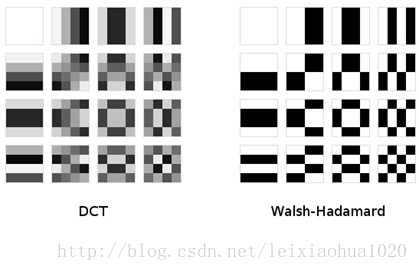
4x4整数DCT变换的公式如下所示。
 ?
?
对该公式中的矩阵乘法可以转换为2次一维DCT变换:首先对4x4块中的每行像素进行一维DCT变换,然后再对4x4块中的每列像素进行一维DCT变换。而一维的DCT变换是可以改造成为蝶形快速算法的,如下所示。
?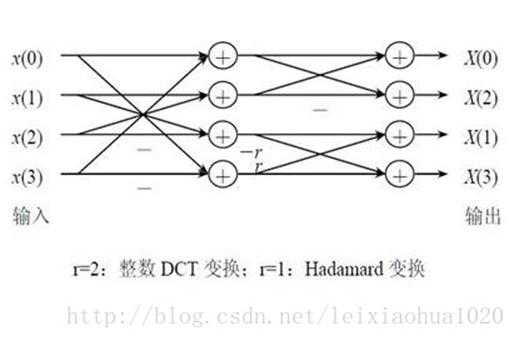
同理,DCT反变换就是DCT变换的逆变换。DCT反变换的公式如下所示。
?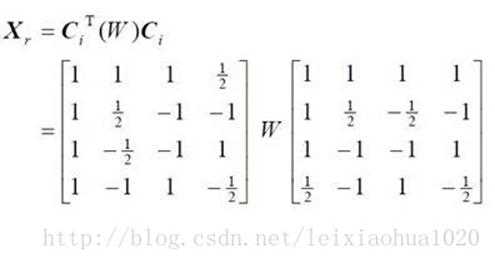
同理,DCT反变换的矩阵乘法也可以改造成为2次一维IDCT变换:首先对4x4块中的每行像素进行一维IDCT变换,然后再对4x4块中的每列像素进行一维IDCT变换。而一维的IDCT变换也可以改造成为蝶形快速算法,如下所示。
?
除了4x4DCT变换之外,新版本的H.264标准中还引入了一种8x8DCT。目前针对这种8x8DCT我还没有做研究,暂时不做记录。
sub4x4_dct()
sub4x4_dct()可以将两块4x4的图像相减求残差后,进行DCT变换。该函数的定义位于common\dct.c,如下所示。
[cpp]
view plaincopy



- /*?
- ?*?求残差用?
- ?*?注意求的是一个"方块"形像素?
- ?*?
- ?*?参数的含义如下:?
- ?*?diff:输出的残差数据?
- ?*?i_size:方块的大小?
- ?*?pix1:输入数据1?
- ?*?i_pix1:输入数据1一行像素大小(stride)?
- ?*?pix2:输入数据2?
- ?*?i_pix2:输入数据2一行像素大小(stride)?
- ?*?
- ?*/??
- static?inline?void?pixel_sub_wxh(?dctcoef?*diff,?int?i_size,??
- ??????????????????????????????????pixel?*pix1,?int?i_pix1,?pixel?*pix2,?int?i_pix2?)??
- {??
- ????for(?int?y?=?0;?y?<?i_size;?y++?)??
- ????{??
- ????????for(?int?x?=?0;?x?<?i_size;?x++?)??
- ????????????diff[x?+?y*i_size]?=?pix1[x]?-?pix2[x];//求残差??
- ????????pix1?+=?i_pix1;//前进到下一行??
- ????????pix2?+=?i_pix2;??
- ????}??
- }??
- //4x4DCT变换??
- //注意首先获取pix1和pix2两块数据的残差,然后再进行变换??
- //返回dct[16]??
- static?void?sub4x4_dct(?dctcoef?dct[16],?pixel?*pix1,?pixel?*pix2?)??
- {??
- ????dctcoef?d[16];??
- ????dctcoef?tmp[16];??
- ????//获取残差数据,存入d[16]??
- ????//pix1一般为编码帧(enc)??
- ????//pix2一般为重建帧(dec)??
- ????pixel_sub_wxh(?d,?4,?pix1,?FENC_STRIDE,?pix2,?FDEC_STRIDE?);??
- ??
- ????//处理残差d[16]??
- ????//蝶形算法:横向4个像素??
- ????for(?int?i?=?0;?i?<?4;?i++?)??
- ????{??
- ????????int?s03?=?d[i*4+0]?+?d[i*4+3];??
- ????????int?s12?=?d[i*4+1]?+?d[i*4+2];??
- ????????int?d03?=?d[i*4+0]?-?d[i*4+3];??
- ????????int?d12?=?d[i*4+1]?-?d[i*4+2];??
- ??
- ????????tmp[0*4+i]?=???s03?+???s12;??
- ????????tmp[1*4+i]?=?2*d03?+???d12;??
- ????????tmp[2*4+i]?=???s03?-???s12;??
- ????????tmp[3*4+i]?=???d03?-?2*d12;??
- ????}??
- ????//蝶形算法:纵向??
- ????for(?int?i?=?0;?i?<?4;?i++?)??
- ????{??
- ????????int?s03?=?tmp[i*4+0]?+?tmp[i*4+3];??
- ????????int?s12?=?tmp[i*4+1]?+?tmp[i*4+2];??
- ????????int?d03?=?tmp[i*4+0]?-?tmp[i*4+3];??
- ????????int?d12?=?tmp[i*4+1]?-?tmp[i*4+2];??
- ??
- ????????dct[i*4+0]?=???s03?+???s12;??
- ????????dct[i*4+1]?=?2*d03?+???d12;??
- ????????dct[i*4+2]?=???s03?-???s12;??
- ????????dct[i*4+3]?=???d03?-?2*d12;??
- ????}??
- }??
从源代码可以看出,sub4x4_dct()首先调用pixel_sub_wxh()求出两个输入图像块的残差,然后使用蝶形快速算法计算残差图像的DCT系数。
add4x4_idct()
add4x4_idct()可以将残差数据进行DCT反变换,并将变换后得到的残差像素数据叠加到预测数据上。该函数的定义位于common\dct.c,如下所示。
[cpp]
view plaincopy



- //4x4DCT反变换("add"代表叠加到已有的像素上)??
- static?void?add4x4_idct(?pixel?*p_dst,?dctcoef?dct[16]?)??
- {??
- ????dctcoef?d[16];??
- ????dctcoef?tmp[16];??
- ??
- ????for(?int?i?=?0;?i?<?4;?i++?)??
- ????{??
- ????????int?s02?=??dct[0*4+i]?????+??dct[2*4+i];??
- ????????int?d02?=??dct[0*4+i]?????-??dct[2*4+i];??
- ????????int?s13?=??dct[1*4+i]?????+?(dct[3*4+i]>>1);??
- ????????int?d13?=?(dct[1*4+i]>>1)?-??dct[3*4+i];??
- ??
- ????????tmp[i*4+0]?=?s02?+?s13;??
- ????????tmp[i*4+1]?=?d02?+?d13;??
- ????????tmp[i*4+2]?=?d02?-?d13;??
- ????????tmp[i*4+3]?=?s02?-?s13;??
- ????}??
- ??
- ????for(?int?i?=?0;?i?<?4;?i++?)??
- ????{??
- ????????int?s02?=??tmp[0*4+i]?????+??tmp[2*4+i];??
- ????????int?d02?=??tmp[0*4+i]?????-??tmp[2*4+i];??
- ????????int?s13?=??tmp[1*4+i]?????+?(tmp[3*4+i]>>1);??
- ????????int?d13?=?(tmp[1*4+i]>>1)?-??tmp[3*4+i];??
- ??
- ????????d[0*4+i]?=?(?s02?+?s13?+?32?)?>>?6;??
- ????????d[1*4+i]?=?(?d02?+?d13?+?32?)?>>?6;??
- ????????d[2*4+i]?=?(?d02?-?d13?+?32?)?>>?6;??
- ????????d[3*4+i]?=?(?s02?-?s13?+?32?)?>>?6;??
- ????}??
- ??
- ??
- ????for(?int?y?=?0;?y?<?4;?y++?)??
- ????{??
- ????????for(?int?x?=?0;?x?<?4;?x++?)??
- ????????????p_dst[x]?=?x264_clip_pixel(?p_dst[x]?+?d[y*4+x]?);??
- ????????p_dst?+=?FDEC_STRIDE;??
- ????}??
- }??
从源代码可以看出,add4x4_idct()首先采用快速蝶形算法对DCT系数进行DCT反变换后得到残差像素数据,然后再将残差数据叠加到p_dst指向的像素上。需要注意这里是"叠加"而不是"赋值"。
sub8x8_dct()
sub8x8_dct()可以将两块8x8的图像相减求残差后,进行4x4DCT变换。该函数的定义位于common\dct.c,如下所示。
[cpp]
view plaincopy



- //8x8块:分解成4个4x4DCT变换,调用4次sub4x4_dct()??
- //返回dct[4][16]??
- static?void?sub8x8_dct(?dctcoef?dct[4][16],?pixel?*pix1,?pixel?*pix2?)??
- {??
- ????/*?
- ?????*?8x8?宏块被划分为4个4x4子块?
- ?????*?
- ?????*?+---+---+?
- ?????*?|?0?|?1?|?
- ?????*?+---+---+?
- ?????*?|?2?|?3?|?
- ?????*?+---+---+?
- ?????*?
- ?????*/??
- ????sub4x4_dct(?dct[0],?&pix1[0],?&pix2[0]?);??
- ????sub4x4_dct(?dct[1],?&pix1[4],?&pix2[4]?);??
- ????sub4x4_dct(?dct[2],?&pix1[4*FENC_STRIDE+0],?&pix2[4*FDEC_STRIDE+0]?);??
- ????sub4x4_dct(?dct[3],?&pix1[4*FENC_STRIDE+4],?&pix2[4*FDEC_STRIDE+4]?);??
- }??
从源代码可以看出, sub8x8_dct()将8x8的图像块分成4个4x4的图像块,分别调用了sub4x4_dct()。
sub16x16_dct()
sub16x16_dct()可以将两块16x16的图像相减求残差后,进行4x4DCT变换。该函数的定义位于common\dct.c,如下所示。
[cpp]
view plaincopy



- //16x16块:分解成4个8x8的块做DCT变换,调用4次sub8x8_dct()??
- //返回dct[16][16]??
- static?void?sub16x16_dct(?dctcoef?dct[16][16],?pixel?*pix1,?pixel?*pix2?)??
- {??
- ????/*?
- ?????*?16x16?宏块被划分为4个8x8子块?
- ?????*?
- ?????*?+--------+--------+?
- ?????*?|????????|????????|?
- ?????*?|???0????|???1????|?
- ?????*?|????????|????????|?
- ?????*?+--------+--------+?
- ?????*?|????????|????????|?
- ?????*?|???2????|???3????|?
- ?????*?|????????|????????|?
- ?????*?+--------+--------+?
- ?????*?
- ?????*/??
- ????sub8x8_dct(?&dct[?0],?&pix1[0],?&pix2[0]?);??//0??
- ????sub8x8_dct(?&dct[?4],?&pix1[8],?&pix2[8]?);??//1??
- ????sub8x8_dct(?&dct[?8],?&pix1[8*FENC_STRIDE+0],?&pix2[8*FDEC_STRIDE+0]?);??//2??
- ????sub8x8_dct(?&dct[12],?&pix1[8*FENC_STRIDE+8],?&pix2[8*FDEC_STRIDE+8]?);??//3??
- }??
从 源代码可以看出, sub8x8_dct()将16x16的图像块分成4个8x8的图像块,分别调用了sub8x8_dct()。而sub8x8_dct()实际上又调用了 4次sub4x4_dct()。所以可以得知,不论sub16x16_dct(),sub8x8_dct()还是sub4x4_dct(),本质都是进行 4x4DCT。
dct4x4dc()
dct4x4dc()可以将输入的4x4图像块进行Hadamard变换。该函数的定义位于common\dct.c,如下所示。
[cpp]
view plaincopy



- //Hadamard变换??
- static?void?dct4x4dc(?dctcoef?d[16]?)??
- {??
- ????dctcoef?tmp[16];??
- ??
- ????//蝶形算法:横向的4个像素??
- ????for(?int?i?=?0;?i?<?4;?i++?)??
- ????{??
- ??
- ????????int?s01?=?d[i*4+0]?+?d[i*4+1];??
- ????????int?d01?=?d[i*4+0]?-?d[i*4+1];??
- ????????int?s23?=?d[i*4+2]?+?d[i*4+3];??
- ????????int?d23?=?d[i*4+2]?-?d[i*4+3];??
- ??
- ????????tmp[0*4+i]?=?s01?+?s23;??
- ????????tmp[1*4+i]?=?s01?-?s23;??
- ????????tmp[2*4+i]?=?d01?-?d23;??
- ????????tmp[3*4+i]?=?d01?+?d23;??
- ????}??
- ????//蝶形算法:纵向??
- ????for(?int?i?=?0;?i?<?4;?i++?)??
- ????{??
- ????????int?s01?=?tmp[i*4+0]?+?tmp[i*4+1];??
- ????????int?d01?=?tmp[i*4+0]?-?tmp[i*4+1];??
- ????????int?s23?=?tmp[i*4+2]?+?tmp[i*4+3];??
- ????????int?d23?=?tmp[i*4+2]?-?tmp[i*4+3];??
- ??
- ????????d[i*4+0]?=?(?s01?+?s23?+?1?)?>>?1;??
- ????????d[i*4+1]?=?(?s01?-?s23?+?1?)?>>?1;??
- ????????d[i*4+2]?=?(?d01?-?d23?+?1?)?>>?1;??
- ????????d[i*4+3]?=?(?d01?+?d23?+?1?)?>>?1;??
- ????}??
- }??
从源代码可以看出,dct4x4dc()实现了Hadamard快速蝶形算法。
x264_mc_init()
x264_mc_init()用于初始化运动补偿相关的汇编函数。该函数的定义位于common\mc.c,如下所示。
[cpp]
view plaincopy



- //运动补偿??
- void?x264_mc_init(?int?cpu,?x264_mc_functions_t?*pf,?int?cpu_independent?)??
- {??
- ????//亮度运动补偿??
- ????pf->mc_luma???=?mc_luma;??
- ????//获得匹配块??
- ????pf->get_ref???=?get_ref;??
- ??
- ????pf->mc_chroma?=?mc_chroma;??
- ????//求平均??
- ????pf->avg[PIXEL_16x16]=?pixel_avg_16x16;??
- ????pf->avg[PIXEL_16x8]?=?pixel_avg_16x8;??
- ????pf->avg[PIXEL_8x16]?=?pixel_avg_8x16;??
- ????pf->avg[PIXEL_8x8]??=?pixel_avg_8x8;??
- ????pf->avg[PIXEL_8x4]??=?pixel_avg_8x4;??
- ????pf->avg[PIXEL_4x16]?=?pixel_avg_4x16;??
- ????pf->avg[PIXEL_4x8]??=?pixel_avg_4x8;??
- ????pf->avg[PIXEL_4x4]??=?pixel_avg_4x4;??
- ????pf->avg[PIXEL_4x2]??=?pixel_avg_4x2;??
- ????pf->avg[PIXEL_2x8]??=?pixel_avg_2x8;??
- ????pf->avg[PIXEL_2x4]??=?pixel_avg_2x4;??
- ????pf->avg[PIXEL_2x2]??=?pixel_avg_2x2;??
- ????//加权相关??
- ????pf->weight????=?x264_mc_weight_wtab;??
- ????pf->offsetadd?=?x264_mc_weight_wtab;??
- ????pf->offsetsub?=?x264_mc_weight_wtab;??
- ????pf->weight_cache?=?x264_weight_cache;??
- ????//赋值-只包含了方形的??
- ????pf->copy_16x16_unaligned?=?mc_copy_w16;??
- ????pf->copy[PIXEL_16x16]?=?mc_copy_w16;??
- ????pf->copy[PIXEL_8x8]???=?mc_copy_w8;??
- ????pf->copy[PIXEL_4x4]???=?mc_copy_w4;??
- ??
- ????pf->store_interleave_chroma???????=?store_interleave_chroma;??
- ????pf->load_deinterleave_chroma_fenc?=?load_deinterleave_chroma_fenc;??
- ????pf->load_deinterleave_chroma_fdec?=?load_deinterleave_chroma_fdec;??
- ????//拷贝像素-不论像素块大小??
- ????pf->plane_copy?=?x264_plane_copy_c;??
- ????pf->plane_copy_interleave?=?x264_plane_copy_interleave_c;??
- ????pf->plane_copy_deinterleave?=?x264_plane_copy_deinterleave_c;??
- ????pf->plane_copy_deinterleave_rgb?=?x264_plane_copy_deinterleave_rgb_c;??
- ????pf->plane_copy_deinterleave_v210?=?x264_plane_copy_deinterleave_v210_c;??
- ????//关键:半像素内插??
- ????pf->hpel_filter?=?hpel_filter;??
- ????//几个空函数??
- ????pf->prefetch_fenc_420?=?prefetch_fenc_null;??
- ????pf->prefetch_fenc_422?=?prefetch_fenc_null;??
- ????pf->prefetch_ref??=?prefetch_ref_null;??
- ????pf->memcpy_aligned?=?memcpy;??
- ????pf->memzero_aligned?=?memzero_aligned;??
- ????//降低分辨率-线性内插(不是半像素内插)??
- ????pf->frame_init_lowres_core?=?frame_init_lowres_core;??
- ??
- ????pf->integral_init4h?=?integral_init4h;??
- ????pf->integral_init8h?=?integral_init8h;??
- ????pf->integral_init4v?=?integral_init4v;??
- ????pf->integral_init8v?=?integral_init8v;??
- ??
- ????pf->mbtree_propagate_cost?=?mbtree_propagate_cost;??
- ????pf->mbtree_propagate_list?=?mbtree_propagate_list;??
- ????//各种汇编版本??
- #if?HAVE_MMX??
- ????x264_mc_init_mmx(?cpu,?pf?);??
- #endif??
- #if?HAVE_ALTIVEC??
- ????if(?cpu&X264_CPU_ALTIVEC?)??
- ????????x264_mc_altivec_init(?pf?);??
- #endif??
- #if?HAVE_ARMV6??
- ????x264_mc_init_arm(?cpu,?pf?);??
- #endif??
- #if?ARCH_AARCH64??
- ????x264_mc_init_aarch64(?cpu,?pf?);??
- #endif??
- ??
- ????if(?cpu_independent?)??
- ????{??
- ????????pf->mbtree_propagate_cost?=?mbtree_propagate_cost;??
- ????????pf->mbtree_propagate_list?=?mbtree_propagate_list;??
- ????}??
- }??
从 源代码可以看出,x264_mc_init()中包含了大量的像素内插、拷贝、求平均的函数。这些函数都是用于在H.264编码过程中进行运动估计和运动 补偿的。x264_mc_init()的参数x264_mc_functions_t是一个结构体,其中包含了运动补偿函数相关的函数接口。 x264_mc_functions_t的定义如下。
[cpp]
view plaincopy



- typedef?struct??
- {??
- ????void?(*mc_luma)(?pixel?*dst,?intptr_t?i_dst,?pixel?**src,?intptr_t?i_src,??
- ?????????????????????int?mvx,?int?mvy,?int?i_width,?int?i_height,?const?x264_weight_t?*weight?);??
- ??
- ????/*?may?round?up?the?dimensions?if?they‘re?not?a?power?of?2?*/??
- ????pixel*?(*get_ref)(?pixel?*dst,?intptr_t?*i_dst,?pixel?**src,?intptr_t?i_src,??
- ???????????????????????int?mvx,?int?mvy,?int?i_width,?int?i_height,?const?x264_weight_t?*weight?);??
- ??
- ????/*?mc_chroma?may?write?up?to?2?bytes?of?garbage?to?the?right?of?dst,?
- ?????*?so?it?must?be?run?from?left?to?right.?*/??
- ????void?(*mc_chroma)(?pixel?*dstu,?pixel?*dstv,?intptr_t?i_dst,?pixel?*src,?intptr_t?i_src,??
- ???????????????????????int?mvx,?int?mvy,?int?i_width,?int?i_height?);??
- ??
- ????void?(*avg[12])(?pixel?*dst,??intptr_t?dst_stride,?pixel?*src1,?intptr_t?src1_stride,??
- ?????????????????????pixel?*src2,?intptr_t?src2_stride,?int?i_weight?);??
- ??
- ????/*?only?16x16,?8x8,?and?4x4?defined?*/??
- ????void?(*copy[7])(?pixel?*dst,?intptr_t?dst_stride,?pixel?*src,?intptr_t?src_stride,?int?i_height?);??
- ????void?(*copy_16x16_unaligned)(?pixel?*dst,?intptr_t?dst_stride,?pixel?*src,?intptr_t?src_stride,?int?i_height?);??
- ??
- ????void?(*store_interleave_chroma)(?pixel?*dst,?intptr_t?i_dst,?pixel?*srcu,?pixel?*srcv,?int?height?);??
- ????void?(*load_deinterleave_chroma_fenc)(?pixel?*dst,?pixel?*src,?intptr_t?i_src,?int?height?);??
- ????void?(*load_deinterleave_chroma_fdec)(?pixel?*dst,?pixel?*src,?intptr_t?i_src,?int?height?);??
- ??
- ????void?(*plane_copy)(?pixel?*dst,?intptr_t?i_dst,?pixel?*src,?intptr_t?i_src,?int?w,?int?h?);??
- ????void?(*plane_copy_interleave)(?pixel?*dst,??intptr_t?i_dst,?pixel?*srcu,?intptr_t?i_srcu,??
- ???????????????????????????????????pixel?*srcv,?intptr_t?i_srcv,?int?w,?int?h?);??
- ????/*?may?write?up?to?15?pixels?off?the?end?of?each?plane?*/??
- ????void?(*plane_copy_deinterleave)(?pixel?*dstu,?intptr_t?i_dstu,?pixel?*dstv,?intptr_t?i_dstv,??
- ?????????????????????????????????????pixel?*src,??intptr_t?i_src,?int?w,?int?h?);??
- ????void?(*plane_copy_deinterleave_rgb)(?pixel?*dsta,?intptr_t?i_dsta,?pixel?*dstb,?intptr_t?i_dstb,??
- ?????????????????????????????????????????pixel?*dstc,?intptr_t?i_dstc,?pixel?*src,??intptr_t?i_src,?int?pw,?int?w,?int?h?);??
- ????void?(*plane_copy_deinterleave_v210)(?pixel?*dsty,?intptr_t?i_dsty,??
- ??????????????????????????????????????????pixel?*dstc,?intptr_t?i_dstc,??
- ??????????????????????????????????????????uint32_t?*src,?intptr_t?i_src,?int?w,?int?h?);??
- ????void?(*hpel_filter)(?pixel?*dsth,?pixel?*dstv,?pixel?*dstc,?pixel?*src,??
- ?????????????????????????intptr_t?i_stride,?int?i_width,?int?i_height,?int16_t?*buf?);??
- ??
- ????/*?prefetch?the?next?few?macroblocks?of?fenc?or?fdec?*/??
- ????void?(*prefetch_fenc)????(?pixel?*pix_y,?intptr_t?stride_y,?pixel?*pix_uv,?intptr_t?stride_uv,?int?mb_x?);??
- ????void?(*prefetch_fenc_420)(?pixel?*pix_y,?intptr_t?stride_y,?pixel?*pix_uv,?intptr_t?stride_uv,?int?mb_x?);??
- ????void?(*prefetch_fenc_422)(?pixel?*pix_y,?intptr_t?stride_y,?pixel?*pix_uv,?intptr_t?stride_uv,?int?mb_x?);??
- ????/*?prefetch?the?next?few?macroblocks?of?a?hpel?reference?frame?*/??
- ????void?(*prefetch_ref)(?pixel?*pix,?intptr_t?stride,?int?parity?);??
- ??
- ????void?*(*memcpy_aligned)(?void?*dst,?const?void?*src,?size_t?n?);??
- ????void?(*memzero_aligned)(?void?*dst,?size_t?n?);??
- ??
- ????/*?successive?elimination?prefilter?*/??
- ????void?(*integral_init4h)(?uint16_t?*sum,?pixel?*pix,?intptr_t?stride?);??
- ????void?(*integral_init8h)(?uint16_t?*sum,?pixel?*pix,?intptr_t?stride?);??
- ????void?(*integral_init4v)(?uint16_t?*sum8,?uint16_t?*sum4,?intptr_t?stride?);??
- ????void?(*integral_init8v)(?uint16_t?*sum8,?intptr_t?stride?);??
- ??
- ????void?(*frame_init_lowres_core)(?pixel?*src0,?pixel?*dst0,?pixel?*dsth,?pixel?*dstv,?pixel?*dstc,??
- ????????????????????????????????????intptr_t?src_stride,?intptr_t?dst_stride,?int?width,?int?height?);??
- ????weight_fn_t?*weight;??
- ????weight_fn_t?*offsetadd;??
- ????weight_fn_t?*offsetsub;??
- ????void?(*weight_cache)(?x264_t?*,?x264_weight_t?*?);??
- ??
- ????void?(*mbtree_propagate_cost)(?int16_t?*dst,?uint16_t?*propagate_in,?uint16_t?*intra_costs,??
- ???????????????????????????????????uint16_t?*inter_costs,?uint16_t?*inv_qscales,?float?*fps_factor,?int?len?);??
- ??
- ????void?(*mbtree_propagate_list)(?x264_t?*h,?uint16_t?*ref_costs,?int16_t?(*mvs)[2],??
- ???????????????????????????????????int16_t?*propagate_amount,?uint16_t?*lowres_costs,??
- ???????????????????????????????????int?bipred_weight,?int?mb_y,?int?len,?int?list?);??
- }?x264_mc_functions_t;??
x264_mc_init() 的工作就是对x264_mc_functions_t中的函数指针进行赋值。由于运动估计和运动补偿在x264中属于相对复杂的环节,其中许多函数的作用 很难三言两语表述出来,因此只举一个相对简单的例子——半像素内插函数hpel_filter()。
相关知识简述
????简 单记录一下半像素插值的知识。《H.264标准》中规定,运动估计为1/4像素精度。因此在H.264编码和解码的过程中,需要将画面中的像素进行插值 ——简单地说就是把原先的1个像素点拓展成4x4一共16个点。下图显示了H.264编码和解码过程中像素插值情况。可以看出原先的G点的右下方通过插值 的方式产生了a、b、c、d等一共16个点。
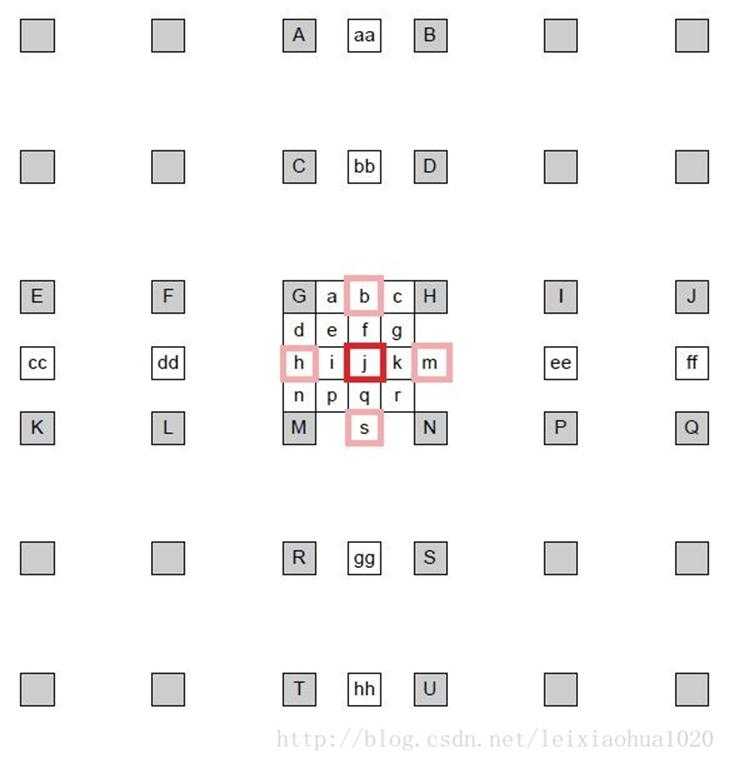
????如图所示,1/4像素内插一般分成两步:
(1)半像素内插。这一步通过6抽头滤波器获得5个半像素点。
(2)线性内插。这一步通过简单的线性内插获得剩余的1/4像素点。
????图中半像素内插点为b、m、h、s、j五个点。半像素内插方法是对整像素点进行6 抽头滤波得出,滤波器的权重为(1/32, -5/32, 5/8, 5/8, -5/32, 1/32)。例如b的计算公式为:
b=round( (E - 5F + 20G + 20H - 5I + J ) / 32)
剩下几个半像素点的计算关系如下:
m:由B、D、H、N、S、U计算
h:由A、C、G、M、R、T计算
s:由K、L、M、N、P、Q计算
j:由cc、dd、h、m、ee、ff计算。需要注意j点的运算量比较大,因为cc、dd、ee、ff都需要通过半像素内插方法进行计算。
在获得半像素点之后,就可以通过简单的线性内插获得1/4像素内插点了。1/4像素内插的方式如下图所示。例如图中a点的计算公式如下:
A=round( (G+b)/2 )
在这里有一点需要注意:位于4个角的e、g、p、r四个点并不是通过j点计算计算的,而是通过b、h、s、m四个半像素点计算的。
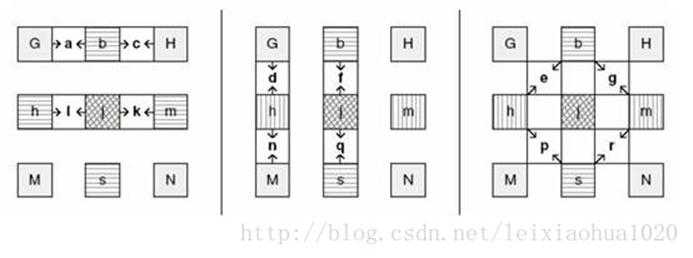
?
hpel_filter()
hpel_filter()用于进行半像素插值。该函数的定义位于common\mc.c,如下所示。
[cpp]
view plaincopy



- //半像素插值公式??
- //b=?(E?-?5F?+?20G?+?20H?-?5I?+?J)/32??
- //??????????????x??
- //d取1,水平滤波器;d取stride,垂直滤波器(这里没有除以32)??
- #define?TAPFILTER(pix,?d)?((pix)[x-2*d]?+?(pix)[x+3*d]?-?5*((pix)[x-d]?+?(pix)[x+2*d])?+?20*((pix)[x]?+?(pix)[x+d]))??
- ??
- /*?
- ?*?半像素插值?
- ?*?dsth:水平滤波得到的半像素点(aa,bb,b,s,gg,hh)?
- ?*?dstv:垂直滤波的到的半像素点(cc,dd,h,m,ee,ff)?
- ?*?dstc:"水平+垂直"滤波得到的位于4个像素中间的半像素点(j)?
- ?*?
- ?*?半像素插值示意图如下:?
- ?*?
- ?*?????????A?aa?B?
- ?*?
- ?*?????????C?bb?D?
- ?*?
- ?*?E???F???G??b?H???I???J?
- ?*?
- ?*?cc??dd??h??j?m??ee??ff?
- ?*?
- ?*?K???L???M??s?N???P???Q?
- ?*?
- ?*?????????R?gg?S?
- ?*?
- ?*?????????T?hh?U?
- ?*?
- ?*?计算公式如下:?
- ?*?b=round(?(E?-?5F?+?20G?+?20H?-?5I?+?J?)?/?32)?
- ?*?
- ?*?剩下几个半像素点的计算关系如下:?
- ?*?m:由B、D、H、N、S、U计算?
- ?*?h:由A、C、G、M、R、T计算?
- ?*?s:由K、L、M、N、P、Q计算?
- ?*?j:由cc、dd、h、m、ee、ff计算。需要注意j点的运算量比较大,因为cc、dd、ee、ff都需要通过半像素内插方法进行计算。?
- ?*?
- ?*/??
- static?void?hpel_filter(?pixel?*dsth,?pixel?*dstv,?pixel?*dstc,?pixel?*src,??
- ?????????????????????????intptr_t?stride,?int?width,?int?height,?int16_t?*buf?)??
- {??
- ????const?int?pad?=?(BIT_DEPTH?>?9)???(-10?*?PIXEL_MAX)?:?0;??
- ????/*?
- ?????*?几种半像素点之间的位置关系?
- ?????*?
- ?????*?X:?像素点?
- ?????*?H:水平滤波半像素点?
- ?????*?V:垂直滤波半像素点?
- ?????*?C:?中间位置半像素点?
- ?????*?
- ?????*?X???H???X???????X???????X?
- ?????*?
- ?????*?V???C?
- ?????*?
- ?????*?X???????X???????X???????X?
- ?????*?
- ?????*?
- ?????*?
- ?????*?X???????X???????X???????X?
- ?????*?
- ?????*/??
- ????//一行一行处理??
- ????for(?int?y?=?0;?y?<?height;?y++?)??
- ????{??
- ????????//一个一个点处理??
- ????????//每个整像素点都对应h,v,c三个半像素点??
- ????????//v??
- ????????for(?int?x?=?-2;?x?<?width+3;?x++?)//(aa,bb,b,s,gg,hh),结果存入buf??
- ????????{??
- ????????????//垂直滤波半像素点??
- ????????????int?v?=?TAPFILTER(src,stride);??
- ????????????dstv[x]?=?x264_clip_pixel(?(v?+?16)?>>?5?);??
- ????????????/*?transform?v?for?storage?in?a?16-bit?integer?*/??
- ????????????//这应该是给dstc计算使用的???
- ????????????buf[x+2]?=?v?+?pad;??
- ????????}??
- ????????//c??
- ????????for(?int?x?=?0;?x?<?width;?x++?)??
- ????????????dstc[x]?=?x264_clip_pixel(?(TAPFILTER(buf+2,1)?-?32*pad?+?512)?>>?10?);//四个相邻像素中间的半像素点??
- ????????//h??
- ????????for(?int?x?=?0;?x?<?width;?x++?)??
- ????????????dsth[x]?=?x264_clip_pixel(?(TAPFILTER(src,1)?+?16)?>>?5?);//水平滤波半像素点??
- ????????dsth?+=?stride;??
- ????????dstv?+=?stride;??
- ????????dstc?+=?stride;??
- ????????src?+=?stride;??
- ????}??
- }??
?
从 源代码可以看出,hpel_filter()中包含了一个宏TAPFILTER()用来完成半像素点像素值的计算。在完成半像素插值工作后,dsth中存 储的是经过水平插值后的半像素点,dstv中存储的是经过垂直插值后的半像素点,dstc中存储的是位于4个相邻像素点中间位置的半像素点。这三块内存中 的点的位置关系如下图所示(灰色的点是整像素点)。
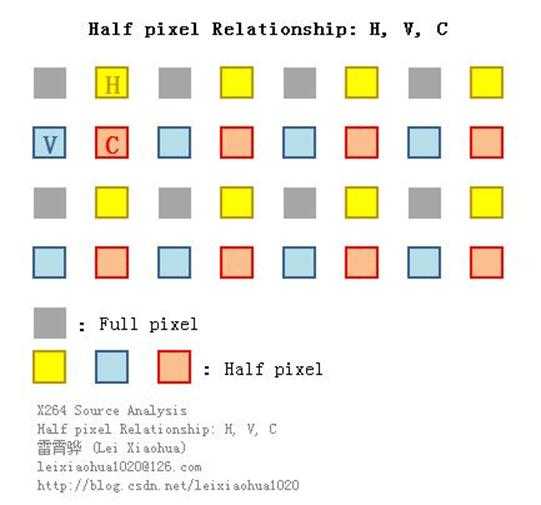
?
x264_quant_init()
x264_quant_init()初始化量化和反量化相关的汇编函数。该函数的定义位于common\quant.c,如下所示。
[cpp]
view plaincopy



- //量化??
- void?x264_quant_init(?x264_t?*h,?int?cpu,?x264_quant_function_t?*pf?)??
- {??
- ????//这个好像是针对8x8DCT的??
- ????pf->quant_8x8?=?quant_8x8;??
- ??
- ????//量化4x4=16个??
- ????pf->quant_4x4?=?quant_4x4;??
- ????//注意:处理4个4x4的块??
- ????pf->quant_4x4x4?=?quant_4x4x4;??
- ????//Intra16x16中,16个DC系数Hadamard变换后对的它们量化??
- ????pf->quant_4x4_dc?=?quant_4x4_dc;??
- ????pf->quant_2x2_dc?=?quant_2x2_dc;??
- ????//反量化4x4=16个??
- ????pf->dequant_4x4?=?dequant_4x4;??
- ????pf->dequant_4x4_dc?=?dequant_4x4_dc;??
- ????pf->dequant_8x8?=?dequant_8x8;??
- ??
- ????pf->idct_dequant_2x4_dc?=?idct_dequant_2x4_dc;??
- ????pf->idct_dequant_2x4_dconly?=?idct_dequant_2x4_dconly;??
- ??
- ????pf->optimize_chroma_2x2_dc?=?optimize_chroma_2x2_dc;??
- ????pf->optimize_chroma_2x4_dc?=?optimize_chroma_2x4_dc;??
- ??
- ????pf->denoise_dct?=?x264_denoise_dct;??
- ????pf->decimate_score15?=?x264_decimate_score15;??
- ????pf->decimate_score16?=?x264_decimate_score16;??
- ????pf->decimate_score64?=?x264_decimate_score64;??
- ??
- ????pf->coeff_last4?=?x264_coeff_last4;??
- ????pf->coeff_last8?=?x264_coeff_last8;??
- ????pf->coeff_last[??DCT_LUMA_AC]?=?x264_coeff_last15;??
- ????pf->coeff_last[?DCT_LUMA_4x4]?=?x264_coeff_last16;??
- ????pf->coeff_last[?DCT_LUMA_8x8]?=?x264_coeff_last64;??
- ????pf->coeff_level_run4?=?x264_coeff_level_run4;??
- ????pf->coeff_level_run8?=?x264_coeff_level_run8;??
- ????pf->coeff_level_run[??DCT_LUMA_AC]?=?x264_coeff_level_run15;??
- ????pf->coeff_level_run[?DCT_LUMA_4x4]?=?x264_coeff_level_run16;??
- ??
- #if?HIGH_BIT_DEPTH??
- #if?HAVE_MMX??
- ????INIT_TRELLIS(?sse2?);??
- ????if(?cpu&X264_CPU_MMX2?)??
- ????{??
- #if?ARCH_X86??
- ????????pf->denoise_dct?=?x264_denoise_dct_mmx;??
- ????????pf->decimate_score15?=?x264_decimate_score15_mmx2;??
- ????????pf->decimate_score16?=?x264_decimate_score16_mmx2;??
- ????????pf->decimate_score64?=?x264_decimate_score64_mmx2;??
- ????????pf->coeff_last8?=?x264_coeff_last8_mmx2;??
- ????????pf->coeff_last[??DCT_LUMA_AC]?=?x264_coeff_last15_mmx2;??
- ????????pf->coeff_last[?DCT_LUMA_4x4]?=?x264_coeff_last16_mmx2;??
- ????????pf->coeff_last[?DCT_LUMA_8x8]?=?x264_coeff_last64_mmx2;??
- ????????pf->coeff_level_run8?=?x264_coeff_level_run8_mmx2;??
- ????????pf->coeff_level_run[??DCT_LUMA_AC]?=?x264_coeff_level_run15_mmx2;??
- ????????pf->coeff_level_run[?DCT_LUMA_4x4]?=?x264_coeff_level_run16_mmx2;??
- #endif??
- ????????pf->coeff_last4?=?x264_coeff_last4_mmx2;??
- ????????pf->coeff_level_run4?=?x264_coeff_level_run4_mmx2;??
- ????????if(?cpu&X264_CPU_LZCNT?)??
- ????????????pf->coeff_level_run4?=?x264_coeff_level_run4_mmx2_lzcnt;??
- ????}??
- ????//此处省略大量的X86、ARM等平台的汇编函数初始化代码??
- }??
从源代码可以看出,x264_quant_init ()初始化了一系列的量化相关的函数。它的输入参数x264_quant_function_t是一个结构体,其中包含了和量化相关各种函数指针。x264_quant_function_t的定义如下所示。
[cpp]
view plaincopy



- typedef?struct??
- {??
- ????int?(*quant_8x8)??(?dctcoef?dct[64],?udctcoef?mf[64],?udctcoef?bias[64]?);??
- ????int?(*quant_4x4)??(?dctcoef?dct[16],?udctcoef?mf[16],?udctcoef?bias[16]?);??
- ????int?(*quant_4x4x4)(?dctcoef?dct[4][16],?udctcoef?mf[16],?udctcoef?bias[16]?);??
- ????int?(*quant_4x4_dc)(?dctcoef?dct[16],?int?mf,?int?bias?);??
- ????int?(*quant_2x2_dc)(?dctcoef?dct[4],?int?mf,?int?bias?);??
- ??
- ????void?(*dequant_8x8)(?dctcoef?dct[64],?int?dequant_mf[6][64],?int?i_qp?);??
- ????void?(*dequant_4x4)(?dctcoef?dct[16],?int?dequant_mf[6][16],?int?i_qp?);??
- ????void?(*dequant_4x4_dc)(?dctcoef?dct[16],?int?dequant_mf[6][16],?int?i_qp?);??
- ??
- ????void?(*idct_dequant_2x4_dc)(?dctcoef?dct[8],?dctcoef?dct4x4[8][16],?int?dequant_mf[6][16],?int?i_qp?);??
- ????void?(*idct_dequant_2x4_dconly)(?dctcoef?dct[8],?int?dequant_mf[6][16],?int?i_qp?);??
- ??
- ????int?(*optimize_chroma_2x2_dc)(?dctcoef?dct[4],?int?dequant_mf?);??
- ????int?(*optimize_chroma_2x4_dc)(?dctcoef?dct[8],?int?dequant_mf?);??
- ??
- ????void?(*denoise_dct)(?dctcoef?*dct,?uint32_t?*sum,?udctcoef?*offset,?int?size?);??
- ??
- ????int?(*decimate_score15)(?dctcoef?*dct?);??
- ????int?(*decimate_score16)(?dctcoef?*dct?);??
- ????int?(*decimate_score64)(?dctcoef?*dct?);??
- ????int?(*coeff_last[14])(?dctcoef?*dct?);??
- ????int?(*coeff_last4)(?dctcoef?*dct?);??
- ????int?(*coeff_last8)(?dctcoef?*dct?);??
- ????int?(*coeff_level_run[13])(?dctcoef?*dct,?x264_run_level_t?*runlevel?);??
- ????int?(*coeff_level_run4)(?dctcoef?*dct,?x264_run_level_t?*runlevel?);??
- ????int?(*coeff_level_run8)(?dctcoef?*dct,?x264_run_level_t?*runlevel?);??
- ??
- #define?TRELLIS_PARAMS?const?int?*unquant_mf,?const?uint8_t?*zigzag,?int?lambda2,\??
- ???????????????????????int?last_nnz,?dctcoef?*coefs,?dctcoef?*quant_coefs,?dctcoef?*dct,\??
- ???????????????????????uint8_t?*cabac_state_sig,?uint8_t?*cabac_state_last,\??
- ???????????????????????uint64_t?level_state0,?uint16_t?level_state1??
- ????int?(*trellis_cabac_4x4)(?TRELLIS_PARAMS,?int?b_ac?);??
- ????int?(*trellis_cabac_8x8)(?TRELLIS_PARAMS,?int?b_interlaced?);??
- ????int?(*trellis_cabac_4x4_psy)(?TRELLIS_PARAMS,?int?b_ac,?dctcoef?*fenc_dct,?int?psy_trellis?);??
- ????int?(*trellis_cabac_8x8_psy)(?TRELLIS_PARAMS,?int?b_interlaced,?dctcoef?*fenc_dct,?int?psy_trellis?);??
- ????int?(*trellis_cabac_dc)(?TRELLIS_PARAMS,?int?num_coefs?);??
- ????int?(*trellis_cabac_chroma_422_dc)(?TRELLIS_PARAMS?);??
- }?x264_quant_function_t;??
x264_quant_init ()的工作就是对x264_quant_function_t中的函数指针进行赋值。下文举例分析其中2个函数:4x4矩阵量化函数quant_4x4(),4个4x4矩阵量化函数quant_4x4x4()。
相关知识简述
????简单记录一下量化的概念。量化是H.264视频压缩编码中对视频质量影响最大的地方,也是会导致"信息丢失"的地方。量化的原理可以表示为下面公式:
FQ=round(y/Qstep)
????其中,y 为输入样本点编码,Qstep为量化步长,FQ 为y 的量化值,round()为取整函数(其输出为与输入实数最近的整数)。其相反过程,即反量化为:
y‘=FQ*Qstep
????如果Qstep较大,则量化值FQ取值较小,其相应的编码长度较小,但是但反量化时损失较多的图像细节信息。简而言之,Qstep越大,视频压缩编码后体积越小,视频质量越差。
????在H.264 中,量化步长Qstep 共有52 个值,如下表所示。其中QP 是量化参数,是量化步长的序号。当QP 取最小值0 时代表最精细的量化,当QP 取最大值51 时代表最粗糙的量化。QP 每增加6,Qstep 增加一倍。
?
????《H.264标准》中规定,量化过程除了完成本职工作外,还需要完成它前一步DCT变换中"系数相乘"的工作。这一步骤的推导过程不再记录,直接给出最终的公式(这个公式完全为整数运算,同时避免了除法的使用):
|Zij| = (|Wij|*MF + f)>>qbits
sign(Zij) = sign (Wij)
其中:
sign()为符号函数。
Wij为DCT变换后的系数。
MF的值如下表所示。表中只列出对应QP 值为0 到5 的MF 值。QP大于6之后,将QP实行对6取余数操作,再找到MF的值。
qbits计算公式为"qbits = 15 + floor(QP/6)"。即它的值随QP 值每增加6 而增加1。
f 是偏移量(用于改善恢复图像的视觉效果)。对帧内预测图像块取2^qbits/3,对帧间预测图像块取2^qbits/6。
?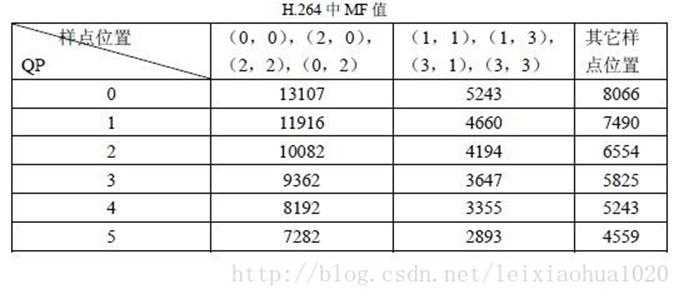
为了更形象的显示MF的取值,做了下面一张示意图。图中深蓝色代表MF取值较大的点,而浅蓝色代表MF取值较小的点。
?
?
quant_4x4()
quant_4x4()用于对4x4的DCT残差矩阵进行量化。该函数的定义位于common\quant.c,如下所示。
[cpp]
view plaincopy



- //4x4量化??
- //输入输出都是dct[16]??
- static?int?quant_4x4(?dctcoef?dct[16],?udctcoef?mf[16],?udctcoef?bias[16]?)??
- {??
- ????int?nz?=?0;??
- ????//循环16个元素??
- ????for(?int?i?=?0;?i?<?16;?i++?)??
- ????????QUANT_ONE(?dct[i],?mf[i],?bias[i]?);??
- ????return?!!nz;??
- }??
可以看出quant_4x4()循环16次调用了QUANT_ONE()完成了量化工作。并且将DCT系数值,MF值,bias偏移值直接传递给了该宏。
QUANT_ONE()
QUANT_ONE()完成了一个DCT系数的量化工作,它的定义如下。
[cpp]
view plaincopy



- //量化1个元素??
- #define?QUANT_ONE(?coef,?mf,?f?)?\??
- {?\??
- ????if(?(coef)?>?0?)?\??
- ????????(coef)?=?(f?+?(coef))?*?(mf)?>>?16;?\??
- ????else?\??
- ????????(coef)?=?-?((f?-?(coef))?*?(mf)?>>?16);?\??
- ????nz?|=?(coef);?\??
- }??
从QUANT_ONE()的定义可以看出,它实现了上文提到的H.264标准中的量化公式。
quant_4x4x4()
quant_4x4x4()用于对4个4x4的DCT残差矩阵进行量化。该函数的定义位于common\quant.c,如下所示。
[cpp]
view plaincopy



- //处理4个4x4量化??
- //输入输出都是dct[4][16]??
- static?int?quant_4x4x4(?dctcoef?dct[4][16],?udctcoef?mf[16],?udctcoef?bias[16]?)??
- {??
- ????int?nza?=?0;??
- ????//处理4个??
- ????for(?int?j?=?0;?j?<?4;?j++?)??
- ????{??
- ????????int?nz?=?0;??
- ????????//量化??
- ????????for(?int?i?=?0;?i?<?16;?i++?)??
- ????????????QUANT_ONE(?dct[j][i],?mf[i],?bias[i]?);??
- ????????nza?|=?(!!nz)<<j;??
- ????}??
- ????return?nza;??
- }??
从quant_4x4x4()的定义可以看出,该函数相当于调用了4次quant_4x4()函数。
x264_deblock_init()
x264_deblock_init()用于初始化去块效应滤波器相关的汇编函数。该函数的定义位于common\deblock.c,如下所示。
[cpp]
view plaincopy



- //去块效应滤波??
- void?x264_deblock_init(?int?cpu,?x264_deblock_function_t?*pf,?int?b_mbaff?)??
- {??
- ????//注意:标记"v"的垂直滤波器是处理水平边界用的??
- ????//亮度-普通滤波器-边界强度Bs=1,2,3??
- ????pf->deblock_luma[1]?=?deblock_v_luma_c;??
- ????pf->deblock_luma[0]?=?deblock_h_luma_c;??
- ????//色度的??
- ????pf->deblock_chroma[1]?=?deblock_v_chroma_c;??
- ????pf->deblock_h_chroma_420?=?deblock_h_chroma_c;??
- ????pf->deblock_h_chroma_422?=?deblock_h_chroma_422_c;??
- ????//亮度-强滤波器-边界强度Bs=4??
- ????pf->deblock_luma_intra[1]?=?deblock_v_luma_intra_c;??
- ????pf->deblock_luma_intra[0]?=?deblock_h_luma_intra_c;??
- ????pf->deblock_chroma_intra[1]?=?deblock_v_chroma_intra_c;??
- ????pf->deblock_h_chroma_420_intra?=?deblock_h_chroma_intra_c;??
- ????pf->deblock_h_chroma_422_intra?=?deblock_h_chroma_422_intra_c;??
- ????pf->deblock_luma_mbaff?=?deblock_h_luma_mbaff_c;??
- ????pf->deblock_chroma_420_mbaff?=?deblock_h_chroma_mbaff_c;??
- ????pf->deblock_luma_intra_mbaff?=?deblock_h_luma_intra_mbaff_c;??
- ????pf->deblock_chroma_420_intra_mbaff?=?deblock_h_chroma_intra_mbaff_c;??
- ????pf->deblock_strength?=?deblock_strength_c;??
- ??
- #if?HAVE_MMX??
- ????if(?cpu&X264_CPU_MMX2?)??
- ????{??
- #if?ARCH_X86??
- ????????pf->deblock_luma[1]?=?x264_deblock_v_luma_mmx2;??
- ????????pf->deblock_luma[0]?=?x264_deblock_h_luma_mmx2;??
- ????????pf->deblock_chroma[1]?=?x264_deblock_v_chroma_mmx2;??
- ????????pf->deblock_h_chroma_420?=?x264_deblock_h_chroma_mmx2;??
- ????????pf->deblock_chroma_420_mbaff?=?x264_deblock_h_chroma_mbaff_mmx2;??
- ????????pf->deblock_h_chroma_422?=?x264_deblock_h_chroma_422_mmx2;??
- ????????pf->deblock_h_chroma_422_intra?=?x264_deblock_h_chroma_422_intra_mmx2;??
- ????????pf->deblock_luma_intra[1]?=?x264_deblock_v_luma_intra_mmx2;??
- ????????pf->deblock_luma_intra[0]?=?x264_deblock_h_luma_intra_mmx2;??
- ????????pf->deblock_chroma_intra[1]?=?x264_deblock_v_chroma_intra_mmx2;??
- ????????pf->deblock_h_chroma_420_intra?=?x264_deblock_h_chroma_intra_mmx2;??
- ????????pf->deblock_chroma_420_intra_mbaff?=?x264_deblock_h_chroma_intra_mbaff_mmx2;??
- #endif??
- ????//此处省略大量的X86、ARM等平台的汇编函数初始化代码??
- }??
从源代码可以看出,x264_deblock_init()中初始化了一系列环路滤波函数。这些函数名称的规则如下:
(1)包含"v"的是垂直滤波器,用于处理水平边界;包含"h"的是水平滤波器,用于处理垂直边界。
(2)包含"luma"的是亮度滤波器,包含"chroma"的是色度滤波器。
(3)包含"intra"的是处理边界强度Bs为4的强滤波器,不包含"intra"的是普通滤波器。
x264_deblock_init()的输入参数x264_deblock_function_t是一个结构体,其中包含了环路滤波器相关的函数指针。x264_deblock_function_t的定义如下所示。
[cpp]
view plaincopy



- typedef?struct??
- {??
- ????x264_deblock_inter_t?deblock_luma[2];??
- ????x264_deblock_inter_t?deblock_chroma[2];??
- ????x264_deblock_inter_t?deblock_h_chroma_420;??
- ????x264_deblock_inter_t?deblock_h_chroma_422;??
- ????x264_deblock_intra_t?deblock_luma_intra[2];??
- ????x264_deblock_intra_t?deblock_chroma_intra[2];??
- ????x264_deblock_intra_t?deblock_h_chroma_420_intra;??
- ????x264_deblock_intra_t?deblock_h_chroma_422_intra;??
- ????x264_deblock_inter_t?deblock_luma_mbaff;??
- ????x264_deblock_inter_t?deblock_chroma_mbaff;??
- ????x264_deblock_inter_t?deblock_chroma_420_mbaff;??
- ????x264_deblock_inter_t?deblock_chroma_422_mbaff;??
- ????x264_deblock_intra_t?deblock_luma_intra_mbaff;??
- ????x264_deblock_intra_t?deblock_chroma_intra_mbaff;??
- ????x264_deblock_intra_t?deblock_chroma_420_intra_mbaff;??
- ????x264_deblock_intra_t?deblock_chroma_422_intra_mbaff;??
- ????void?(*deblock_strength)?(?uint8_t?nnz[X264_SCAN8_SIZE],?int8_t?ref[2][X264_SCAN8_LUMA_SIZE],??
- ???????????????????????????????int16_t?mv[2][X264_SCAN8_LUMA_SIZE][2],?uint8_t?bs[2][8][4],?int?mvy_limit,??
- ???????????????????????????????int?bframe?);??
- }?x264_deblock_function_t;??
x264_deblock_init() 的工作就是对x264_deblock_function_t中的函数指针进行赋值。可以看出x264_deblock_function_t中很多的元 素是一个包含2个元素的数组,例如deblock_luma[2],deblock_luma_intra[2]等。这些数组中的元素[0]一般是水平滤 波器,而元素[1]是垂直滤波器。下文将会举例分析一个普通边界的亮度垂直滤波器函数deblock_v_luma_c()。
相关知识简述
????简单记录一下环路滤波(去块效应滤波)的知识。X264的重建帧(通过解码得到)一般情况下会出现方块效应。产生这种效应的原因主要有两个:
(1)DCT变换后的量化造成误差(主要原因)。
(2)运动补偿
????正是由于这种块效应的存在,才需要添加环路滤波器调整相邻的"块"边缘上的像素值以减轻这种视觉上的不连续感。下面一张图显示了环路滤波的效果。图中左边的图没有使用环路滤波,而右边的图使用了环路滤波。
?
环路滤波分类
????环路滤波器根据滤波的强度可以分为两种:
????(1)普通滤波器。针对边界的Bs(边界强度)为1、2、3的滤波器。此时环路滤波涉及到方块边界周围的6个点(边界两边各3个点):p2,p1,p0,q0,q1,q2。需要处理4个点(边界两边各2个点,只以p点为例):
p0‘ = p0 + (((q0 - p0 ) << 2) + (p1 - q1) + 4) >> 3
p1‘ = ( p2 + ( ( p0 + q0 + 1 ) >> 1) – 2p1 ) >> 1
????(2)强滤波器。针对边界的Bs(边界强度)为4的滤波器。此时环路滤波涉及到方块边界周围的8个点(边界两边各4个点):p3,p2,p1,p0,q0,q1,q2,q3。需要处理6个点(边界两边各3个点,只以p点为例):
p0‘ = ( p2 + 2*p1 + 2*p0 + 2*q0 + q1 + 4 ) >> 3
p1‘ = ( p2 + p1 + p0 + q0 + 2 ) >> 2
p2‘ = ( 2*p3 + 3*p2 + p1 + p0 + q0 + 4 ) >> 3
????其中上文中提到的边界强度Bs的判定方式如下。
条件(针对两边的图像块) | Bs? |
有一个块为帧内预测 + 边界为宏块边界 | 4? |
有一个块为帧内预测 | 3? |
有一个块对残差编码 | 2? |
运动矢量差不小于1像素 | 1? |
运动补偿参考帧不同 | 1? |
其它 | 0? |
????总体说来,与帧内预测相关的图像块(帧内预测块)的边界强度比较大,取值为3或者4;与运动补偿相关的图像块(帧间预测块)的边界强度比较小,取值为1。
环路滤波的门限
????并 不是所有的块的边界处都需要环路滤波。例如画面中物体的边界正好和块的边界重合的话,就不能进行滤波,否则会使画面中物体的边界变模糊。因此需要区别开物 体边界和块效应边界。一般情况下,物体边界两边的像素值差别很大,而块效应边界两边像素值差别比较小。《H.264标准》以这个特点定义了2个变量 alpha和beta来判决边界是否需要进行环路滤波。只有满足下面三个条件的时候才能进行环路滤波:
| p0 - q0 | < alpha
| p1 – p0 | < beta
| q1 - q0 | < beta
????简 而言之,就是边界两边的两个点的像素值不能太大,即不能超过alpha;边界一边的前两个点之间的像素值也不能太大,即不能超过beta。其中alpha 和beta是根据量化参数QP推算出来(具体方法不再记录)。总体说来QP越大,alpha和beta的值也越大,也就越容易触发环路滤波。由于QP越大 表明压缩的程度越大,所以也可以得知高压缩比的情况下更需要进行环路滤波。
deblock_v_luma_c()
deblock_v_luma_c()是一个普通强度的垂直滤波器,用于处理边界强度Bs为1,2,3的水平边界。该函数的定义位于common\deblock.c,如下所示。
[cpp]
view plaincopy



- //去块效应滤波-普通滤波,Bs为1,2,3??
- //垂直(Vertical)滤波器??
- //??????边界??
- //?????????x??
- //?????????x??
- //?边界----------??
- //?????????x??
- //?????????x??
- //??
- //??
- static?void?deblock_v_luma_c(?pixel?*pix,?intptr_t?stride,?int?alpha,?int?beta,?int8_t?*tc0?)??
- {??
- ????//xstride=stride(用于选择滤波的像素)??
- ????//ystride=1??
- ????deblock_luma_c(?pix,?stride,?1,?alpha,?beta,?tc0?);??
- }??
可 以看出deblock_v_luma_c()调用了另一个函数deblock_luma_c()。需要注意传递给deblock_luma_c()是一个 水平滤波器和垂直滤波器都会调用的"通用"滤波器函数。在这里传递给deblock_luma_c()第二个参数xstride的值为stride,第三 个参数ystride的值为1。
deblock_luma_c()
deblock_luma_c()是一个通用的滤波器函数,定义如下所示。
[cpp]
view plaincopy



- //去块效应滤波-普通滤波,Bs为1,2,3??
- static?inline?void?deblock_luma_c(?pixel?*pix,?intptr_t?xstride,?intptr_t?ystride,?int?alpha,?int?beta,?int8_t?*tc0?)??
- {??
- ????for(?int?i?=?0;?i?<?4;?i++?)??
- ????{??
- ????????if(?tc0[i]?<?0?)??
- ????????{??
- ????????????pix?+=?4*ystride;??
- ????????????continue;??
- ????????}??
- ????????//滤4个像素??
- ????????for(?int?d?=?0;?d?<?4;?d++,?pix?+=?ystride?)??
- ????????????deblock_edge_luma_c(?pix,?xstride,?alpha,?beta,?tc0[i]?);??
- ????}??
- }??
从源代码中可以看出,具体的滤波在deblock_edge_luma_c()中完成。处理完一个像素后,会继续处理与当前像素距离为ystride的像素。
deblock_edge_luma_c()
deblock_edge_luma_c()用于完成具体的滤波工作。该函数的定义如下所示。
[cpp]
view plaincopy



- /*?From?ffmpeg?*/??
- //去块效应滤波-普通滤波,Bs为1,2,3??
- //从FFmpeg复制过来的???
- static?ALWAYS_INLINE?void?deblock_edge_luma_c(?pixel?*pix,?intptr_t?xstride,?int?alpha,?int?beta,?int8_t?tc0?)??
- {??
- ????//p和q??
- ????//如果xstride=stride,ystride=1??
- ????//就是处理纵向的6个像素??
- ????//对应的是方块的横向边界的滤波,即如下所示:??
- ????//????????p2??
- ????//????????p1??
- ????//????????p0??
- ????//=====图像边界=====??
- ????//????????q0??
- ????//????????q1??
- ????//????????q2??
- ????//??
- ????//如果xstride=1,ystride=stride??
- ????//就是处理纵向的6个像素??
- ????//对应的是方块的横向边界的滤波,即如下所示:??
- ????//??????????||??
- ????//?p2?p1?p0?||?q0?q1?q2??
- ????//??????????||??
- ????//??????????边界??
- ??
- ????//注意:这里乘的是xstride??
- ??
- ????int?p2?=?pix[-3*xstride];??
- ????int?p1?=?pix[-2*xstride];??
- ????int?p0?=?pix[-1*xstride];??
- ????int?q0?=?pix[?0*xstride];??
- ????int?q1?=?pix[?1*xstride];??
- ????int?q2?=?pix[?2*xstride];??
- ????//计算方法参考相关的标准??
- ????//alpha和beta是用于检查图像内容的2个参数??
- ????//只有满足if()里面3个取值条件的时候(只涉及边界旁边的4个点),才会滤波??
- ????if(?abs(?p0?-?q0?)?<?alpha?&&?abs(?p1?-?p0?)?<?beta?&&?abs(?q1?-?q0?)?<?beta?)??
- ????{??
- ????????int?tc?=?tc0;??
- ????????int?delta;??
- ????????//上面2个点(p0,p2)满足条件的时候,滤波p1??
- ????????//int?x264_clip3(?int?v,?int?i_min,?int?i_max?)用于限幅??
- ????????if(?abs(?p2?-?p0?)?<?beta?)??
- ????????{??
- ????????????if(?tc0?)??
- ????????????????pix[-2*xstride]?=?p1?+?x264_clip3(?((?p2?+?((p0?+?q0?+?1)?>>?1))?>>?1)?-?p1,?-tc0,?tc0?);??
- ????????????tc++;??
- ????????}??
- ????????//下面2个点(q0,q2)满足条件的时候,滤波q1??
- ????????if(?abs(?q2?-?q0?)?<?beta?)??
- ????????{??
- ????????????if(?tc0?)??
- ????????????????pix[?1*xstride]?=?q1?+?x264_clip3(?((?q2?+?((p0?+?q0?+?1)?>>?1))?>>?1)?-?q1,?-tc0,?tc0?);??
- ????????????tc++;??
- ????????}??
- ??
- ????????delta?=?x264_clip3(?(((q0?-?p0?)?<<?2)?+?(p1?-?q1)?+?4)?>>?3,?-tc,?tc?);??
- ????????//p0??
- ????????pix[-1*xstride]?=?x264_clip_pixel(?p0?+?delta?);????/*?p0‘?*/??
- ????????//q0??
- ????????pix[?0*xstride]?=?x264_clip_pixel(?q0?-?delta?);????/*?q0‘?*/??
- ????}??
- }??
从源代码可以看出,deblock_edge_luma_c()实现了前文记录的滤波公式。
deblock_h_luma_c()
deblock_h_luma_c()是一个普通强度的水平滤波器,用于处理边界强度Bs为1,2,3的垂直边界。该函数的定义如下所示。
[cpp]
view plaincopy



- //去块效应滤波-普通滤波,Bs为1,2,3??
- //水平(Horizontal)滤波器??
- //??????边界??
- //???????|??
- //?x?x?x?|?x?x?x??
- //???????|??
- static?void?deblock_h_luma_c(?pixel?*pix,?intptr_t?stride,?int?alpha,?int?beta,?int8_t?*tc0?)??
- {??
- ????//xstride=1(用于选择滤波的像素)??
- ????//ystride=stride??
- ????deblock_luma_c(?pix,?1,?stride,?alpha,?beta,?tc0?);??
- }??
从 源代码可以看出,和deblock_v_luma_c()类似,deblock_h_luma_c()同样调用了deblock_luma_c()函数。 唯一的不同在于它传递给deblock_luma_c()的第2个参数xstride为1,第3个参数ystride为stride。
mbcmp_init()
mbcmp_init()函数决定了x264_pixel_function_t中的像素比较的一系列函数(mbcmp[])使用SAD还是SATD。该函数的定义位于encoder\encoder.c,如下所示。
[cpp]
view plaincopy



- //决定了像素比较的时候用SAD还是SATD??
- static?void?mbcmp_init(?x264_t?*h?)??
- {??
- ????//b_lossless一般为0??
- ????//主要看i_subpel_refine,大于1的话就使用SATD??
- ????int?satd?=?!h->mb.b_lossless?&&?h->param.analyse.i_subpel_refine?>?1;??
- ??
- ????//sad或者satd赋值给mbcmp??
- ????memcpy(?h->pixf.mbcmp,?satd???h->pixf.satd?:?h->pixf.sad_aligned,?sizeof(h->pixf.mbcmp)?);??
- ????memcpy(?h->pixf.mbcmp_unaligned,?satd???h->pixf.satd?:?h->pixf.sad,?sizeof(h->pixf.mbcmp_unaligned)?);??
- ????h->pixf.intra_mbcmp_x3_16x16?=?satd???h->pixf.intra_satd_x3_16x16?:?h->pixf.intra_sad_x3_16x16;??
- ????h->pixf.intra_mbcmp_x3_8x16c?=?satd???h->pixf.intra_satd_x3_8x16c?:?h->pixf.intra_sad_x3_8x16c;??
- ????h->pixf.intra_mbcmp_x3_8x8c??=?satd???h->pixf.intra_satd_x3_8x8c??:?h->pixf.intra_sad_x3_8x8c;??
- ????h->pixf.intra_mbcmp_x3_8x8?=?satd???h->pixf.intra_sa8d_x3_8x8?:?h->pixf.intra_sad_x3_8x8;??
- ????h->pixf.intra_mbcmp_x3_4x4?=?satd???h->pixf.intra_satd_x3_4x4?:?h->pixf.intra_sad_x3_4x4;??
- ????h->pixf.intra_mbcmp_x9_4x4?=?h->param.b_cpu_independent?||?h->mb.b_lossless???NULL??
- ???????????????????????????????:?satd???h->pixf.intra_satd_x9_4x4?:?h->pixf.intra_sad_x9_4x4;??
- ????h->pixf.intra_mbcmp_x9_8x8?=?h->param.b_cpu_independent?||?h->mb.b_lossless???NULL??
- ???????????????????????????????:?satd???h->pixf.intra_sa8d_x9_8x8?:?h->pixf.intra_sad_x9_8x8;??
- ????satd?&=?h->param.analyse.i_me_method?==?X264_ME_TESA;??
- ????memcpy(?h->pixf.fpelcmp,?satd???h->pixf.satd?:?h->pixf.sad,?sizeof(h->pixf.fpelcmp)?);??
- ????memcpy(?h->pixf.fpelcmp_x3,?satd???h->pixf.satd_x3?:?h->pixf.sad_x3,?sizeof(h->pixf.fpelcmp_x3)?);??
- ????memcpy(?h->pixf.fpelcmp_x4,?satd???h->pixf.satd_x4?:?h->pixf.sad_x4,?sizeof(h->pixf.fpelcmp_x4)?);??
- }??
从 mbcmp_init()的源代码可以看出,当i_subpel_refine取值大于1的时候,satd变量为1,此时后续代码中赋值给mbcmp[] 相关的一系列函数指针的函数就是SATD函数;当i_subpel_refine取值小于等于1的时候,satd变量为0,此时后续代码中赋值给 mbcmp[]相关的一系列函数指针的函数就是SAD函数。
至此x264_encoder_open()的源代码就分析完毕了。下文继续分析x264_encoder_headers()和x264_encoder_close()函数。
x264_encoder_headers()
x264_encoder_headers()是libx264的一个API函数,用于输出SPS/PPS/SEI这些H.264码流的头信息。该函数的声明如下。
[cpp]
view plaincopy



- /*?x264_encoder_headers:?
- ?*??????return?the?SPS?and?PPS?that?will?be?used?for?the?whole?stream.?
- ?*??????*pi_nal?is?the?number?of?NAL?units?outputted?in?pp_nal.?
- ?*??????returns?the?number?of?bytes?in?the?returned?NALs.?
- ?*??????returns?negative?on?error.?
- ?*??????the?payloads?of?all?output?NALs?are?guaranteed?to?be?sequential?in?memory.?*/??
- int?????x264_encoder_headers(?x264_t?*,?x264_nal_t?**pp_nal,?int?*pi_nal?);??
x264_encoder_headers()的定义位于encoder\encoder.c,如下所示。
[cpp]
view plaincopy



- /****************************************************************************?
- ?*?x264_encoder_headers:?
- ?*?注释和处理:雷霄骅?
- ?*?http://blog.csdn.net/leixiaohua1020?
- ?*?leixiaohua1020@126.com?
- ?****************************************************************************/??
- //输出文件头(SPS、PPS、SEI)??
- int?x264_encoder_headers(?x264_t?*h,?x264_nal_t?**pp_nal,?int?*pi_nal?)??
- {??
- ????int?frame_size?=?0;??
- ????/*?init?bitstream?context?*/??
- ????h->out.i_nal?=?0;??
- ????bs_init(?&h->out.bs,?h->out.p_bitstream,?h->out.i_bitstream?);??
- ??
- ????/*?Write?SEI,?SPS?and?PPS.?*/??
- ??
- ????/*?generate?sequence?parameters?*/??
- ????//输出SPS??
- ????x264_nal_start(?h,?NAL_SPS,?NAL_PRIORITY_HIGHEST?);??
- ????x264_sps_write(?&h->out.bs,?h->sps?);??
- ????if(?x264_nal_end(?h?)?)??
- ????????return?-1;??
- ??
- ????/*?generate?picture?parameters?*/??
- ????x264_nal_start(?h,?NAL_PPS,?NAL_PRIORITY_HIGHEST?);??
- ????//输出PPS??
- ????x264_pps_write(?&h->out.bs,?h->sps,?h->pps?);??
- ????if(?x264_nal_end(?h?)?)??
- ????????return?-1;??
- ??
- ????/*?identify?ourselves?*/??
- ????x264_nal_start(?h,?NAL_SEI,?NAL_PRIORITY_DISPOSABLE?);??
- ????//输出SEI(其中包含了配置信息)??
- ????if(?x264_sei_version_write(?h,?&h->out.bs?)?)??
- ????????return?-1;??
- ????if(?x264_nal_end(?h?)?)??
- ????????return?-1;??
- ??
- ????frame_size?=?x264_encoder_encapsulate_nals(?h,?0?);??
- ????if(?frame_size?<?0?)??
- ????????return?-1;??
- ??
- ????/*?now?set?output*/??
- ????*pi_nal?=?h->out.i_nal;??
- ????*pp_nal?=?&h->out.nal[0];??
- ????h->out.i_nal?=?0;??
- ??
- ????return?frame_size;??
- }??
从 源代码可以看出,x264_encoder_headers()分别调用了 x264_sps_write(),x264_pps_write(),x264_sei_version_write()输出了SPS,PPS,和 SEI信息。在输出每个NALU之前,需要调用x264_nal_start(),在输出NALU之后,需要调用x264_nal_end()。下文继续 分析上述三个函数。
x264_sps_write()
x264_sps_write()用于输出SPS。该函数的定义位于encoder\set.c,如下所示。
[cpp]
view plaincopy



- //输出SPS??
- void?x264_sps_write(?bs_t?*s,?x264_sps_t?*sps?)??
- {??
- ????bs_realign(?s?);??
- ????//型profile,8bit??
- ????bs_write(?s,?8,?sps->i_profile_idc?);??
- ????bs_write1(?s,?sps->b_constraint_set0?);??
- ????bs_write1(?s,?sps->b_constraint_set1?);??
- ????bs_write1(?s,?sps->b_constraint_set2?);??
- ????bs_write1(?s,?sps->b_constraint_set3?);??
- ??
- ????bs_write(?s,?4,?0?);????/*?reserved?*/??
- ????//级level,8bit??
- ????bs_write(?s,?8,?sps->i_level_idc?);??
- ????//本SPS的?id号??
- ????bs_write_ue(?s,?sps->i_id?);??
- ??
- ????if(?sps->i_profile_idc?>=?PROFILE_HIGH?)??
- ????{??
- ????????//色度取样格式??
- ????????//0代表单色??
- ????????//1代表4:2:0??
- ????????//2代表4:2:2??
- ????????//3代表4:4:4??
- ????????bs_write_ue(?s,?sps->i_chroma_format_idc?);??
- ????????if(?sps->i_chroma_format_idc?==?CHROMA_444?)??
- ????????????bs_write1(?s,?0?);?//?separate_colour_plane_flag??
- ????????//亮度??
- ????????//颜色位深=bit_depth_luma_minus8+8??
- ????????bs_write_ue(?s,?BIT_DEPTH-8?);?//?bit_depth_luma_minus8??
- ????????//色度与亮度一样??
- ????????bs_write_ue(?s,?BIT_DEPTH-8?);?//?bit_depth_chroma_minus8??
- ????????bs_write1(?s,?sps->b_qpprime_y_zero_transform_bypass?);??
- ????????bs_write1(?s,?0?);?//?seq_scaling_matrix_present_flag??
- ????}??
- ????//log2_max_frame_num_minus4主要是为读取另一个句法元素frame_num服务的??
- ????//frame_num?是最重要的句法元素之一??
- ????//这个句法元素指明了frame_num的所能达到的最大值:??
- ????//MaxFrameNum?=?2^(?log2_max_frame_num_minus4?+?4?)??
- ????bs_write_ue(?s,?sps->i_log2_max_frame_num?-?4?);??
- ????//pic_order_cnt_type?指明了poc?(picture?order?count)?的编码方法??
- ????//poc标识图像的播放顺序。??
- ????//由于H.264使用了B帧预测,使得图像的解码顺序并不一定等于播放顺序,但它们之间存在一定的映射关系??
- ????//poc?可以由frame-num?通过映射关系计算得来,也可以索性由编码器显式地传送。??
- ????//H.264?中一共定义了三种poc?的编码方法??
- ????bs_write_ue(?s,?sps->i_poc_type?);??
- ????if(?sps->i_poc_type?==?0?)??
- ????????bs_write_ue(?s,?sps->i_log2_max_poc_lsb?-?4?);??
- ????//num_ref_frames?指定参考帧队列可能达到的最大长度,解码器依照这个句法元素的值开辟存储区,这个存储区用于存放已解码的参考帧,??
- ????//H.264?规定最多可用16?个参考帧,因此最大值为16。??
- ????bs_write_ue(?s,?sps->i_num_ref_frames?);??
- ????bs_write1(?s,?sps->b_gaps_in_frame_num_value_allowed?);??
- ????//pic_width_in_mbs_minus1加1后为图像宽(以宏块为单位):??
- ????//???????????PicWidthInMbs?=?pic_width_in_mbs_minus1?+?1??
- ????//以像素为单位图像宽度(亮度):width=PicWidthInMbs*16??
- ????bs_write_ue(?s,?sps->i_mb_width?-?1?);??
- ????//pic_height_in_map_units_minus1加1后指明图像高度(以宏块为单位)??
- ????bs_write_ue(?s,?(sps->i_mb_height?>>?!sps->b_frame_mbs_only)?-?1);??
- ????bs_write1(?s,?sps->b_frame_mbs_only?);??
- ????if(?!sps->b_frame_mbs_only?)??
- ????????bs_write1(?s,?sps->b_mb_adaptive_frame_field?);??
- ????bs_write1(?s,?sps->b_direct8x8_inference?);??
- ??
- ????bs_write1(?s,?sps->b_crop?);??
- ????if(?sps->b_crop?)??
- ????{??
- ????????int?h_shift?=?sps->i_chroma_format_idc?==?CHROMA_420?||?sps->i_chroma_format_idc?==?CHROMA_422;??
- ????????int?v_shift?=?sps->i_chroma_format_idc?==?CHROMA_420;??
- ????????bs_write_ue(?s,?sps->crop.i_left???>>?h_shift?);??
- ????????bs_write_ue(?s,?sps->crop.i_right??>>?h_shift?);??
- ????????bs_write_ue(?s,?sps->crop.i_top????>>?v_shift?);??
- ????????bs_write_ue(?s,?sps->crop.i_bottom?>>?v_shift?);??
- ????}??
- ??
- ????bs_write1(?s,?sps->b_vui?);??
- ????if(?sps->b_vui?)??
- ????{??
- ????????bs_write1(?s,?sps->vui.b_aspect_ratio_info_present?);??
- ????????if(?sps->vui.b_aspect_ratio_info_present?)??
- ????????{??
- ????????????int?i;??
- ????????????static?const?struct?{?uint8_t?w,?h,?sar;?}?sar[]?=??
- ????????????{??
- ????????????????//?aspect_ratio_idc?=?0?->?unspecified??
- ????????????????{??1,??1,?1?},?{?12,?11,?2?},?{?10,?11,?3?},?{?16,?11,?4?},??
- ????????????????{?40,?33,?5?},?{?24,?11,?6?},?{?20,?11,?7?},?{?32,?11,?8?},??
- ????????????????{?80,?33,?9?},?{?18,?11,?10},?{?15,?11,?11},?{?64,?33,?12},??
- ????????????????{160,?99,?13},?{??4,??3,?14},?{??3,??2,?15},?{??2,??1,?16},??
- ????????????????//?aspect_ratio_idc?=?[17..254]?->?reserved??
- ????????????????{?0,?0,?255?}??
- ????????????};??
- ????????????for(?i?=?0;?sar[i].sar?!=?255;?i++?)??
- ????????????{??
- ????????????????if(?sar[i].w?==?sps->vui.i_sar_width?&&??
- ????????????????????sar[i].h?==?sps->vui.i_sar_height?)??
- ????????????????????break;??
- ????????????}??
- ????????????bs_write(?s,?8,?sar[i].sar?);??
- ????????????if(?sar[i].sar?==?255?)?/*?aspect_ratio_idc?(extended)?*/??
- ????????????{??
- ????????????????bs_write(?s,?16,?sps->vui.i_sar_width?);??
- ????????????????bs_write(?s,?16,?sps->vui.i_sar_height?);??
- ????????????}??
- ????????}??
- ??
- ????????bs_write1(?s,?sps->vui.b_overscan_info_present?);??
- ????????if(?sps->vui.b_overscan_info_present?)??
- ????????????bs_write1(?s,?sps->vui.b_overscan_info?);??
- ??
- ????????bs_write1(?s,?sps->vui.b_signal_type_present?);??
- ????????if(?sps->vui.b_signal_type_present?)??
- ????????{??
- ????????????bs_write(?s,?3,?sps->vui.i_vidformat?);??
- ????????????bs_write1(?s,?sps->vui.b_fullrange?);??
- ????????????bs_write1(?s,?sps->vui.b_color_description_present?);??
- ????????????if(?sps->vui.b_color_description_present?)??
- ????????????{??
- ????????????????bs_write(?s,?8,?sps->vui.i_colorprim?);??
- ????????????????bs_write(?s,?8,?sps->vui.i_transfer?);??
- ????????????????bs_write(?s,?8,?sps->vui.i_colmatrix?);??
- ????????????}??
- ????????}??
- ??
- ????????bs_write1(?s,?sps->vui.b_chroma_loc_info_present?);??
- ????????if(?sps->vui.b_chroma_loc_info_present?)??
- ????????{??
- ????????????bs_write_ue(?s,?sps->vui.i_chroma_loc_top?);??
- ????????????bs_write_ue(?s,?sps->vui.i_chroma_loc_bottom?);??
- ????????}??
- ??
- ????????bs_write1(?s,?sps->vui.b_timing_info_present?);??
- ????????if(?sps->vui.b_timing_info_present?)??
- ????????{??
- ????????????bs_write32(?s,?sps->vui.i_num_units_in_tick?);??
- ????????????bs_write32(?s,?sps->vui.i_time_scale?);??
- ????????????bs_write1(?s,?sps->vui.b_fixed_frame_rate?);??
- ????????}??
- ??
- ????????bs_write1(?s,?sps->vui.b_nal_hrd_parameters_present?);??
- ????????if(?sps->vui.b_nal_hrd_parameters_present?)??
- ????????{??
- ????????????bs_write_ue(?s,?sps->vui.hrd.i_cpb_cnt?-?1?);??
- ????????????bs_write(?s,?4,?sps->vui.hrd.i_bit_rate_scale?);??
- ????????????bs_write(?s,?4,?sps->vui.hrd.i_cpb_size_scale?);??
- ??
- ????????????bs_write_ue(?s,?sps->vui.hrd.i_bit_rate_value?-?1?);??
- ????????????bs_write_ue(?s,?sps->vui.hrd.i_cpb_size_value?-?1?);??
- ??
- ????????????bs_write1(?s,?sps->vui.hrd.b_cbr_hrd?);??
- ??
- ????????????bs_write(?s,?5,?sps->vui.hrd.i_initial_cpb_removal_delay_length?-?1?);??
- ????????????bs_write(?s,?5,?sps->vui.hrd.i_cpb_removal_delay_length?-?1?);??
- ????????????bs_write(?s,?5,?sps->vui.hrd.i_dpb_output_delay_length?-?1?);??
- ????????????bs_write(?s,?5,?sps->vui.hrd.i_time_offset_length?);??
- ????????}??
- ??
- ????????bs_write1(?s,?sps->vui.b_vcl_hrd_parameters_present?);??
- ??
- ????????if(?sps->vui.b_nal_hrd_parameters_present?||?sps->vui.b_vcl_hrd_parameters_present?)??
- ????????????bs_write1(?s,?0?);???/*?low_delay_hrd_flag?*/??
- ??
- ????????bs_write1(?s,?sps->vui.b_pic_struct_present?);??
- ????????bs_write1(?s,?sps->vui.b_bitstream_restriction?);??
- ????????if(?sps->vui.b_bitstream_restriction?)??
- ????????{??
- ????????????bs_write1(?s,?sps->vui.b_motion_vectors_over_pic_boundaries?);??
- ????????????bs_write_ue(?s,?sps->vui.i_max_bytes_per_pic_denom?);??
- ????????????bs_write_ue(?s,?sps->vui.i_max_bits_per_mb_denom?);??
- ????????????bs_write_ue(?s,?sps->vui.i_log2_max_mv_length_horizontal?);??
- ????????????bs_write_ue(?s,?sps->vui.i_log2_max_mv_length_vertical?);??
- ????????????bs_write_ue(?s,?sps->vui.i_num_reorder_frames?);??
- ????????????bs_write_ue(?s,?sps->vui.i_max_dec_frame_buffering?);??
- ????????}??
- ????}??
- ??
- ????//RBSP拖尾??
- ????//无论比特流当前位置是否字节对齐?,?都向其中写入一个比特1及若干个(0~7个)比特0?,?使其字节对齐??
- ????bs_rbsp_trailing(?s?);??
- ????bs_flush(?s?);??
- }??
可以看出x264_sps_write()将x264_sps_t结构体中的信息输出出来形成了一个NALU。有关SPS相关的知识可以参考《H.264标准》。
x264_pps_write()
x264_pps_write()用于输出PPS。该函数的定义位于encoder\set.c,如下所示。
[cpp]
view plaincopy



- //输出PPS??
- void?x264_pps_write(?bs_t?*s,?x264_sps_t?*sps,?x264_pps_t?*pps?)??
- {??
- ????bs_realign(?s?);??
- ????//PPS的ID??
- ????bs_write_ue(?s,?pps->i_id?);??
- ????//该PPS引用的SPS的ID??
- ????bs_write_ue(?s,?pps->i_sps_id?);??
- ????//entropy_coding_mode_flag??
- ????//0表示熵编码使用CAVLC,1表示熵编码使用CABAC??
- ????bs_write1(?s,?pps->b_cabac?);??
- ????bs_write1(?s,?pps->b_pic_order?);??
- ????bs_write_ue(?s,?pps->i_num_slice_groups?-?1?);??
- ??
- ????bs_write_ue(?s,?pps->i_num_ref_idx_l0_default_active?-?1?);??
- ????bs_write_ue(?s,?pps->i_num_ref_idx_l1_default_active?-?1?);??
- ????//P?Slice?是否使用加权预测???
- ????bs_write1(?s,?pps->b_weighted_pred?);??
- ????//B?Slice?是否使用加权预测???
- ????bs_write(?s,?2,?pps->b_weighted_bipred?);??
- ????//pic_init_qp_minus26加26后用以指明亮度分量的QP的初始值。??
- ????bs_write_se(?s,?pps->i_pic_init_qp?-?26?-?QP_BD_OFFSET?);??
- ????bs_write_se(?s,?pps->i_pic_init_qs?-?26?-?QP_BD_OFFSET?);??
- ????bs_write_se(?s,?pps->i_chroma_qp_index_offset?);??
- ??
- ????bs_write1(?s,?pps->b_deblocking_filter_control?);??
- ????bs_write1(?s,?pps->b_constrained_intra_pred?);??
- ????bs_write1(?s,?pps->b_redundant_pic_cnt?);??
- ??
- ????if(?pps->b_transform_8x8_mode?||?pps->i_cqm_preset?!=?X264_CQM_FLAT?)??
- ????{??
- ????????bs_write1(?s,?pps->b_transform_8x8_mode?);??
- ????????bs_write1(?s,?(pps->i_cqm_preset?!=?X264_CQM_FLAT)?);??
- ????????if(?pps->i_cqm_preset?!=?X264_CQM_FLAT?)??
- ????????{??
- ????????????scaling_list_write(?s,?pps,?CQM_4IY?);??
- ????????????scaling_list_write(?s,?pps,?CQM_4IC?);??
- ????????????bs_write1(?s,?0?);?//?Cr?=?Cb??
- ????????????scaling_list_write(?s,?pps,?CQM_4PY?);??
- ????????????scaling_list_write(?s,?pps,?CQM_4PC?);??
- ????????????bs_write1(?s,?0?);?//?Cr?=?Cb??
- ????????????if(?pps->b_transform_8x8_mode?)??
- ????????????{??
- ????????????????if(?sps->i_chroma_format_idc?==?CHROMA_444?)??
- ????????????????{??
- ????????????????????scaling_list_write(?s,?pps,?CQM_8IY+4?);??
- ????????????????????scaling_list_write(?s,?pps,?CQM_8IC+4?);??
- ????????????????????bs_write1(?s,?0?);?//?Cr?=?Cb??
- ????????????????????scaling_list_write(?s,?pps,?CQM_8PY+4?);??
- ????????????????????scaling_list_write(?s,?pps,?CQM_8PC+4?);??
- ????????????????????bs_write1(?s,?0?);?//?Cr?=?Cb??
- ????????????????}??
- ????????????????else??
- ????????????????{??
- ????????????????????scaling_list_write(?s,?pps,?CQM_8IY+4?);??
- ????????????????????scaling_list_write(?s,?pps,?CQM_8PY+4?);??
- ????????????????}??
- ????????????}??
- ????????}??
- ????????bs_write_se(?s,?pps->i_chroma_qp_index_offset?);??
- ????}??
- ??
- ????//RBSP拖尾??
- ????//无论比特流当前位置是否字节对齐?,?都向其中写入一个比特1及若干个(0~7个)比特0?,?使其字节对齐??
- ????bs_rbsp_trailing(?s?);??
- ????bs_flush(?s?);??
- }??
可以看出x264_pps_write()将x264_pps_t结构体中的信息输出出来形成了一个NALU。
x264_sei_version_write()
x264_sei_version_write()用于输出SEI。SEI中一般存储了H.264中的一些附加信息,例如下图中红色方框中的文字就是x264存储在SEI中的中的信息。
?
x264_sei_version_write()的定义位于encoder\set.c,如下所示。
[cpp]
view plaincopy



- //输出SEI(其中包含了配置信息)??
- int?x264_sei_version_write(?x264_t?*h,?bs_t?*s?)??
- {??
- ????//?random?ID?number?generated?according?to?ISO-11578??
- ????static?const?uint8_t?uuid[16]?=??
- ????{??
- ????????0xdc,?0x45,?0xe9,?0xbd,?0xe6,?0xd9,?0x48,?0xb7,??
- ????????0x96,?0x2c,?0xd8,?0x20,?0xd9,?0x23,?0xee,?0xef??
- ????};??
- ????//把设置信息转换为字符串??
- ????char?*opts?=?x264_param2string(?&h->param,?0?);??
- ????char?*payload;??
- ????int?length;??
- ??
- ????if(?!opts?)??
- ????????return?-1;??
- ????CHECKED_MALLOC(?payload,?200?+?strlen(?opts?)?);??
- ??
- ????memcpy(?payload,?uuid,?16?);??
- ????//配置信息的内容??
- ????//opts字符串内容还是挺多的??
- ????sprintf(?payload+16,?"x264?-?core?%d%s?-?H.264/MPEG-4?AVC?codec?-?"??
- ?????????????"Copy%s?2003-2014?-?http://www.videolan.org/x264.html?-?options:?%s",??
- ?????????????X264_BUILD,?X264_VERSION,?HAVE_GPL?"left":"right",?opts?);??
- ????length?=?strlen(payload)+1;??
- ????//输出SEI??
- ????//数据类型为USER_DATA_UNREGISTERED??
- ????x264_sei_write(?s,?(uint8_t?*)payload,?length,?SEI_USER_DATA_UNREGISTERED?);??
- ??
- ????x264_free(?opts?);??
- ????x264_free(?payload?);??
- ????return?0;??
- fail:??
- ????x264_free(?opts?);??
- ????return?-1;??
- }??
从 源代码可以看出,x264_sei_version_write()首先调用了x264_param2string()将当前的配置参数保存到字符串 opts[]中,然后调用sprintf()结合opt[]生成完整的SEI信息,最后调用x264_sei_write()输出SEI信息。在这个过程 中涉及到一个libx264的API函数x264_param2string()。
x264_param2string()
x264_param2string()用于将当前设置转换为字符串输出出来。该函数的声明如下。
[cpp]
view plaincopy



- /*?x264_param2string:?return?a?(malloced)?string?containing?most?of?
- ?*?the?encoding?options?*/??
- char?*x264_param2string(?x264_param_t?*p,?int?b_res?);??
x264_param2string()的定义位于common\common.c,如下所示。
[cpp]
view plaincopy



- /****************************************************************************?
- ?*?x264_param2string:?
- ?****************************************************************************/??
- //把设置信息转换为字符串??
- char?*x264_param2string(?x264_param_t?*p,?int?b_res?)??
- {??
- ????int?len?=?1000;??
- ????char?*buf,?*s;??
- ????if(?p->rc.psz_zones?)??
- ????????len?+=?strlen(p->rc.psz_zones);??
- ????//1000字节???
- ????buf?=?s?=?x264_malloc(?len?);??
- ????if(?!buf?)??
- ????????return?NULL;??
- ??
- ????if(?b_res?)??
- ????{??
- ????????s?+=?sprintf(?s,?"%dx%d?",?p->i_width,?p->i_height?);??
- ????????s?+=?sprintf(?s,?"fps=%u/%u?",?p->i_fps_num,?p->i_fps_den?);??
- ????????s?+=?sprintf(?s,?"timebase=%u/%u?",?p->i_timebase_num,?p->i_timebase_den?);??
- ????????s?+=?sprintf(?s,?"bitdepth=%d?",?BIT_DEPTH?);??
- ????}??
- ??
- ????if(?p->b_opencl?)??
- ????????s?+=?sprintf(?s,?"opencl=%d?",?p->b_opencl?);??
- ????s?+=?sprintf(?s,?"cabac=%d",?p->b_cabac?);??
- ????s?+=?sprintf(?s,?"?ref=%d",?p->i_frame_reference?);??
- ????s?+=?sprintf(?s,?"?deblock=%d:%d:%d",?p->b_deblocking_filter,??
- ??????????????????p->i_deblocking_filter_alphac0,?p->i_deblocking_filter_beta?);??
- ????s?+=?sprintf(?s,?"?analyse=%#x:%#x",?p->analyse.intra,?p->analyse.inter?);??
- ????s?+=?sprintf(?s,?"?me=%s",?x264_motion_est_names[?p->analyse.i_me_method?]?);??
- ????s?+=?sprintf(?s,?"?subme=%d",?p->analyse.i_subpel_refine?);??
- ????s?+=?sprintf(?s,?"?psy=%d",?p->analyse.b_psy?);??
- ????if(?p->analyse.b_psy?)??
- ????????s?+=?sprintf(?s,?"?psy_rd=%.2f:%.2f",?p->analyse.f_psy_rd,?p->analyse.f_psy_trellis?);??
- ????s?+=?sprintf(?s,?"?mixed_ref=%d",?p->analyse.b_mixed_references?);??
- ????s?+=?sprintf(?s,?"?me_range=%d",?p->analyse.i_me_range?);??
- ????s?+=?sprintf(?s,?"?chroma_me=%d",?p->analyse.b_chroma_me?);??
- ????s?+=?sprintf(?s,?"?trellis=%d",?p->analyse.i_trellis?);??
- ????s?+=?sprintf(?s,?"?8x8dct=%d",?p->analyse.b_transform_8x8?);??
- ????s?+=?sprintf(?s,?"?cqm=%d",?p->i_cqm_preset?);??
- ????s?+=?sprintf(?s,?"?deadzone=%d,%d",?p->analyse.i_luma_deadzone[0],?p->analyse.i_luma_deadzone[1]?);??
- ????s?+=?sprintf(?s,?"?fast_pskip=%d",?p->analyse.b_fast_pskip?);??
- ????s?+=?sprintf(?s,?"?chroma_qp_offset=%d",?p->analyse.i_chroma_qp_offset?);??
- ????s?+=?sprintf(?s,?"?threads=%d",?p->i_threads?);??
- ????s?+=?sprintf(?s,?"?lookahead_threads=%d",?p->i_lookahead_threads?);??
- ????s?+=?sprintf(?s,?"?sliced_threads=%d",?p->b_sliced_threads?);??
- ????if(?p->i_slice_count?)??
- ????????s?+=?sprintf(?s,?"?slices=%d",?p->i_slice_count?);??
- ????if(?p->i_slice_count_max?)??
- ????????s?+=?sprintf(?s,?"?slices_max=%d",?p->i_slice_count_max?);??
- ????if(?p->i_slice_max_size?)??
- ????????s?+=?sprintf(?s,?"?slice_max_size=%d",?p->i_slice_max_size?);??
- ????if(?p->i_slice_max_mbs?)??
- ????????s?+=?sprintf(?s,?"?slice_max_mbs=%d",?p->i_slice_max_mbs?);??
- ????if(?p->i_slice_min_mbs?)??
- ????????s?+=?sprintf(?s,?"?slice_min_mbs=%d",?p->i_slice_min_mbs?);??
- ????s?+=?sprintf(?s,?"?nr=%d",?p->analyse.i_noise_reduction?);??
- ????s?+=?sprintf(?s,?"?decimate=%d",?p->analyse.b_dct_decimate?);??
- ????s?+=?sprintf(?s,?"?interlaced=%s",?p->b_interlaced???p->b_tff???"tff"?:?"bff"?:?p->b_fake_interlaced???"fake"?:?"0"?);??
- ????s?+=?sprintf(?s,?"?bluray_compat=%d",?p->b_bluray_compat?);??
- ????if(?p->b_stitchable?)??
- ????????s?+=?sprintf(?s,?"?stitchable=%d",?p->b_stitchable?);??
- ??
- ????s?+=?sprintf(?s,?"?constrained_intra=%d",?p->b_constrained_intra?);??
- ??
- ????s?+=?sprintf(?s,?"?bframes=%d",?p->i_bframe?);??
- ????if(?p->i_bframe?)??
- ????{??
- ????????s?+=?sprintf(?s,?"?b_pyramid=%d?b_adapt=%d?b_bias=%d?direct=%d?weightb=%d?open_gop=%d",??
- ??????????????????????p->i_bframe_pyramid,?p->i_bframe_adaptive,?p->i_bframe_bias,??
- ??????????????????????p->analyse.i_direct_mv_pred,?p->analyse.b_weighted_bipred,?p->b_open_gop?);??
- ????}??
- ????s?+=?sprintf(?s,?"?weightp=%d",?p->analyse.i_weighted_pred?>?0???p->analyse.i_weighted_pred?:?0?);??
- ??
- ????if(?p->i_keyint_max?==?X264_KEYINT_MAX_INFINITE?)??
- ????????s?+=?sprintf(?s,?"?keyint=infinite"?);??
- ????else??
- ????????s?+=?sprintf(?s,?"?keyint=%d",?p->i_keyint_max?);??
- ????s?+=?sprintf(?s,?"?keyint_min=%d?scenecut=%d?intra_refresh=%d",??
- ??????????????????p->i_keyint_min,?p->i_scenecut_threshold,?p->b_intra_refresh?);??
- ??
- ????if(?p->rc.b_mb_tree?||?p->rc.i_vbv_buffer_size?)??
- ????????s?+=?sprintf(?s,?"?rc_lookahead=%d",?p->rc.i_lookahead?);??
- ??
- ????s?+=?sprintf(?s,?"?rc=%s?mbtree=%d",?p->rc.i_rc_method?==?X264_RC_ABR????
- ???????????????????????????????(?p->rc.b_stat_read???"2pass"?:?p->rc.i_vbv_max_bitrate?==?p->rc.i_bitrate???"cbr"?:?"abr"?)??
- ???????????????????????????????:?p->rc.i_rc_method?==?X264_RC_CRF???"crf"?:?"cqp",?p->rc.b_mb_tree?);??
- ????if(?p->rc.i_rc_method?==?X264_RC_ABR?||?p->rc.i_rc_method?==?X264_RC_CRF?)??
- ????{??
- ????????if(?p->rc.i_rc_method?==?X264_RC_CRF?)??
- ????????????s?+=?sprintf(?s,?"?crf=%.1f",?p->rc.f_rf_constant?);??
- ????????else??
- ????????????s?+=?sprintf(?s,?"?bitrate=%d?ratetol=%.1f",??
- ??????????????????????????p->rc.i_bitrate,?p->rc.f_rate_tolerance?);??
- ????????s?+=?sprintf(?s,?"?qcomp=%.2f?qpmin=%d?qpmax=%d?qpstep=%d",??
- ??????????????????????p->rc.f_qcompress,?p->rc.i_qp_min,?p->rc.i_qp_max,?p->rc.i_qp_step?);??
- ????????if(?p->rc.b_stat_read?)??
- ????????????s?+=?sprintf(?s,?"?cplxblur=%.1f?qblur=%.1f",??
- ??????????????????????????p->rc.f_complexity_blur,?p->rc.f_qblur?);??
- ????????if(?p->rc.i_vbv_buffer_size?)??
- ????????{??
- ????????????s?+=?sprintf(?s,?"?vbv_maxrate=%d?vbv_bufsize=%d",??
- ??????????????????????????p->rc.i_vbv_max_bitrate,?p->rc.i_vbv_buffer_size?);??
- ????????????if(?p->rc.i_rc_method?==?X264_RC_CRF?)??
- ????????????????s?+=?sprintf(?s,?"?crf_max=%.1f",?p->rc.f_rf_constant_max?);??
- ????????}??
- ????}??
- ????else?if(?p->rc.i_rc_method?==?X264_RC_CQP?)??
- ????????s?+=?sprintf(?s,?"?qp=%d",?p->rc.i_qp_constant?);??
- ??
- ????if(?p->rc.i_vbv_buffer_size?)??
- ????????s?+=?sprintf(?s,?"?nal_hrd=%s?filler=%d",?x264_nal_hrd_names[p->i_nal_hrd],?p->rc.b_filler?);??
- ????if(?p->crop_rect.i_left?|?p->crop_rect.i_top?|?p->crop_rect.i_right?|?p->crop_rect.i_bottom?)??
- ????????s?+=?sprintf(?s,?"?crop_rect=%u,%u,%u,%u",?p->crop_rect.i_left,?p->crop_rect.i_top,??
- ???????????????????????????????????????????????????p->crop_rect.i_right,?p->crop_rect.i_bottom?);??
- ????if(?p->i_frame_packing?>=?0?)??
- ????????s?+=?sprintf(?s,?"?frame-packing=%d",?p->i_frame_packing?);??
- ??
- ????if(?!(p->rc.i_rc_method?==?X264_RC_CQP?&&?p->rc.i_qp_constant?==?0)?)??
- ????{??
- ????????s?+=?sprintf(?s,?"?ip_ratio=%.2f",?p->rc.f_ip_factor?);??
- ????????if(?p->i_bframe?&&?!p->rc.b_mb_tree?)??
- ????????????s?+=?sprintf(?s,?"?pb_ratio=%.2f",?p->rc.f_pb_factor?);??
- ????????s?+=?sprintf(?s,?"?aq=%d",?p->rc.i_aq_mode?);??
- ????????if(?p->rc.i_aq_mode?)??
- ????????????s?+=?sprintf(?s,?":%.2f",?p->rc.f_aq_strength?);??
- ????????if(?p->rc.psz_zones?)??
- ????????????s?+=?sprintf(?s,?"?zones=%s",?p->rc.psz_zones?);??
- ????????else?if(?p->rc.i_zones?)??
- ????????????s?+=?sprintf(?s,?"?zones"?);??
- ????}??
- ??
- ????return?buf;??
- }??
可以看出x264_param2string()几乎遍历了libx264的所有设置选项,使用"s += sprintf()"的形式将它们连接成一个很长的字符串,并最终将该字符串返回。
?
?
x264_encoder_close()
x264_encoder_close()是libx264的一个API函数。该函数用于关闭编码器,同时输出一些统计信息。该函数执行的时候输出的统计信息如下图所示。
?
x264_encoder_close()的声明如下所示。
[cpp]
view plaincopy



- /*?x264_encoder_close:?
- ?*??????close?an?encoder?handler?*/??
- void????x264_encoder_close??(?x264_t?*?);??
x264_encoder_close()的定义位于encoder\encoder.c,如下所示。
[cpp]
view plaincopy



- /****************************************************************************?
- ?*?x264_encoder_close:?
- ?*?注释和处理:雷霄骅?
- ?*?http://blog.csdn.net/leixiaohua1020?
- ?*?leixiaohua1020@126.com?
- ?****************************************************************************/??
- void????x264_encoder_close??(?x264_t?*h?)??
- {??
- ????int64_t?i_yuv_size?=?FRAME_SIZE(?h->param.i_width?*?h->param.i_height?);??
- ????int64_t?i_mb_count_size[2][7]?=?{{0}};??
- ????char?buf[200];??
- ????int?b_print_pcm?=?h->stat.i_mb_count[SLICE_TYPE_I][I_PCM]??
- ???????????????????||?h->stat.i_mb_count[SLICE_TYPE_P][I_PCM]??
- ???????????????????||?h->stat.i_mb_count[SLICE_TYPE_B][I_PCM];??
- ??
- ????x264_lookahead_delete(?h?);??
- ??
- #if?HAVE_OPENCL??
- ????x264_opencl_lookahead_delete(?h?);??
- ????x264_opencl_function_t?*ocl?=?h->opencl.ocl;??
- #endif??
- ??
- ????if(?h->param.b_sliced_threads?)??
- ????????x264_threadpool_wait_all(?h?);??
- ????if(?h->param.i_threads?>?1?)??
- ????????x264_threadpool_delete(?h->threadpool?);??
- ????if(?h->param.i_lookahead_threads?>?1?)??
- ????????x264_threadpool_delete(?h->lookaheadpool?);??
- ????if(?h->i_thread_frames?>?1?)??
- ????{??
- ????????for(?int?i?=?0;?i?<?h->i_thread_frames;?i++?)??
- ????????????if(?h->thread[i]->b_thread_active?)??
- ????????????{??
- ????????????????assert(?h->thread[i]->fenc->i_reference_count?==?1?);??
- ????????????????x264_frame_delete(?h->thread[i]->fenc?);??
- ????????????}??
- ??
- ????????x264_t?*thread_prev?=?h->thread[h->i_thread_phase];??
- ????????x264_thread_sync_ratecontrol(?h,?thread_prev,?h?);??
- ????????x264_thread_sync_ratecontrol(?thread_prev,?thread_prev,?h?);??
- ????????h->i_frame?=?thread_prev->i_frame?+?1?-?h->i_thread_frames;??
- ????}??
- ????h->i_frame++;??
- ??
- ????/*?
- ?????*?x264控制台输出示例?
- ?????*?
- ?????*?x264?[info]:?using?cpu?capabilities:?MMX2?SSE2Fast?SSSE3?SSE4.2?AVX?
- ?????*?x264?[info]:?profile?High,?level?2.1?
- ?????*?x264?[info]:?frame?I:2?????Avg?QP:20.51??size:?20184??PSNR?Mean?Y:45.32?U:47.54?V:47.62?Avg:45.94?Global:45.52?
- ?????*?x264?[info]:?frame?P:33????Avg?QP:23.08??size:??3230??PSNR?Mean?Y:43.23?U:47.06?V:46.87?Avg:44.15?Global:44.00?
- ?????*?x264?[info]:?frame?B:65????Avg?QP:27.87??size:???352??PSNR?Mean?Y:42.76?U:47.21?V:47.05?Avg:43.79?Global:43.65?
- ?????*?x264?[info]:?consecutive?B-frames:??3.0%?10.0%?63.0%?24.0%?
- ?????*?x264?[info]:?mb?I??I16..4:?15.3%?37.5%?47.3%?
- ?????*?x264?[info]:?mb?P??I16..4:??0.6%??0.4%??0.2%??P16..4:?34.6%?21.2%?12.7%??0.0%??0.0%????skip:30.4%?
- ?????*?x264?[info]:?mb?B??I16..4:??0.0%??0.0%??0.0%??B16..8:?21.2%??4.1%??0.7%??direct:?0.8%??skip:73.1%??L0:28.7%?L1:53.0%?BI:18.3%?
- ?????*?x264?[info]:?8x8?transform?intra:37.1%?inter:51.0%?
- ?????*?x264?[info]:?coded?y,uvDC,uvAC?intra:?74.1%?83.3%?58.9%?inter:?10.4%?6.6%?0.4%?
- ?????*?x264?[info]:?i16?v,h,dc,p:?21%?25%??7%?48%?
- ?????*?x264?[info]:?i8?v,h,dc,ddl,ddr,vr,hd,vl,hu:?25%?23%?13%??6%??5%??5%??6%??8%?10%?
- ?????*?x264?[info]:?i4?v,h,dc,ddl,ddr,vr,hd,vl,hu:?22%?20%??9%??7%??7%??8%??8%??7%?12%?
- ?????*?x264?[info]:?i8c?dc,h,v,p:?43%?20%?27%?10%?
- ?????*?x264?[info]:?Weighted?P-Frames:?Y:0.0%?UV:0.0%?
- ?????*?x264?[info]:?ref?P?L0:?62.5%?19.7%?13.8%??4.0%?
- ?????*?x264?[info]:?ref?B?L0:?88.8%??9.4%??1.9%?
- ?????*?x264?[info]:?ref?B?L1:?92.6%??7.4%?
- ?????*?x264?[info]:?PSNR?Mean?Y:42.967?U:47.163?V:47.000?Avg:43.950?Global:43.796?kb/s:339.67?
- ?????*?
- ?????*?encoded?100?frames,?178.25?fps,?339.67?kb/s?
- ?????*?
- ?????*/??
- ??
- ????/*?Slices?used?and?PSNR?*/??
- ????/*?示例?
- ?????*?x264?[info]:?frame?I:2?????Avg?QP:20.51??size:?20184??PSNR?Mean?Y:45.32?U:47.54?V:47.62?Avg:45.94?Global:45.52?
- ?????*?x264?[info]:?frame?P:33????Avg?QP:23.08??size:??3230??PSNR?Mean?Y:43.23?U:47.06?V:46.87?Avg:44.15?Global:44.00?
- ?????*?x264?[info]:?frame?B:65????Avg?QP:27.87??size:???352??PSNR?Mean?Y:42.76?U:47.21?V:47.05?Avg:43.79?Global:43.65?
- ?????*/??
- ????for(?int?i?=?0;?i?<?3;?i++?)??
- ????{??
- ????????static?const?uint8_t?slice_order[]?=?{?SLICE_TYPE_I,?SLICE_TYPE_P,?SLICE_TYPE_B?};??
- ????????int?i_slice?=?slice_order[i];??
- ??
- ????????if(?h->stat.i_frame_count[i_slice]?>?0?)??
- ????????{??
- ????????????int?i_count?=?h->stat.i_frame_count[i_slice];??
- ????????????double?dur?=??h->stat.f_frame_duration[i_slice];??
- ????????????if(?h->param.analyse.b_psnr?)??
- ????????????{??
- ????????????????//输出统计信息-包含PSNR??
- ????????????????//注意PSNR都是通过SSD换算过来的,换算方法就是调用x264_psnr()方法??
- ????????????????x264_log(?h,?X264_LOG_INFO,??
- ??????????????????????????"frame?%c:%-5d?Avg?QP:%5.2f??size:%6.0f??PSNR?Mean?Y:%5.2f?U:%5.2f?V:%5.2f?Avg:%5.2f?Global:%5.2f\n",??
- ??????????????????????????slice_type_to_char[i_slice],??
- ??????????????????????????i_count,??
- ??????????????????????????h->stat.f_frame_qp[i_slice]?/?i_count,??
- ??????????????????????????(double)h->stat.i_frame_size[i_slice]?/?i_count,??
- ??????????????????????????h->stat.f_psnr_mean_y[i_slice]?/?dur,?h->stat.f_psnr_mean_u[i_slice]?/?dur,?h->stat.f_psnr_mean_v[i_slice]?/?dur,??
- ??????????????????????????h->stat.f_psnr_average[i_slice]?/?dur,??
- ??????????????????????????x264_psnr(?h->stat.f_ssd_global[i_slice],?dur?*?i_yuv_size?)?);??
- ????????????}??
- ????????????else??
- ????????????{??
- ????????????????//输出统计信息-不包含PSNR??
- ????????????????x264_log(?h,?X264_LOG_INFO,??
- ??????????????????????????"frame?%c:%-5d?Avg?QP:%5.2f??size:%6.0f\n",??
- ??????????????????????????slice_type_to_char[i_slice],??
- ??????????????????????????i_count,??
- ??????????????????????????h->stat.f_frame_qp[i_slice]?/?i_count,??
- ??????????????????????????(double)h->stat.i_frame_size[i_slice]?/?i_count?);??
- ????????????}??
- ????????}??
- ????}??
- ????/*?示例?
- ?????*?x264?[info]:?consecutive?B-frames:??3.0%?10.0%?63.0%?24.0%?
- ?????*?
- ?????*/??
- ????if(?h->param.i_bframe?&&?h->stat.i_frame_count[SLICE_TYPE_B]?)??
- ????{??
- ????????//B帧相关信息??
- ????????char?*p?=?buf;??
- ????????int?den?=?0;??
- ????????//?weight?by?number?of?frames?(including?the?I/P-frames)?that?are?in?a?sequence?of?N?B-frames??
- ????????for(?int?i?=?0;?i?<=?h->param.i_bframe;?i++?)??
- ????????????den?+=?(i+1)?*?h->stat.i_consecutive_bframes[i];??
- ????????for(?int?i?=?0;?i?<=?h->param.i_bframe;?i++?)??
- ????????????p?+=?sprintf(?p,?"?%4.1f%%",?100.?*?(i+1)?*?h->stat.i_consecutive_bframes[i]?/?den?);??
- ????????x264_log(?h,?X264_LOG_INFO,?"consecutive?B-frames:%s\n",?buf?);??
- ????}??
- ??
- ????for(?int?i_type?=?0;?i_type?<?2;?i_type++?)??
- ????????for(?int?i?=?0;?i?<?X264_PARTTYPE_MAX;?i++?)??
- ????????{??
- ????????????if(?i?==?D_DIRECT_8x8?)?continue;?/*?direct?is?counted?as?its?own?type?*/??
- ????????????i_mb_count_size[i_type][x264_mb_partition_pixel_table[i]]?+=?h->stat.i_mb_partition[i_type][i];??
- ????????}??
- ??
- ????/*?MB?types?used?*/??
- ????/*?示例?
- ?????*?x264?[info]:?mb?I??I16..4:?15.3%?37.5%?47.3%?
- ?????*?x264?[info]:?mb?P??I16..4:??0.6%??0.4%??0.2%??P16..4:?34.6%?21.2%?12.7%??0.0%??0.0%????skip:30.4%?
- ?????*?x264?[info]:?mb?B??I16..4:??0.0%??0.0%??0.0%??B16..8:?21.2%??4.1%??0.7%??direct:?0.8%??skip:73.1%??L0:28.7%?L1:53.0%?BI:18.3%?
- ?????*/??
- ????if(?h->stat.i_frame_count[SLICE_TYPE_I]?>?0?)??
- ????{??
- ????????int64_t?*i_mb_count?=?h->stat.i_mb_count[SLICE_TYPE_I];??
- ????????double?i_count?=?h->stat.i_frame_count[SLICE_TYPE_I]?*?h->mb.i_mb_count?/?100.0;??
- ????????//Intra宏块信息-存于buf??
- ????????//从左到右3个信息,依次为I16x16,I8x8,I4x4??
- ????????x264_print_intra(?i_mb_count,?i_count,?b_print_pcm,?buf?);??
- ????????x264_log(?h,?X264_LOG_INFO,?"mb?I??%s\n",?buf?);??
- ????}??
- ????if(?h->stat.i_frame_count[SLICE_TYPE_P]?>?0?)??
- ????{??
- ????????int64_t?*i_mb_count?=?h->stat.i_mb_count[SLICE_TYPE_P];??
- ????????double?i_count?=?h->stat.i_frame_count[SLICE_TYPE_P]?*?h->mb.i_mb_count?/?100.0;??
- ????????int64_t?*i_mb_size?=?i_mb_count_size[SLICE_TYPE_P];??
- ????????//Intra宏块信息-存于buf??
- ????????x264_print_intra(?i_mb_count,?i_count,?b_print_pcm,?buf?);??
- ????????//Intra宏块信息-放在最前面??
- ????????//后面添加P宏块信息??
- ????????//从左到右6个信息,依次为P16x16,?P16x8+P8x16,?P8x8,?P8x4+P4x8,?P4x4,?PSKIP??
- ????????x264_log(?h,?X264_LOG_INFO,??
- ??????????????????"mb?P??%s??P16..4:?%4.1f%%?%4.1f%%?%4.1f%%?%4.1f%%?%4.1f%%????skip:%4.1f%%\n",??
- ??????????????????buf,??
- ??????????????????i_mb_size[PIXEL_16x16]?/?(i_count*4),??
- ??????????????????(i_mb_size[PIXEL_16x8]?+?i_mb_size[PIXEL_8x16])?/?(i_count*4),??
- ??????????????????i_mb_size[PIXEL_8x8]?/?(i_count*4),??
- ??????????????????(i_mb_size[PIXEL_8x4]?+?i_mb_size[PIXEL_4x8])?/?(i_count*4),??
- ??????????????????i_mb_size[PIXEL_4x4]?/?(i_count*4),??
- ??????????????????i_mb_count[P_SKIP]?/?i_count?);??
- ????}??
- ????if(?h->stat.i_frame_count[SLICE_TYPE_B]?>?0?)??
- ????{??
- ????????int64_t?*i_mb_count?=?h->stat.i_mb_count[SLICE_TYPE_B];??
- ????????double?i_count?=?h->stat.i_frame_count[SLICE_TYPE_B]?*?h->mb.i_mb_count?/?100.0;??
- ????????double?i_mb_list_count;??
- ????????int64_t?*i_mb_size?=?i_mb_count_size[SLICE_TYPE_B];??
- ????????int64_t?list_count[3]?=?{0};?/*?0?==?L0,?1?==?L1,?2?==?BI?*/??
- ????????//Intra宏块信息??
- ????????x264_print_intra(?i_mb_count,?i_count,?b_print_pcm,?buf?);??
- ????????for(?int?i?=?0;?i?<?X264_PARTTYPE_MAX;?i++?)??
- ????????????for(?int?j?=?0;?j?<?2;?j++?)??
- ????????????{??
- ????????????????int?l0?=?x264_mb_type_list_table[i][0][j];??
- ????????????????int?l1?=?x264_mb_type_list_table[i][1][j];??
- ????????????????if(?l0?||?l1?)??
- ????????????????????list_count[l1+l0*l1]?+=?h->stat.i_mb_count[SLICE_TYPE_B][i]?*?2;??
- ????????????}??
- ????????list_count[0]?+=?h->stat.i_mb_partition[SLICE_TYPE_B][D_L0_8x8];??
- ????????list_count[1]?+=?h->stat.i_mb_partition[SLICE_TYPE_B][D_L1_8x8];??
- ????????list_count[2]?+=?h->stat.i_mb_partition[SLICE_TYPE_B][D_BI_8x8];??
- ????????i_mb_count[B_DIRECT]?+=?(h->stat.i_mb_partition[SLICE_TYPE_B][D_DIRECT_8x8]+2)/4;??
- ????????i_mb_list_count?=?(list_count[0]?+?list_count[1]?+?list_count[2])?/?100.0;??
- ????????//Intra宏块信息-放在最前面??
- ????????//后面添加B宏块信息??
- ????????//从左到右5个信息,依次为B16x16,?B16x8+B8x16,?B8x8,?BDIRECT,?BSKIP??
- ????????//??
- ????????//SKIP和DIRECT区别??
- ????????//P_SKIP的CBP为0,无像素残差,无运动矢量残??
- ????????//B_SKIP宏块的模式为B_DIRECT且CBP为0,无像素残差,无运动矢量残??
- ????????//B_DIRECT的CBP不为0,有像素残差,无运动矢量残??
- ????????sprintf(?buf?+?strlen(buf),?"??B16..8:?%4.1f%%?%4.1f%%?%4.1f%%??direct:%4.1f%%??skip:%4.1f%%",??
- ?????????????????i_mb_size[PIXEL_16x16]?/?(i_count*4),??
- ?????????????????(i_mb_size[PIXEL_16x8]?+?i_mb_size[PIXEL_8x16])?/?(i_count*4),??
- ?????????????????i_mb_size[PIXEL_8x8]?/?(i_count*4),??
- ?????????????????i_mb_count[B_DIRECT]?/?i_count,??
- ?????????????????i_mb_count[B_SKIP]???/?i_count?);??
- ????????if(?i_mb_list_count?!=?0?)??
- ????????????sprintf(?buf?+?strlen(buf),?"??L0:%4.1f%%?L1:%4.1f%%?BI:%4.1f%%",??
- ?????????????????????list_count[0]?/?i_mb_list_count,??
- ?????????????????????list_count[1]?/?i_mb_list_count,??
- ?????????????????????list_count[2]?/?i_mb_list_count?);??
- ????????x264_log(?h,?X264_LOG_INFO,?"mb?B??%s\n",?buf?);??
- ????}??
- ????//码率控制信息??
- ????/*?示例?
- ?????*?x264?[info]:?final?ratefactor:?20.01?
- ?????*/??
- ????x264_ratecontrol_summary(?h?);??
- ??
- ????if(?h->stat.i_frame_count[SLICE_TYPE_I]?+?h->stat.i_frame_count[SLICE_TYPE_P]?+?h->stat.i_frame_count[SLICE_TYPE_B]?>?0?)??
- ????{??
- #define?SUM3(p)?(p[SLICE_TYPE_I]?+?p[SLICE_TYPE_P]?+?p[SLICE_TYPE_B])??
- #define?SUM3b(p,o)?(p[SLICE_TYPE_I][o]?+?p[SLICE_TYPE_P][o]?+?p[SLICE_TYPE_B][o])??
- ????????int64_t?i_i8x8?=?SUM3b(?h->stat.i_mb_count,?I_8x8?);??
- ????????int64_t?i_intra?=?i_i8x8?+?SUM3b(?h->stat.i_mb_count,?I_4x4?)??
- ?????????????????????????????????+?SUM3b(?h->stat.i_mb_count,?I_16x16?);??
- ????????int64_t?i_all_intra?=?i_intra?+?SUM3b(?h->stat.i_mb_count,?I_PCM);??
- ????????int64_t?i_skip?=?SUM3b(?h->stat.i_mb_count,?P_SKIP?)??
- ???????????????????????+?SUM3b(?h->stat.i_mb_count,?B_SKIP?);??
- ????????const?int?i_count?=?h->stat.i_frame_count[SLICE_TYPE_I]?+??
- ????????????????????????????h->stat.i_frame_count[SLICE_TYPE_P]?+??
- ????????????????????????????h->stat.i_frame_count[SLICE_TYPE_B];??
- ????????int64_t?i_mb_count?=?(int64_t)i_count?*?h->mb.i_mb_count;??
- ????????int64_t?i_inter?=?i_mb_count?-?i_skip?-?i_intra;??
- ????????const?double?duration?=?h->stat.f_frame_duration[SLICE_TYPE_I]?+??
- ????????????????????????????????h->stat.f_frame_duration[SLICE_TYPE_P]?+??
- ????????????????????????????????h->stat.f_frame_duration[SLICE_TYPE_B];??
- ????????float?f_bitrate?=?SUM3(h->stat.i_frame_size)?/?duration?/?125;??
- ????????//隔行??
- ????????if(?PARAM_INTERLACED?)??
- ????????{??
- ????????????char?*fieldstats?=?buf;??
- ????????????fieldstats[0]?=?0;??
- ????????????if(?i_inter?)??
- ????????????????fieldstats?+=?sprintf(?fieldstats,?"?inter:%.1f%%",?h->stat.i_mb_field[1]?*?100.0?/?i_inter?);??
- ????????????if(?i_skip?)??
- ????????????????fieldstats?+=?sprintf(?fieldstats,?"?skip:%.1f%%",?h->stat.i_mb_field[2]?*?100.0?/?i_skip?);??
- ????????????x264_log(?h,?X264_LOG_INFO,?"field?mbs:?intra:?%.1f%%%s\n",??
- ??????????????????????h->stat.i_mb_field[0]?*?100.0?/?i_intra,?buf?);??
- ????????}??
- ????????//8x8DCT信息??
- ????????if(?h->pps->b_transform_8x8_mode?)??
- ????????{??
- ????????????buf[0]?=?0;??
- ????????????if(?h->stat.i_mb_count_8x8dct[0]?)??
- ????????????????sprintf(?buf,?"?inter:%.1f%%",?100.?*?h->stat.i_mb_count_8x8dct[1]?/?h->stat.i_mb_count_8x8dct[0]?);??
- ????????????x264_log(?h,?X264_LOG_INFO,?"8x8?transform?intra:%.1f%%%s\n",?100.?*?i_i8x8?/?i_intra,?buf?);??
- ????????}??
- ??
- ????????if(?(h->param.analyse.i_direct_mv_pred?==?X264_DIRECT_PRED_AUTO?||??
- ????????????(h->stat.i_direct_frames[0]?&&?h->stat.i_direct_frames[1]))??
- ????????????&&?h->stat.i_frame_count[SLICE_TYPE_B]?)??
- ????????{??
- ????????????x264_log(?h,?X264_LOG_INFO,?"direct?mvs??spatial:%.1f%%?temporal:%.1f%%\n",??
- ??????????????????????h->stat.i_direct_frames[1]?*?100.?/?h->stat.i_frame_count[SLICE_TYPE_B],??
- ??????????????????????h->stat.i_direct_frames[0]?*?100.?/?h->stat.i_frame_count[SLICE_TYPE_B]?);??
- ????????}??
- ??
- ????????buf[0]?=?0;??
- ????????int?csize?=?CHROMA444???4?:?1;??
- ????????if(?i_mb_count?!=?i_all_intra?)??
- ????????????sprintf(?buf,?"?inter:?%.1f%%?%.1f%%?%.1f%%",??
- ?????????????????????h->stat.i_mb_cbp[1]?*?100.0?/?((i_mb_count?-?i_all_intra)*4),??
- ?????????????????????h->stat.i_mb_cbp[3]?*?100.0?/?((i_mb_count?-?i_all_intra)*csize),??
- ?????????????????????h->stat.i_mb_cbp[5]?*?100.0?/?((i_mb_count?-?i_all_intra)*csize)?);??
- ????????/*?
- ?????????*?示例?
- ?????????*?x264?[info]:?coded?y,uvDC,uvAC?intra:?74.1%?83.3%?58.9%?inter:?10.4%?6.6%?0.4%?
- ?????????*/??
- ????????x264_log(?h,?X264_LOG_INFO,?"coded?y,%s,%s?intra:?%.1f%%?%.1f%%?%.1f%%%s\n",??
- ??????????????????CHROMA444?"u":"uvDC",?CHROMA444?"v":"uvAC",??
- ??????????????????h->stat.i_mb_cbp[0]?*?100.0?/?(i_all_intra*4),??
- ??????????????????h->stat.i_mb_cbp[2]?*?100.0?/?(i_all_intra*csize),??
- ??????????????????h->stat.i_mb_cbp[4]?*?100.0?/?(i_all_intra*csize),?buf?);??
- ??
- ????????/*?
- ?????????*?帧内预测信息?
- ?????????*?从上到下分别为I16x16,I8x8,I4x4?
- ?????????*?从左到右顺序为Vertical,?Horizontal,?DC,?Plane?....?
- ?????????*?
- ?????????*?示例?
- ?????????*?
- ?????????*?x264?[info]:?i16?v,h,dc,p:?21%?25%??7%?48%?
- ?????????*?x264?[info]:?i8?v,h,dc,ddl,ddr,vr,hd,vl,hu:?25%?23%?13%??6%??5%??5%??6%??8%?10%?
- ?????????*?x264?[info]:?i4?v,h,dc,ddl,ddr,vr,hd,vl,hu:?22%?20%??9%??7%??7%??8%??8%??7%?12%?
- ?????????*?x264?[info]:?i8c?dc,h,v,p:?43%?20%?27%?10%?
- ?????????*?
- ?????????*/??
- ????????int64_t?fixed_pred_modes[4][9]?=?{{0}};??
- ????????int64_t?sum_pred_modes[4]?=?{0};??
- ????????for(?int?i?=?0;?i?<=?I_PRED_16x16_DC_128;?i++?)??
- ????????{??
- ????????????fixed_pred_modes[0][x264_mb_pred_mode16x16_fix[i]]?+=?h->stat.i_mb_pred_mode[0][i];??
- ????????????sum_pred_modes[0]?+=?h->stat.i_mb_pred_mode[0][i];??
- ????????}??
- ????????if(?sum_pred_modes[0]?)??
- ????????????x264_log(?h,?X264_LOG_INFO,?"i16?v,h,dc,p:?%2.0f%%?%2.0f%%?%2.0f%%?%2.0f%%\n",??
- ??????????????????????fixed_pred_modes[0][0]?*?100.0?/?sum_pred_modes[0],??
- ??????????????????????fixed_pred_modes[0][1]?*?100.0?/?sum_pred_modes[0],??
- ??????????????????????fixed_pred_modes[0][2]?*?100.0?/?sum_pred_modes[0],??
- ??????????????????????fixed_pred_modes[0][3]?*?100.0?/?sum_pred_modes[0]?);??
- ??
- ????????for(?int?i?=?1;?i?<=?2;?i++?)??
- ????????{??
- ????????????for(?int?j?=?0;?j?<=?I_PRED_8x8_DC_128;?j++?)??
- ????????????{??
- ????????????????fixed_pred_modes[i][x264_mb_pred_mode4x4_fix(j)]?+=?h->stat.i_mb_pred_mode[i][j];??
- ????????????????sum_pred_modes[i]?+=?h->stat.i_mb_pred_mode[i][j];??
- ????????????}??
- ????????????if(?sum_pred_modes[i]?)??
- ????????????????x264_log(?h,?X264_LOG_INFO,?"i%d?v,h,dc,ddl,ddr,vr,hd,vl,hu:?%2.0f%%?%2.0f%%?%2.0f%%?%2.0f%%?%2.0f%%?%2.0f%%?%2.0f%%?%2.0f%%?%2.0f%%\n",?(3-i)*4,??
- ??????????????????????????fixed_pred_modes[i][0]?*?100.0?/?sum_pred_modes[i],??
- ??????????????????????????fixed_pred_modes[i][1]?*?100.0?/?sum_pred_modes[i],??
- ??????????????????????????fixed_pred_modes[i][2]?*?100.0?/?sum_pred_modes[i],??
- ??????????????????????????fixed_pred_modes[i][3]?*?100.0?/?sum_pred_modes[i],??
- ??????????????????????????fixed_pred_modes[i][4]?*?100.0?/?sum_pred_modes[i],??
- ??????????????????????????fixed_pred_modes[i][5]?*?100.0?/?sum_pred_modes[i],??
- ??????????????????????????fixed_pred_modes[i][6]?*?100.0?/?sum_pred_modes[i],??
- ??????????????????????????fixed_pred_modes[i][7]?*?100.0?/?sum_pred_modes[i],??
- ??????????????????????????fixed_pred_modes[i][8]?*?100.0?/?sum_pred_modes[i]?);??
- ????????}??
- ????????for(?int?i?=?0;?i?<=?I_PRED_CHROMA_DC_128;?i++?)??
- ????????{??
- ????????????fixed_pred_modes[3][x264_mb_chroma_pred_mode_fix[i]]?+=?h->stat.i_mb_pred_mode[3][i];??
- ????????????sum_pred_modes[3]?+=?h->stat.i_mb_pred_mode[3][i];??
- ????????}??
- ????????if(?sum_pred_modes[3]?&&?!CHROMA444?)??
- ????????????x264_log(?h,?X264_LOG_INFO,?"i8c?dc,h,v,p:?%2.0f%%?%2.0f%%?%2.0f%%?%2.0f%%\n",??
- ??????????????????????fixed_pred_modes[3][0]?*?100.0?/?sum_pred_modes[3],??
- ??????????????????????fixed_pred_modes[3][1]?*?100.0?/?sum_pred_modes[3],??
- ??????????????????????fixed_pred_modes[3][2]?*?100.0?/?sum_pred_modes[3],??
- ??????????????????????fixed_pred_modes[3][3]?*?100.0?/?sum_pred_modes[3]?);??
- ??
- ????????if(?h->param.analyse.i_weighted_pred?>=?X264_WEIGHTP_SIMPLE?&&?h->stat.i_frame_count[SLICE_TYPE_P]?>?0?)??
- ????????????x264_log(?h,?X264_LOG_INFO,?"Weighted?P-Frames:?Y:%.1f%%?UV:%.1f%%\n",??
- ??????????????????????h->stat.i_wpred[0]?*?100.0?/?h->stat.i_frame_count[SLICE_TYPE_P],??
- ??????????????????????h->stat.i_wpred[1]?*?100.0?/?h->stat.i_frame_count[SLICE_TYPE_P]?);??
- ??
- ????????/*?
- ?????????*?参考帧信息?
- ?????????*?从左到右依次为不同序号的参考帧?
- ?????????*?
- ?????????*?示例?
- ?????????*?
- ?????????*?x264?[info]:?ref?P?L0:?62.5%?19.7%?13.8%??4.0%?
- ?????????*?x264?[info]:?ref?B?L0:?88.8%??9.4%??1.9%?
- ?????????*?x264?[info]:?ref?B?L1:?92.6%??7.4%?
- ?????????*?
- ?????????*/??
- ????????for(?int?i_list?=?0;?i_list?<?2;?i_list++?)??
- ????????????for(?int?i_slice?=?0;?i_slice?<?2;?i_slice++?)??
- ????????????{??
- ????????????????char?*p?=?buf;??
- ????????????????int64_t?i_den?=?0;??
- ????????????????int?i_max?=?0;??
- ????????????????for(?int?i?=?0;?i?<?X264_REF_MAX*2;?i++?)??
- ????????????????????if(?h->stat.i_mb_count_ref[i_slice][i_list][i]?)??
- ????????????????????{??
- ????????????????????????i_den?+=?h->stat.i_mb_count_ref[i_slice][i_list][i];??
- ????????????????????????i_max?=?i;??
- ????????????????????}??
- ????????????????if(?i_max?==?0?)??
- ????????????????????continue;??
- ????????????????for(?int?i?=?0;?i?<=?i_max;?i++?)??
- ????????????????????p?+=?sprintf(?p,?"?%4.1f%%",?100.?*?h->stat.i_mb_count_ref[i_slice][i_list][i]?/?i_den?);??
- ????????????????x264_log(?h,?X264_LOG_INFO,?"ref?%c?L%d:%s\n",?"PB"[i_slice],?i_list,?buf?);??
- ????????????}??
- ??
- ????????if(?h->param.analyse.b_ssim?)??
- ????????{??
- ????????????float?ssim?=?SUM3(?h->stat.f_ssim_mean_y?)?/?duration;??
- ????????????x264_log(?h,?X264_LOG_INFO,?"SSIM?Mean?Y:%.7f?(%6.3fdb)\n",?ssim,?x264_ssim(?ssim?)?);??
- ????????}??
- ????????/*?
- ?????????*?示例?
- ?????????*?
- ?????????*?x264?[info]:?PSNR?Mean?Y:42.967?U:47.163?V:47.000?Avg:43.950?Global:43.796?kb/s:339.67?
- ?????????*?
- ?????????*/??
- ????????if(?h->param.analyse.b_psnr?)??
- ????????{??
- ????????????x264_log(?h,?X264_LOG_INFO,??
- ??????????????????????"PSNR?Mean?Y:%6.3f?U:%6.3f?V:%6.3f?Avg:%6.3f?Global:%6.3f?kb/s:%.2f\n",??
- ??????????????????????SUM3(?h->stat.f_psnr_mean_y?)?/?duration,??
- ??????????????????????SUM3(?h->stat.f_psnr_mean_u?)?/?duration,??
- ??????????????????????SUM3(?h->stat.f_psnr_mean_v?)?/?duration,??
- ??????????????????????SUM3(?h->stat.f_psnr_average?)?/?duration,??
- ??????????????????????x264_psnr(?SUM3(?h->stat.f_ssd_global?),?duration?*?i_yuv_size?),??
- ??????????????????????f_bitrate?);??
- ????????}??
- ????????else??
- ????????????x264_log(?h,?X264_LOG_INFO,?"kb/s:%.2f\n",?f_bitrate?);??
- ????}??
- ??
- ????//各种释放??
- ??
- ????/*?rc?*/??
- ????x264_ratecontrol_delete(?h?);??
- ??
- ????/*?param?*/??
- ????if(?h->param.rc.psz_stat_out?)??
- ????????free(?h->param.rc.psz_stat_out?);??
- ????if(?h->param.rc.psz_stat_in?)??
- ????????free(?h->param.rc.psz_stat_in?);??
- ??
- ????x264_cqm_delete(?h?);??
- ????x264_free(?h->nal_buffer?);??
- ????x264_free(?h->reconfig_h?);??
- ????x264_analyse_free_costs(?h?);??
- ??
- ????if(?h->i_thread_frames?>?1?)??
- ????????h?=?h->thread[h->i_thread_phase];??
- ??
- ????/*?frames?*/??
- ????x264_frame_delete_list(?h->frames.unused[0]?);??
- ????x264_frame_delete_list(?h->frames.unused[1]?);??
- ????x264_frame_delete_list(?h->frames.current?);??
- ????x264_frame_delete_list(?h->frames.blank_unused?);??
- ??
- ????h?=?h->thread[0];??
- ??
- ????for(?int?i?=?0;?i?<?h->i_thread_frames;?i++?)??
- ????????if(?h->thread[i]->b_thread_active?)??
- ????????????for(?int?j?=?0;?j?<?h->thread[i]->i_ref[0];?j++?)??
- ????????????????if(?h->thread[i]->fref[0][j]?&&?h->thread[i]->fref[0][j]->b_duplicate?)??
- ????????????????????x264_frame_delete(?h->thread[i]->fref[0][j]?);??
- ??
- ????if(?h->param.i_lookahead_threads?>?1?)??
- ????????for(?int?i?=?0;?i?<?h->param.i_lookahead_threads;?i++?)??
- ????????????x264_free(?h->lookahead_thread[i]?);??
- ??
- ????for(?int?i?=?h->param.i_threads?-?1;?i?>=?0;?i--?)??
- ????{??
- ????????x264_frame_t?**frame;??
- ??
- ????????if(?!h->param.b_sliced_threads?||?i?==?0?)??
- ????????{??
- ????????????for(?frame?=?h->thread[i]->frames.reference;?*frame;?frame++?)??
- ????????????{??
- ????????????????assert(?(*frame)->i_reference_count?>?0?);??
- ????????????????(*frame)->i_reference_count--;??
- ????????????????if(?(*frame)->i_reference_count?==?0?)??
- ????????????????????x264_frame_delete(?*frame?);??
- ????????????}??
- ????????????frame?=?&h->thread[i]->fdec;??
- ????????????if(?*frame?)??
- ????????????{??
- ????????????????assert(?(*frame)->i_reference_count?>?0?);??
- ????????????????(*frame)->i_reference_count--;??
- ????????????????if(?(*frame)->i_reference_count?==?0?)??
- ????????????????????x264_frame_delete(?*frame?);??
- ????????????}??
- ????????????x264_macroblock_cache_free(?h->thread[i]?);??
- ????????}??
- ????????x264_macroblock_thread_free(?h->thread[i],?0?);??
- ????????x264_free(?h->thread[i]->out.p_bitstream?);??
- ????????x264_free(?h->thread[i]->out.nal?);??
- ????????x264_pthread_mutex_destroy(?&h->thread[i]->mutex?);??
- ????????x264_pthread_cond_destroy(?&h->thread[i]->cv?);??
- ????????x264_free(?h->thread[i]?);??
- ????}??
- #if?HAVE_OPENCL??
- ????x264_opencl_close_library(?ocl?);??
- #endif??
- }??
从源代码可以看出,x264_encoder_close()主要用于输出编码的统计信息。源代码中已经做了比较充分的注释,就不再详细叙述了。其中输出日志的时候用到了libx264中输出日志的API函数libx264(),下面记录一下。
x264_log()
x264_log()用于输出日志。该函数的定义位于common\common.c,如下所示。
[cpp]
view plaincopy



- /****************************************************************************?
- ?*?x264_log:?
- ?****************************************************************************/??
- //日志输出函数??
- void?x264_log(?x264_t?*h,?int?i_level,?const?char?*psz_fmt,?...?)??
- {??
- ????if(?!h?||?i_level?<=?h->param.i_log_level?)??
- ????{??
- ????????va_list?arg;??
- ????????va_start(?arg,?psz_fmt?);??
- ????????if(?!h?)??
- ????????????x264_log_default(?NULL,?i_level,?psz_fmt,?arg?);//默认日志输出函数??
- ????????else??
- ????????????h->param.pf_log(?h->param.p_log_private,?i_level,?psz_fmt,?arg?);??
- ????????va_end(?arg?);??
- ????}??
- }??
可以看出x264_log()再开始的时候做了一个判断:只有该条日志级别i_level小于当前系统的日志级别param.i_log_level的时候,才会输出日志。libx264中定义了下面几种日志级别,数值越小,代表日志越紧急。
[cpp]
view plaincopy



- /*?Log?level?*/??
- #define?X264_LOG_NONE??????????(-1)??
- #define?X264_LOG_ERROR??????????0??
- #define?X264_LOG_WARNING????????1??
- #define?X264_LOG_INFO???????????2??
- #define?X264_LOG_DEBUG??????????3??
接 下来x264_log()会根据输入的结构体x264_t是否为空来决定是调用x264_log_default()或者是x264_t中的 param.pf_log()函数。假如都使用默认配置的话,param.pf_log()在x264_param_default()函数中也会被设置 为指向x264_log_default()。因此可以继续看一下x264_log_default()函数。
x264_log_default()
x264_log_default()是libx264默认的日志输出函数。该函数的定义如下所示。
[cpp]
view plaincopy



- //默认日志输出函数??
- static?void?x264_log_default(?void?*p_unused,?int?i_level,?const?char?*psz_fmt,?va_list?arg?)??
- {??
- ????char?*psz_prefix;??
- ????//日志级别??
- ????switch(?i_level?)??
- ????{??
- ????????case?X264_LOG_ERROR:??
- ????????????psz_prefix?=?"error";??
- ????????????break;??
- ????????case?X264_LOG_WARNING:??
- ????????????psz_prefix?=?"warning";??
- ????????????break;??
- ????????case?X264_LOG_INFO:??
- ????????????psz_prefix?=?"info";??
- ????????????break;??
- ????????case?X264_LOG_DEBUG:??
- ????????????psz_prefix?=?"debug";??
- ????????????break;??
- ????????default:??
- ????????????psz_prefix?=?"unknown";??
- ????????????break;??
- ????}??
- ????//日志级别两边加上"[]"??
- ????//输出到stderr??
- ????fprintf(?stderr,?"x264?[%s]:?",?psz_prefix?);??
- ????x264_vfprintf(?stderr,?psz_fmt,?arg?);??
- }??
从源代码可以看出,x264_log_default()会在日志信息前面加上形如"x264 [日志级别]"的信息,然后将处理后的日志输出到stderr。
至 此,对x264中x264_encoder_open(),x264_encoder_headers(),和x264_encoder_close() 这三个函数的分析就完成了。下一篇文章继续记录x264编码器主干部分的x264_encoder_encode()函数。
转:x264源代码简单分析:编码器主干部分-1
标签:
原文地址:http://www.cnblogs.com/xkfz007/p/4510005.html
































































































 ?
?











































































































































